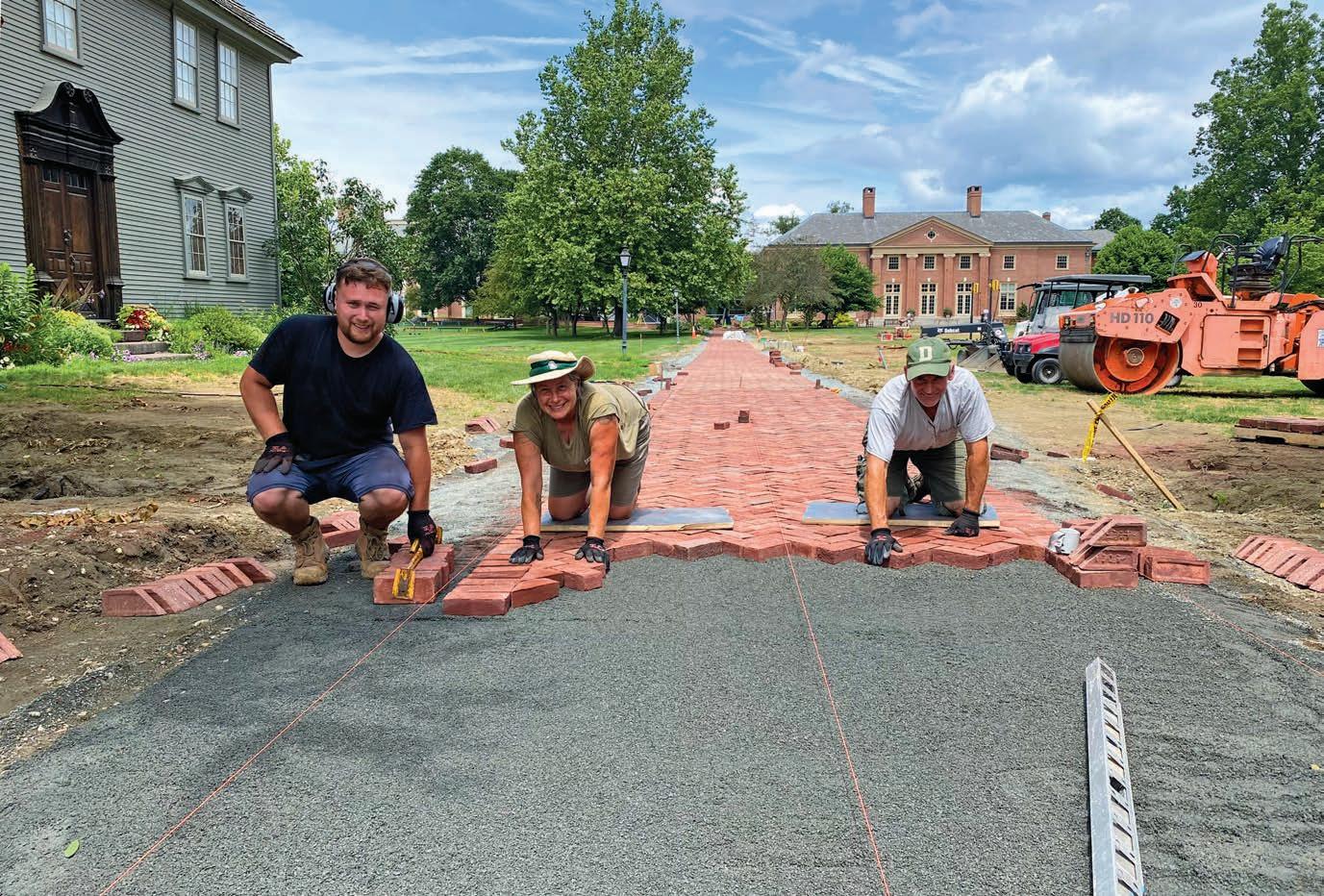





At lunch in the temporary dining hall the other day, a colleague who has never experienced a summer on campus asked, “Is there always this much going on?!” I laughed and told her that while every summer is busy, this year has been extraordinarily busy. And from summer programs to the sounds of construction to the steady work of building and renewal, I am in awe of my colleagues in Deerfield’s Physical Plant, as well as the scores of local workers, who have accomplished so much in such a relatively short time.


The centerpiece of it all—partly because of its location and partly because it is truly majestic—is, of course, the dining hall project. I had an opportunity for a tour recently, and it is stunning in both scope and details, while simultaneously being comfortingly familiar—it is still “the dining hall” but bigger, brighter, better— and I am excited for those first sit-down meals we’ll have this coming January, followed by the o cial dedication in March. If you turn to page 22, you’ll find photos of some additional projects, and for the sake of space, just a partial list of other work completed on campus over the past couple of months.


Summertime here is typically a paradox—a period that is both hushed and humming; a time to reflect and a time to dig into projects; a time to appreciate the past school year, even as we look forward to the next one. We also lay the groundwork—not just in brick and stone, but in spirit—for the new school year, and the culture that, as Head of School John Austin often reminds us, we must co-create anew each fall. And what, you may ask, is the culture that we strive so hard to build from year to year? It’s the rea rmation of our singular community—the shift as we welcome new members, having celebrated our most recent graduates just a couple of months earlier. It’s an awareness and gratitude for those who have gone before us, and it’s a recognition of the goodness of this place and the adults who are dedicated to developing relationships of trust, care, and support with young people.
Admission and Financial Aid Chip Davis reports on the success and future of our remarkable Financial Aid Initiative; and we share an essay from librarian Sean Casey, who along with 13 other Deerfield employees traveled to the Dominican Republic over spring break on a trip previously available only to students, where they worked alongside a Dominican family to build their home (see page 26). Our features, beginning on page 32, not only celebrate our dedicated faculty, but they also highlight Deerfield’s unique approach to academics and to the education of the whole student—an approach that graduates young women and men who are confident, kind, and willing to thoughtfully engage with those they encounter in college and beyond. And finally, in The Common Room section, we celebrate some of those Deerfield alumni—you—who are out in the world, bringing your talents, and knowledge, and joy to every endeavor; I’d especially like to highlight the number and variety of recentlypublished books (see pages 50, 66, and 68)—truly something for everyone.


This issue of Deerfield Magazine follows that summer pattern: in the Albany Road section we share highlights from the end of the school year—most notably Commencement and Reunions; Dean of



I am always hopeful that each issue of Deerfield Magazine is read cover to cover, but I also like to hedge my bets and make an “if you read nothing else” recommendation. That, this time around, is Dr. Austin’s remarks from Commencement—just turn the page and they’ll be right there. Among other things, he referenced a passage from The Headmaster in which Mr. Boyden was marveling at what Deerfield had become, and to quote Dr. Austin: His sense that institutions, like this one, are inspired acts of creation and stewardship . . . His sense that this school exists within an expanse of time and flux and seasonal change. That all of us are a part of something much bigger than ourselves.
I hope you all have had a wonderful summer, and with all best wishes from Deerfield—


Jessica Day Director of Communications/Editor-in-Chief


Good morning, everyone. On behalf of the entire Deerfield community, I am delighted to welcome you to the Academy’s 226th Commencement. I will have more to say about our Commencement speaker, Mr. Henry Kravis, in a moment, but before we begin, I want to extend our warmest of welcomes to you, Henry, and to your family. We are delighted to have you with us on this amazing day.
First of all, congratulations. Most especially to the Class of 2025. These past weeks— with all of their performances, concerts, athletic triumphs, awards, and fanfare—have been an amazing, and most fitting, celebration of your achievements, your leadership, and your engagement—everything you’ve done to create, as classes before you have created, the goodness of this school.
A few days ago, a friend of mine passed along to me an article from the New York Times describing your generation as the “most rejected” ever. Many statistics and lots of evidence followed in support of his claim, including the example of one college student who applied for 40 summer internships—and was rejected by 39.
Its author, David Brooks, is undoubtedly correct that the race for college admissions, for internships, for jobs—even for places in student clubs—has grown more fierce and dispiriting. You face challenges di erent than prior generations, and challenges can certainly take their toll. As Brooks points out, rejection is not a lot of fun. “It threatens,” he writes, “our most important psychic needs: for belonging, for agency, for competence.”
I must say, I found this piece to be head-bangingly depressing. So, what did I do? I went to the theater! To see our most recent theatrical triumph, The Play That Goes Wrong. I know that not everyone here has seen it—it’s a rollicking farce of a play about a hapless community theater group staging a murder mystery. Or at least I think it was a murder mystery. In the end, I wasn’t sure if there was a murder, much less a murderer. In the hierarchy of genres, farce— the theatrical equivalent to Quad Squad—is not the most elevated form of human expression. My trusty AI assistant, Aristotle, tells me that farce is a theatrical form characterized by ludicrous exaggeration, superficial characterization, lewdness, and much spitting. Yes. This production had it all! The liberal arts at its very finest. But farce is also very serious; in the end, it’s about the triumph of ingenuity, playfulness, and inspired improvisation over confusion, setback, and absurdity. Life, we know, is full of farce. Clever seniors replace the head of school’s desk chair with a commode. Spring prom arrives and a rare New England Nor’easter hits. Or, to recall the essential plot elements of The Play That Goes Wrong, the paintings fall o the wall. The set collapses. Duran Duran begins to play. And nobody likes Duran Duran.
So, as I look out at you, I don’t see one of the most rejected generations. I see joy in challenge, resilience in the face of setback, openness and excitement for new adventures. I see all the qualities of spirit and character and brilliance that have made this year such a great one; this community such a strong one, and your class such a decisive and defining one. I see Aviel, arms outstretched, like Samson, holding up a clock and coat of arms; Declan pinning the dog portrait to the wall with one hand while reaching for the phone with his foot. I also see a most fortunate—and blessed—group of students, and if Commencement is about anything, it’s about that—a moment to pause and consider those blessings.
There is a wonderful and easily overlooked moment at the end of John McPhee’s The Headmaster. Mr. Boyden is in his 80s; he’s at the very end of his 66-year career. He stands on the baseball field, not far from here, and he’s about to hit what must be one of his final fungos as coach.
He pauses, looks back at the Main School Building, and says: “Let’s not be boastful, let’s be thankful for what we’ve got . . . isn’t it beautiful? We didn’t have anything for so long that we had years and years to think of what we would like. I go around as often as I can to make sure it’s still there. This is the kind of day when you get the shadows on the hills and the mist on the river.”
There is much to say about this moment since it captures something important and essential about this day. His call for humility—“Let’s not be boastful”— and for gratitude: “Let’s be thankful.” His sense of awe: “Isn’t it beautiful.” The sense of a long journey undertaken and the years and years it took to envision and realize what we enjoy here today.
His sense that institutions, like this one, are inspired acts of creation and stewardship. There is a sense of the stolidity and permanence to Mr. Boyden’s Deerfield, and fragility. Deerfield appears to him almost as a dream. “I go around as often as I can to make sure it is still there.” His sense that this school exists within an expanse of time and flux and seasonal change. That all of us are part of something much bigger than ourselves.
I heard it said recently that gratitude is composed of two separate ideas. The first is a recognition so powerfully expressed by Mr. Boyden those many years ago, is a recognition that there is goodness in the world. The world may be imperfect—the play may not always go to plan—yet there is much goodness to be found in it. The second is that you have been the beneficiaries and the recipients of that goodness and that today, we have much to be grateful for.
So, as I look out at you, I don’t see one of the most rejected generations. I see joy in challenge, resilience in the face of setback, openness and excitement for new adventures. I see all the qualities of spirit and character and brilliance that have made this year such a great one; this community such a strong one, and your class such a decisive and defining one. I see Aviel, arms outstretched, like Samson, holding up a clock and coat of arms; Declan pinning the dog portrait to the wall with one hand while reaching for the phone with his foot.
John Austin, Class of 2025 and The Play That Goes Wrong
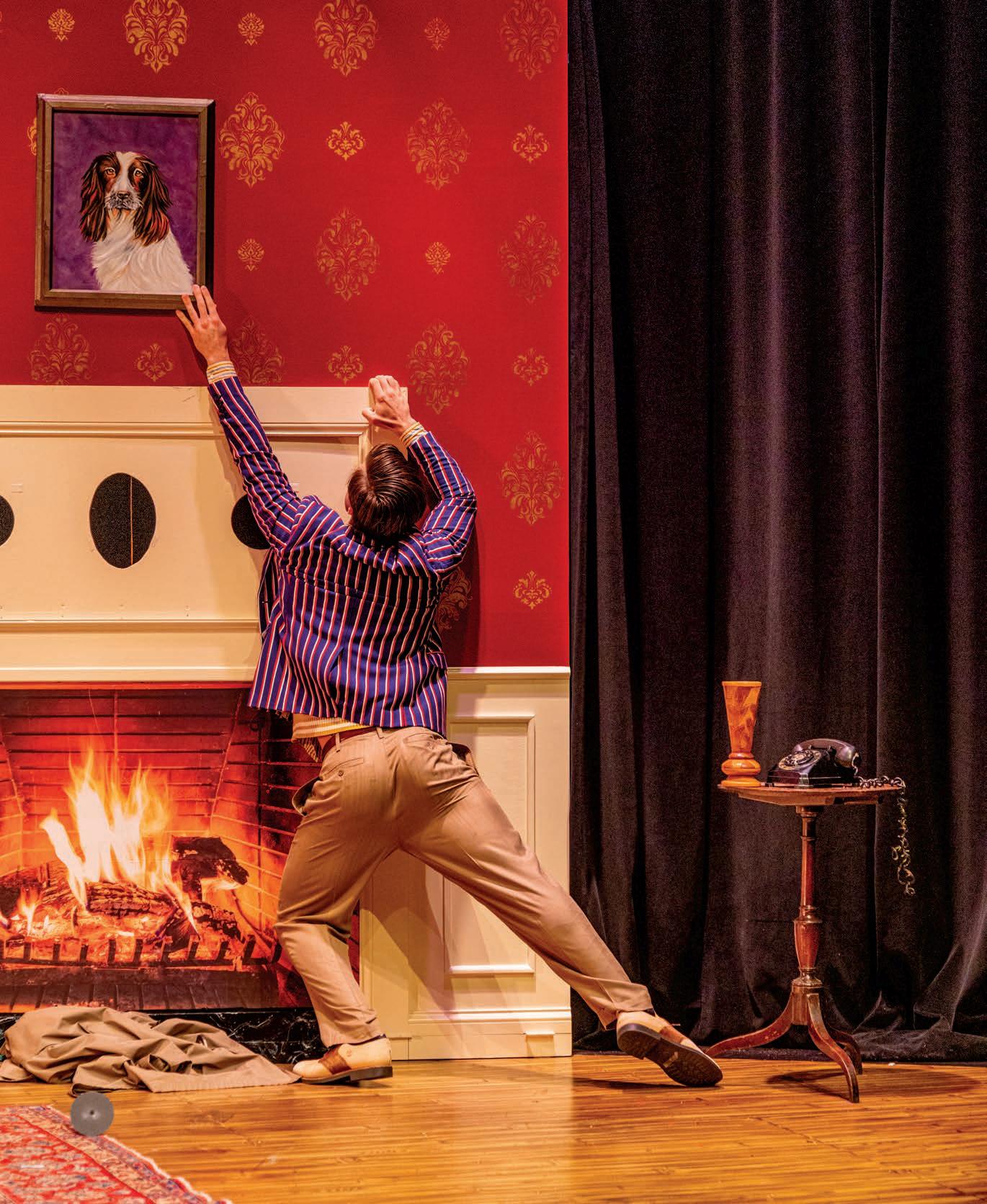
* More of The Play That Goes Wrong on page 10
Let’s not be boastful, let’s be thankful for what we’ve got . . . isn’t it beautiful? We didn’t have anything for so long that we had years and years to think of what we would like.

I go around as often as I can to make sure it’s still there.
This is the kind of day when you get the shadows on the hills and the mist on the river.”
—Frank L. Boyden, The Headmaster

We’re grateful to our faculty—one of whom, as Ms. Govi reminded us, is Mr. Scandling, who retires this year a er almost 40 years of service. To put that in context, that’s roughly 23,000 English classes, 12,000 sit-down meals, 10,000 practices, a few thousand matches, and a lot of chicken pot pie.
My own thanks go out to our Board of Trustees, and especially to our President, Ms. Govi. The collective leadership of our Board sustains our mission and ensures its future, and it’s in good hands.
Our sta . Deerfield is a tremendous team e ort. It flourishes not only because everyone brings dedication and imagination to their work here, but also because they’re willing to go above and beyond, so we’re grateful to all of our sta for making this Commencement Weekend, this year, and this school, possible. Thank you.
We are mindful, as well, that tomorrow is Memorial Day, first observed in 1868 not long after the conclusion of the Civil War. Memorial Day reminds us that the freedoms, opportunities, and Constitutional traditions we enjoy today, and which have inspired so much of the world—bringing to our shores countless others seeking a share of those opportunities hard-fought and harderwon. Let us honor the memory of those who have served this country by striving to lead lives of integrity and purpose, and never take for granted the civic and democratic heritage that binds us together as citizens.
We’re grateful to our faculty—one of whom, as Ms. Govi reminded us, is Mr. Scandling, who retires this year after almost 40 years of service. To put that in context, that’s roughly 23,000 English classes, 12,000 sit-down meals, 10,000 practices, a few thousand matches, and a lot of chicken pot pie. If you could map
that, you would have some sense of Mr. Scandling’s dedication, influence, and extensive presence across this community over the last four decades. And in that way, he embodies the very, very best of our faculty. Thank you, Mark.
Earlier this year we lost a friend and very special member of our community, Dr. Eric Widmer Class of 1957. With his wife, Meera, Dr. Widmer led Deerfield as Headmaster from 1994 to 2006. And together, they founded King’s Academy in Jordan. Meera, it is wonderful to have you back on campus today.
Lastly, I want to thank your families. Our families, and especially our parents, are our first teachers. Your families saw in you all that you were capable of, including having the courage to leave behind the familiar to come here to Deerfield—often from great distance and always with great sacrifice. In spite of how much they knew they would miss you, your families gave you a great gift. I should say it’s not a normal kind of gift—it’s something that you have to make your own and that you have to complete. And you have done that with poise, with spirit, energy, generosity, and creativity, and in a way that I know will inspire the classes below you to follow your great example and continue the cycle of virtue and goodness that you have sustained here during your time. You have led the way, and we are grateful and proud. Keep those paintings on the wall. Congratulations. //
Chloe Xue: Class-Elected Speaker





Kevin Yang: The Robert Crow Award



Kabir Sheth: Class-Elected Speaker & Winner of the Deerfield Cup









Mr. Henry Kravis Keynote Speaker Introduced by Head of School John Austin






On Sunday, May 25, the Class of 2025, 207 members strong, received their diplomas at the Academy’s 226th Commencement ceremonies.
President of the Board of Trustees Leila Govi ’93 P ’26, ’28 welcomed all and noted, “At Deerfield, time moves di erently—we never truly leave. Today may seem bittersweet, but it’s actually just sweet because the friendships you’ve made aren’t ending—they’re lifelong.”
Those themes—lifelong friendships and Deerfield as a unique and extraordinary experience—were echoed by the Class of 2025’s student speakers, Kabir Sheth, who was also presented with the Deerfield Cup, and Chloe Xue, who said: “I am being asked to reflect on my Deerfield experience, to give a little bit of advice, if I may. But there are no new ways to articulate these old truths. There are no friendships like boarding school friendships. I do wish I savored more of the natural beauty e using from this little corner of the Earth. I do wish I got to know many, many people better. This Valley is inexhaustible and so are the people all around you, in all their sublime, human depth. . . A week ago at Baccalaureate, Mr. Scandling quoted one of my favorite poets, Mary Oliver, asking the seniors this: ‘Tell me, what is it you plan to do / with your one wild and precious life?’ Platitude or not, I have always loved this saying, almost making it my senior quote. I love the way it encapsulates the Deerfield experience: wild, untameable, resisting any plan we attempt to impose upon it. At the same time: precious beyond measure, and precious precisely because it is fleeting. I thought that was the point of Oliver’s question, imploring us to seize the moment. . . A few weeks ago, as my friend Edie Hu ard and I discussed poem options for our final poetry circle by the Deerfield River, I finally read Oliver’s poem in full. Upon doing so, I realized that Oliver’s own answer to her question is not quite so grand. Oliver did not speak with the same demanding, ambitious tone that I spoke to myself when I repeated her question, ad nauseum. Instead, she answered that she would spend her ‘one wild and precious life’ paying attention, falling and kneeling down into the grass, strolling through the field, being idle and blessed. The Deerfield experience embodies this essential dissonance. At times expectant, consequential, heavy with history. Then light, undemanding, mundanely beautiful. It’s when we don’t just look to the hills, but also climb them, and then take a second to watch the dappled light, weaving across the river. You cannot have one without the other. Deerfield’s motto, ‘Be Worthy of your Heritage,’ rings with the same dissonance. The burden of a heritage is heavy, but the feeling of self determination, that we get to choose our own heritage, is thrilling, light. //





I spoke earlier of gratitude. I have the honor of introducing our Commencement speaker, Mr. Henry Kravis. Mr. Kravis is the parent of a Deerfield alumnus and, as of today, the proud grandparent of a graduating senior.
Mr. Kravis is Co-Founder and Co-Executive Chairman of Kohlberg Kravis Roberts & Company, a leading global investment firm established in 1976. By any measure, KKR is a phenomenally successful firm, with offices in more than fifteen countries, that holds a singular place in the history of American enterprise.
When he speaks about KKR’s culture, values and philosophy, Mr. Kravis could be talking about Deerfield. He has said, quote, “Education is the cornerstone of unlocking human potential, and its something I believe should be available to every individual, regardless of their circumstances.”
Like a great teacher and mentor, Mr. Kravis implores his colleagues at every level to believe in themselves, and to embrace the joy and strength found in collaboration, and in teaming up with friends to pursue dreams.
“We expect individuals to be good at what they do,” Mr. Kravis has said, “but excellence is not enough. We look for people who are thoughtful about the world around them and the people in it. We look at how they treat people at a dinner table or in a taxi ride, the people they may not see again. You can learn a lot about a person’s character by observing behaviors in everyday circumstances.”
Mr. Kravis has been one of the most successful and respected business leaders in the United States over the past fifty years. He is also one of the most generous and thoughtful. He has supported a wide range of cultural, professional, and educational institutions, including Deerfield and Eaglebrook School, our neighbor, which Mr. Kravis attended as a boy.
His commitment to helping others runs deep. Mr. Kravis once said of his parents, they were “gracious and generous people who cared about others without expecting anything in return.” This is the motivating spirit at the heart of Mr. Kravis’s extraordinary accomplishments and his desire to give back.
I am excited and grateful that Mr. Kravis is with us today, and I extend a warm Deerfield welcome to him.— Dr. John Austin //
A recording of Commencement 2025 may be found online at deerfield.edu/parents/events/commencement

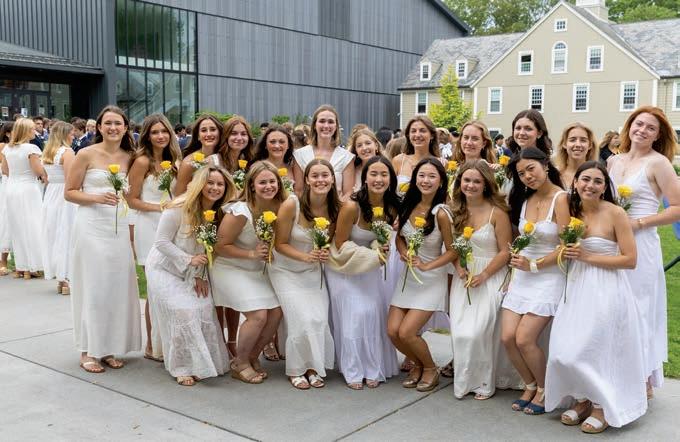


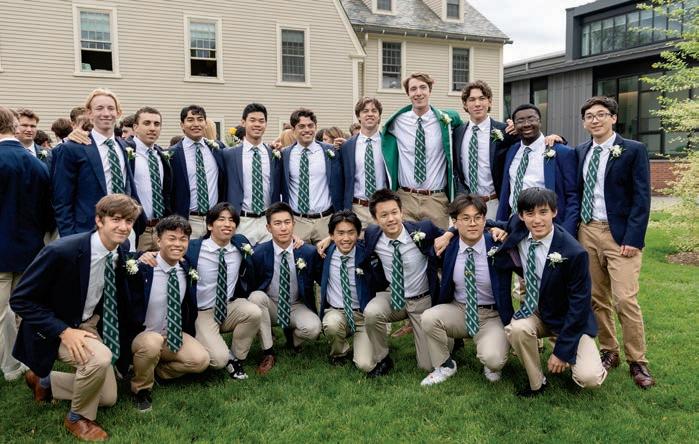
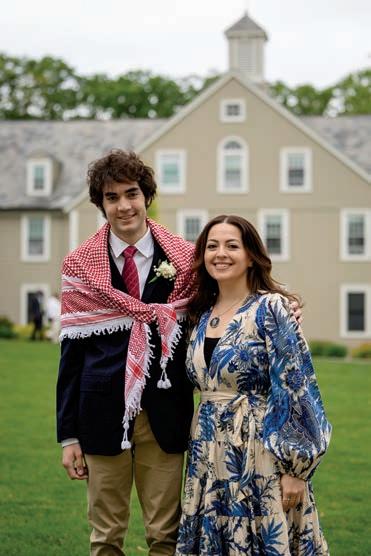

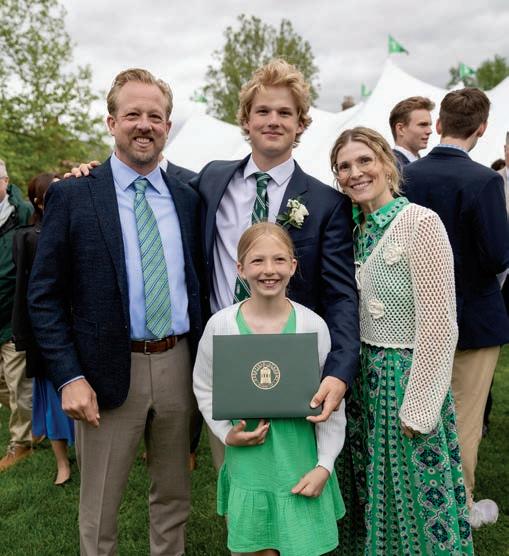

Mr. Eric Goodchild April 5, 1960— July 6, 2025
In gratitude and sadness, the Academy community recognizes the passing of Eric Goodchild, who for three decades piped senior classes down Albany Road and led athletic teams into competition on the Lower Level. He will be missed by all who knew him.
As the Class of 2025 heads o to an impressive list of colleges and universities this fall, the following members will be taking to fields, courts, and water as recruited athletes at their respective institutions. We wish all members of the class great success, and welcome updates on athletic and academic achievements in the coming years!
Aiden Barclay / Cornell University
Caleb Allen / Bentley University
Connor Niemiec / Cornell University
Jackson McBride / Bates College
Jake Kavanaugh / Bowdoin College
Tate Bannish / Tufts University
Tripp Woytowicz / University of Richmond
Cam Umlah / Babson College
Allie Corrieri / Colby College
Campbell Krotee / College of the Holy Cross
Tommy McMahon / St. Lawrence University
Caden True / University of New Hampshire
Charlie Smith / Bucknell University
Cole Geer / University of Virginia
Hawk Okpokwasili / Brown University
Jake Phelan / Stonehill College
Liam Appleton / Brown University
Mack Mrowka / Brown University
Rhys Polcari / Pomona Pitzer College
Walker Adams / Colby College
Willem Thurber / University of Virginia
GOLF
Gunnar Moore / Hamilton College
Atticus Oliven / University of Michigan
Blake Donnellan / Haverford College
Braswell Vachon / Union College
Brayden Lahey / University of Virginia
Connor Coutu / Marquette University
Justin Tavares / University of Denver
Liam Appleton / Brown University
Matthew Johnson / Georgetown University
PJ Haskell / Tufts University
RJ Radonis / Rutgers University
William Wright / Boston University
Ginger Bernstein / Stanford University
Emily Bruno / Georgetown University
Barron Celli / Stanford University
Ben Sackrey / Tufts University
Griffin Haisman / Massachusetts Institute of Technology
Jackson Violich / Harvard University
Pierce Lapham / Harvard University
Zachi Wood-Davis / St. Lawrence University
Anna Ogborne / University of Southern California
Elizabeth Kelly / University of Virginia
Emi Takegami / Yale University
Fiona Van Nice / Georgetown University
Mary O’Shea / University of Notre Dame
Melinda Aznar Klein / Boston College
Tatum Lowe / Dartmouth College
Chase Collins / Duke University
Ellie Schiller / Babson College
Olivia Smit / Yale University
Christian Capella / Harvard University
Daniel King / Cornell University
Giulio Migliarina / Carnegie Mellon University
Alex Hermsdorf / Colby College
Cai Harrison / Bowdoin College




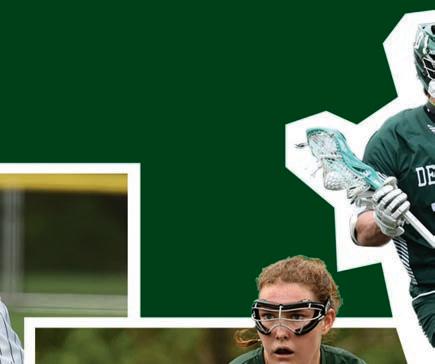




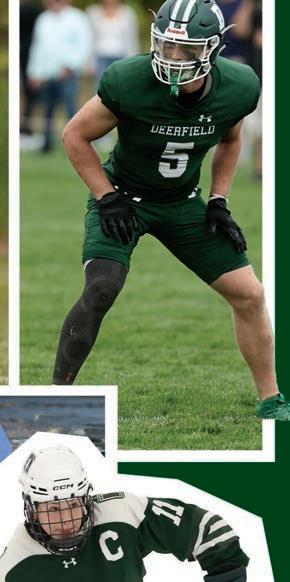

SCENES FROM THE ONE-ACT PLAY THAT GOES WRONG (Falling) Off-the-Wall Fun This Past Spring


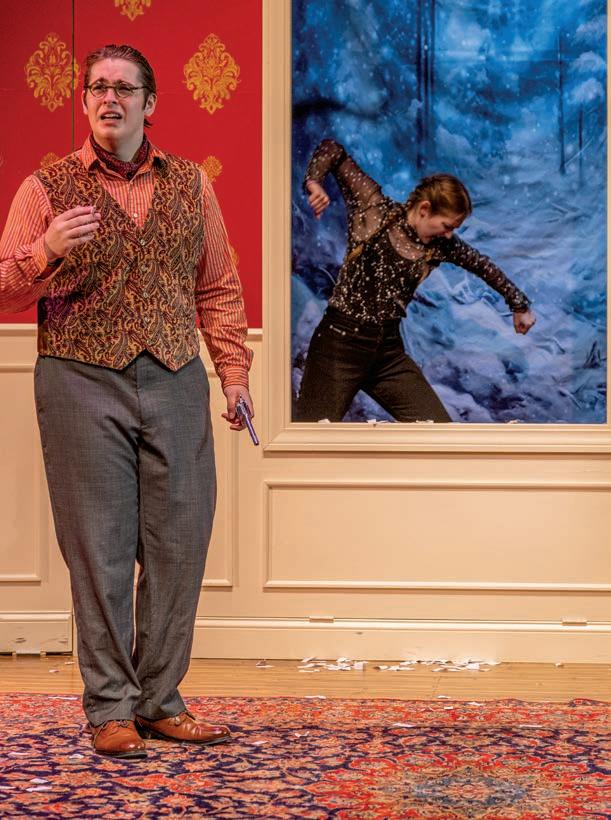


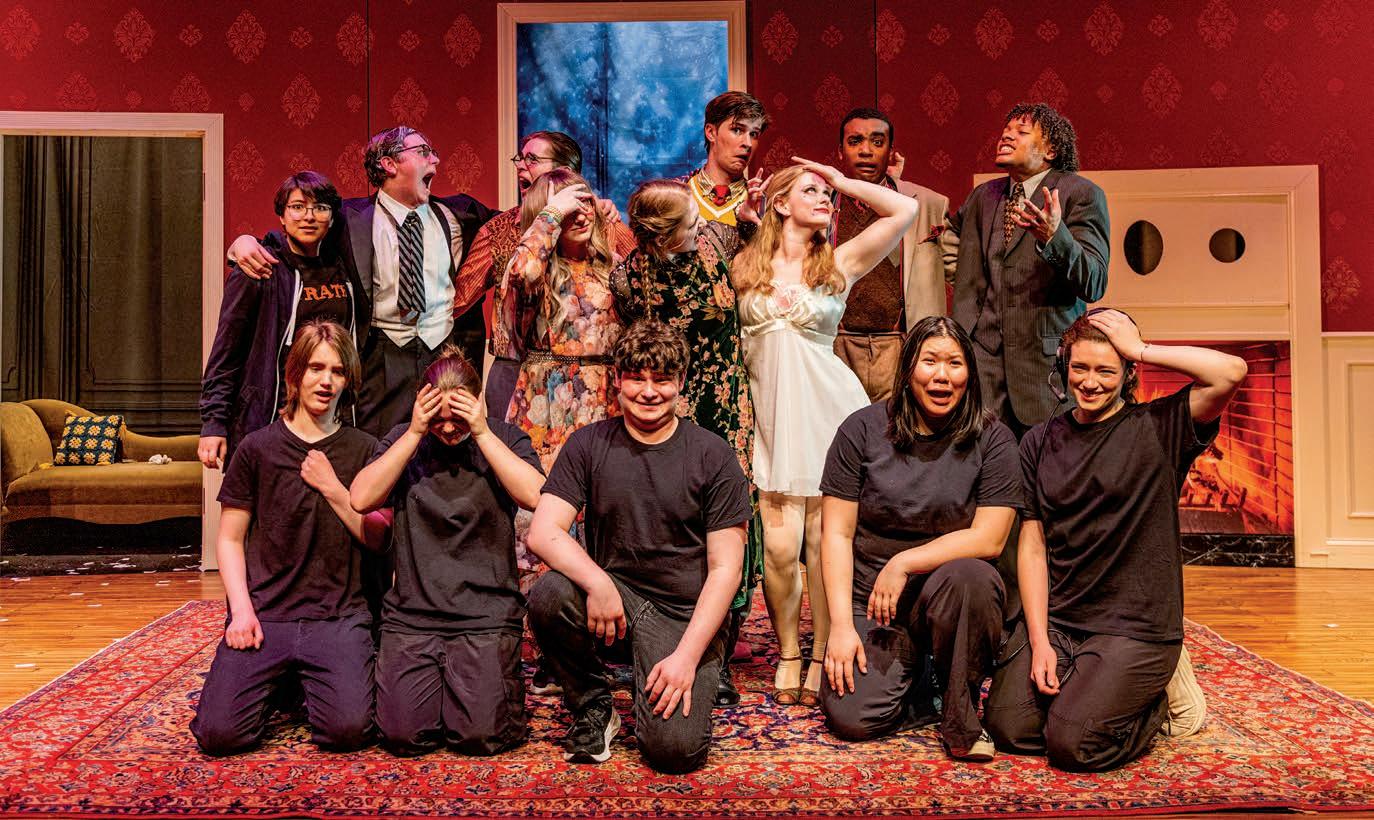
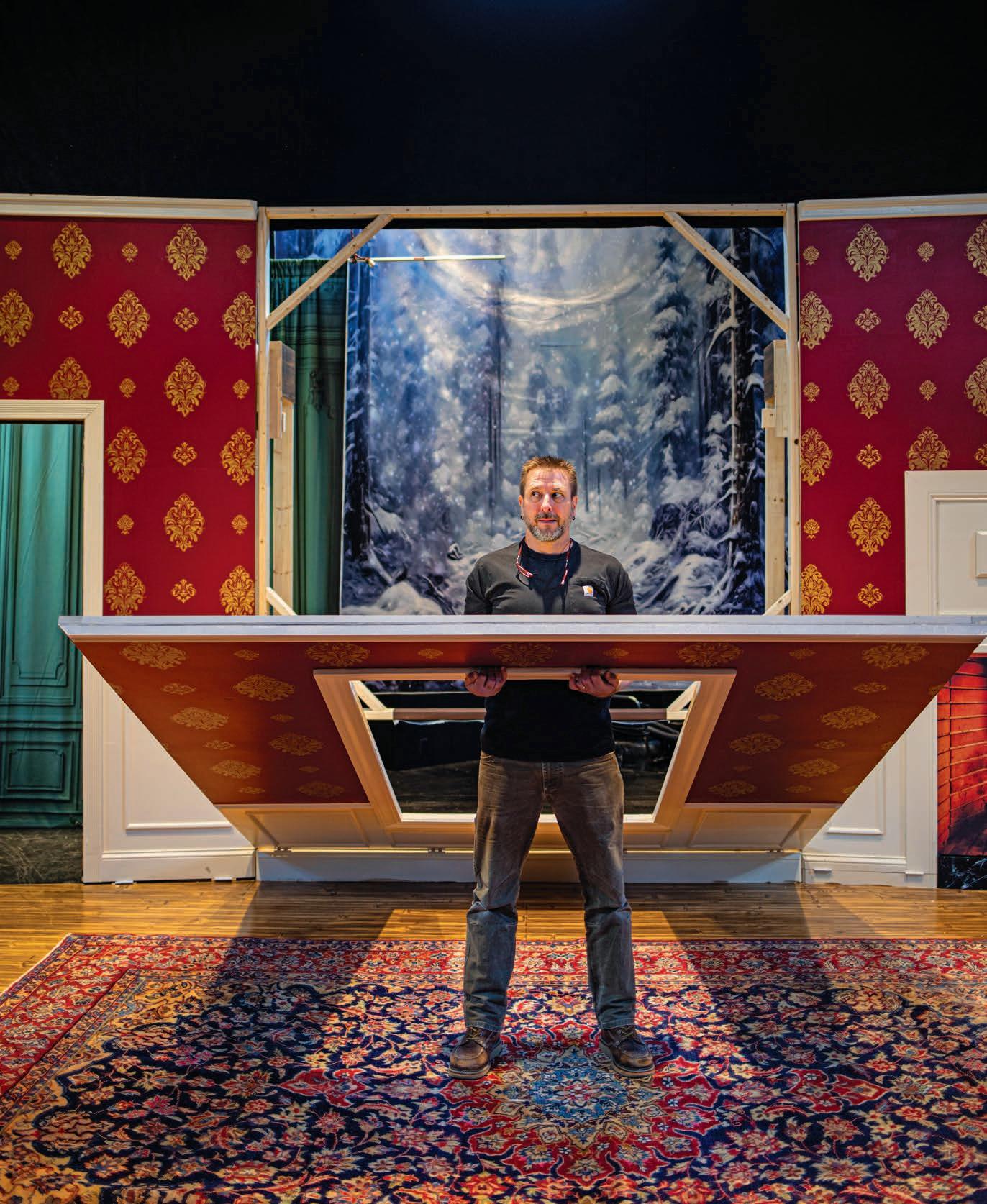
On a whim, musician Rick Mauran decided to try his hand at acting. “My personality was pushing me to be more than a drummer behind a drum set,” recalls Mauran, Deerfield’s current Technical Director and latest addition to the Visual and Performing Arts Department. So, one evening in the late 1980s, young Mauran wandered into the New Britain Reparatory Theatre to inquire about acting classes. There were actors gathered for a rehearsal and people in the audience when Mauran was ushered onto the stage by an enthusiastic director who assumed that he had meant to audition. “Get up on the stage. You can be a Shark,” commanded the director. “As I approached the stage, I thought to myself, ‘I’m not wearing some rubber costume,’” says Mauran, who subsequently learned that “Sharks” were in fact a street gang in West Side Story. He was cast as a member of the chorus.
Over a few years, Mauran performed in a string of productions where he would also help with set construction. For his last performance in his home state of Connecticut, Mauran played the dentist in Little Shop of Horrors, whose character also plays seven other characters. “This was an absolute thrill for me and made me imagine what it must be like to be on SNL,” says Mauran, a known prankster whose colleagues and students are ever appreciative of his “delightfully mischievous” sense of humor. Though this production was almost cancelled when the producer decided that renting the necessary puppets would break the budget, Mauran was able to save the show by constructing the wooden puppets himself. By the time the play wrapped, Mauran was convinced that acting was the thing that he wanted to do, and at the close of summer, he auditioned for the Boston Conservatory at Berklee. Though only one student was accepted that year, Mauran packed his bags and moved to Boston anyway at the age of 24 without a single job prospect on the horizon.
“You just have to go for it,” says Mauran, who learned at a young age the cost of supplanting one’s own dreams for those others put in their place. “Don’t listen to the voices around you. Just listen to that inner voice and go for it.” He had dreamed of studying at the Berklee School of Music in high school, but without the support that dream was placed on hold. “With no support,” says Mauran, “I decided college wasn’t for me.” An irony, considering Mauran has now spent much of his life teaching college students—at Boston Conservatory, Wheelock College, and Mount Holyoke—before coming to Deerfield. (He later enrolled at Berklee School of Music, graduating at the age of forty.) Undeterred by













































numerous rejections, Mauran eventually landed roles in community theater, and using the income from a restaurant job, he was able to fund dance, voice, and acting classes and catapult himself into some great roles as a working actor, eventually becoming a member of the Actors’ Equity Association (a union representing American actors and stage managers working in theater). Within a couple of years, Mauran learned that Boston Conservatory was hiring for a master carpenter: “I had carpentry skills and a keen ability to think outside the box, but master carpenter? Why not?” He landed the job, and a year later he was promoted to technical director.
“My philosophy in all things is: Yes,” says Mauran, who tries to encourage students to take chances, noting that young people oftentimes have a fear of failure that can overwhelm them. “It’s easy to lead with ‘no,’ but I tell them to just say yes and figure it out; there’s nothing that’s so critical that I can’t fix it.”
Along with his comedic timing, colleagues appreciate that they really can count on Mauran to figure anything out, rallying around his inspiring, can-do attitude. “Rick is a natural teacher, leader, and someone who always starts with a ‘Yes! Let’s figure it out,’ ‘Let’s give it a try,’ and ‘Oh, that should be fun to do!’ Regardless of the obstacle, Rick is going to give it his all,” says Peter Hynds. Chair of the Visual and Performing Arts Department Catriona Hynds agrees: “Nothing is insurmountable or too onerous for Rick.”
The “Dream Team” is complete with Mauran as the new addition, observes Costume Designer Karen St. Pierre, attributing much of their recent successes to Mauran’s “willingness to look at all the possibilities and collectively open the conversation with a ‘yes.’”
An “ambitious scenic designer” is how theater teacher Lori Holmes Clark would describe Mauran. Lily Pierce ’25, who starred as Eurydice in the winter play, and who also worked on the technical team for a subsequent production, found all the sets Mauran created in his short time at Deerfield to be remarkable: The seating banks that enclosed the Black Box, complemented by the addition of living trees, which enveloped the set for an immersive viewing experience; the transformation of the Black Box into an underworld, complete with a “raining elevator” operated by a functional water pump; a set that literally collapsed in on itself. “It truly felt like such a privilege to get to perform on a stage and on a set like that,” says Pierce. The viewer’s experience of the space underpins everything, a point Mauran tries to drive home to his students: “One of the things I ask on the first day [of class] is ‘Who is the most important person in the theater?’ And I get—‘the director’ or ‘the producer’—those types of answers. Then I point out that it’s the person buying the ticket, the person sitting in the seat. If we’re not serving them, there’s no point in what we do.”//
/// by Chip Davis, Dean of Admission ///
We had just returned from winter break last January, and that Monday we’d decided to give our student tour guides a day to reacclimate to their campus, their friends and their classes. In the Admission O ce, we call it a Zoom-a-thon, where we convert all our interview appointments to virtual ones. I had two interviews before the morning faculty meeting, and I was pleased to first meet a 10th grade applicant from Lincoln, Nebraska. When I asked, “So how did you find Deerfield?” he answered, “Well, my mom was reading the Wall Street Journal one day last fall, and saw the article announcing Deerfield’s new financial aid initiative, and we decided to explore it.”
Cool! Nebraska is not exactly a major market for New England boarding schools, and we had a terrific conversation. Forty-five minutes later, I was in Grinnell, Iowa, with a second impressive candidate who also referenced the WSJ piece. As I skipped o to the faculty meeting (actually, I don’t really skip), I thought to myself, “The eagle has landed!” And just two months later, we’d admitted both applicants; one of them will be here for the start of school this fall.
This summer, Deerfield launched a partnership with the STARS Network Boarding School Initiative to identify and recruit students across Middle America in underrepresented communities, in an e ort to reach new candidates at the scale of my fortuitous morning last winter. It’s a timely venture for DA, as we seek to sustain—and grow!—our reach to deliver on the Academy’s pledge to a ordability and access, now a year into the initiative.
It was Head of School John Austin who tapped a few of us to assemble an Access and A ordability Task Force “to advance our campaign planning and to explore and define Deerfield’s future commitments to financial aid and scholarships.” Everybody loves a good task force, right? Amongst the few I’ve served on, this one had high impact potential and felt promising from the jump, and last year, following a presentation to the Board, we helped to set the table for the articulation of the Academy’s goals regarding financial aid with a second task force led by Chief Financial O cer Matt Sheehy, Controller Greg Rolland, and Senior Investment and Financial Planning Associate Dylan Korpita from Finance, Director of Communications Jess Day, and Melissa Persons, our Director of Financial Aid.
The goals were clear, as was the resulting proposed initiative:
1 become a leader in affordability in secondary education;
2 modernize the Boyden legacy of “pay what you can;”
reach new talent in new markets;
4 reframe, simplify and clarify the cost of Deerfield using income markers:
• Qualifying domestic families with inco e p to 150 000 will pa 0 for tuition and fees;
hose with inco e a o e 150 000 will pa no ore than 10 o their income for tuition and fees.
To qualify for the initiative, a family must apply for financial aid as part of the admission process, live and work in the United States, and have two years of verifiable W-2 inco e with assets consistent with their income profile. Families who do not meet these criteria remain eligible for within the standard methodology of Deerfield’s financial aid process.
TO READ MORE ON ACCESS AND AFFORDABILITY: deerfield.edu/admission/financial-aid

Following approval from the Board, we launched the Financial Aid Initiative this past admission cycle. Nobody has perfect predictive powers, and the data surprised me to an extent. I’d envisioned that we would attract additional higher income families who fell just below a tuition-capable level but could now a ord the boarding value proposition versus their competitive local options. In fact, this is not yet the case. Although the number of applicant families seeking financial aid rose by 18 percent from the prior year across the broad income spectrum, the biggest impact for newly-enrolling families is in the “zero pay” cohort (under the initiative, domestic families earning $150,000 or less); that number of families now constitutes 12 percent of the Academy’s population and 30 percent of the overall cohort receiving financial aid. That is powerful. We now seek to broaden our impact across the income ladder.
One of the lessons my father most impressed on me at a young age was the power of compounding. What I learned later as CAGR (compound annual growth rate) in my classroom days was already cooking in my head through the Rule of 72 formula (70, if you must). This cuts both ways. If one is saving/investing and locks in a rate, you can see the finish line for your doubling asset with anticipation. If one is spending, the power of any expense doubling is daunting. Our new commitment to truly address a ordability keeps the deliverable of a Deerfield education in view and in reach for more families, and it will ultimately help us assemble the most talented student body we can find.
The Academy has spent the last decade compounding its investment in financial aid. Just ten years ago our financial aid budget was under $10 million. We supported 226 students, 35 percent of our school. We project that in 2025-2026 we will spend $16 million supporting
250 students, 38 percent of our school. As we’ve worked to admit the best students for Deerfield, in this same timeframe, we’ve increased our support of international students, growing that population from 6 percent to 14 percent of our total financial aid recipients. We hope that the new initiative will have this same e ect on diversifying our domestic population and creating more opportunities for students in under-represented states.
Make no mistake, we have made strides in just a short time. And I look forward to feedback from future DA alums, but as I reflect on our year-one results, I can see we’ve already achieved some of our goals:
• To reframe and simplify the concept of financial aid for prospective families, leading with a message of affordability and access;
• To appeal to families who may not have been considering private education;
• To showcase our programs and the intrinsic value of the Deerfield Experience.
In response to the WSJ article highlighting DA’s initiative, one commenter reflected on his own experience, 68 years prior, as a “hopeless hayseed . . . but a recruiter was coming to town (in this case Memphis) to promote a boarding school education with geographical diversity.” The author shared gratitude for the Northeast boarding school experience that followed, saying, “it changed my life dramatically.”
Today, here at Deerfield, it comes back around, and we are reminded of Mr. Boyden’s o er to so many families to “pay what you can.” Now it is our turn to be the recruiters and life-changers across our country. //
ALBANY ROAD / ANATOMY OF AN OFFICE
Alumnus, Senior Associate Director of Admission, Squash Coach, and Senior Class Gauntlet Leader! Here are a few of Mr. Briones’ favorite things in his Main School Building o ce:













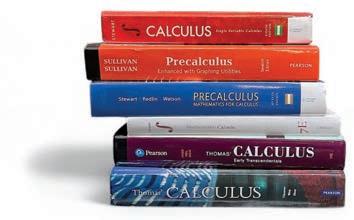



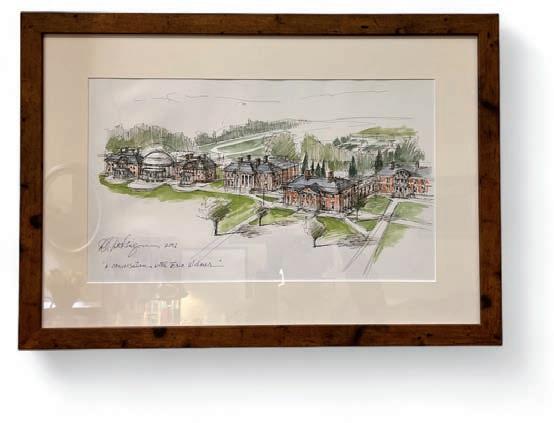
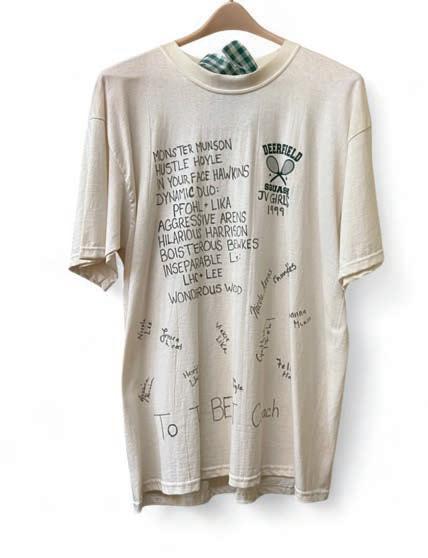
1 Antiquity Lotus flower tile A.D. 8-9th Century
2 Commencement Hat and Megaphone
3 Academic at heart... That’s a LOT of math, Mr. Briones!
4 Fine art Classic New England original: Allen Hale Johnson American, 1937-2022
5 Worthy of his Heritage
6 JJ the “AO” (Admission Officer) “Top Performer 2018”
7 Hodo connection
JJ was a student during artist and teacher Dan Hodermarsky’s time, and was even the subject of a few sketches by Hodo, the master himself (not pictured, but also on display in JJ’s o ce).
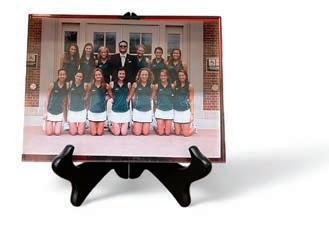
8 Dickinson connection A watercolor of campus by retired faculty member David Dickinson is one of many pieces adorning JJ’s o ce walls.
9 Coach (back in the day) JV Girls Squash
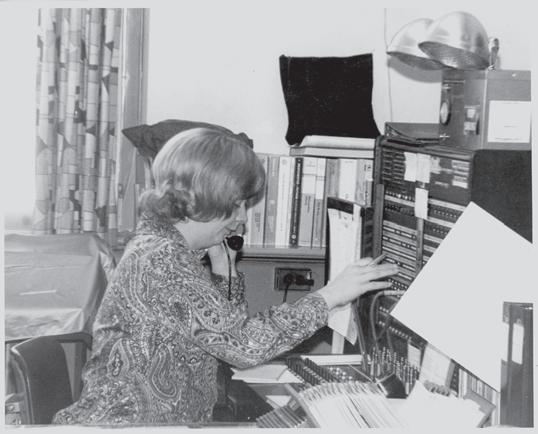
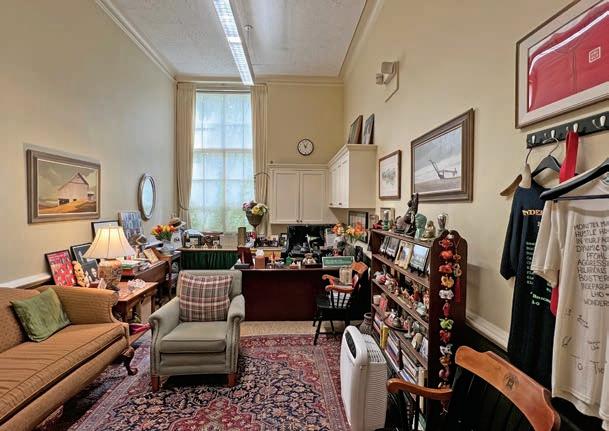

/// by Daniella Vollinger ///
In the summer of 1995, Mike Silipo reluctantly accepted an invitation to interview for the football coach position as a courtesy to a former Tabor colleague who was then working at Deerfield. Silipo was not looking to leave Tabor—he had a home in town, a business, a great football team, and about 27 years under his belt at the school. “I wasn’t looking for a job, and so I was pretty frank [in the interview],” says Silipo, recalling how, as he was getting in his car to leave Deerfield’s campus, then-headmaster Eric Widmer grabbed him by the arm. “He said, ‘Hey Mike, the only job I’d ever get involved in hiring for is the football coach because I played football at Deerfield and it changed my life.’ I said to myself, ‘I gotta work for this guy.’”
At that time, Deerfield needed a football coach, squash coach, and history teacher, and Coach Silipo checked all the boxes. “It was just the stars aligning in ways that you can’t imagine. And I’ve had a great run here,” he says. Although he retired from teaching history in 2017 and had already handed o the football program by then, Coach Silipo continued as the squash coach, the post from which he is now retiring, closing out a thirty-year chapter at Deerfield.
The fact that Coach Silipo’s career spans almost six decades between two schools makes him a unicorn. During Reunion Weekend, he heads to Tabor on a Friday and makes it back for Deerfield’s Saturday festivities. “The kids come back and what they remember are the things that you did—something that you did that may have changed their life or a ected it somehow. And I love that part of it,” says Coach Silipo. “That’s the profit in this business, I think.” Seeing Coach’s prior students and players in one place, gathering around this central pillar they share from their Deerfield days, spanning across decades, is a remarkable thing to witness. “It’s been amazing to meet friends whose dads played for Coach and to experience the true breadth of his impact,” former football captain Zeke Emerson ’16 observes. “His commitment to me and [our team] was unmatched,” adds former player Drew Philie ’09. “He told me he loved me all the time.”
of whatever they were doing.” As a former college football and baseball player at Hobart, Coach Silipo modeled a winning work ethic for his players, and everyone knew he liked to win. “Coach was a constant example of what hard work means. I knew he had my back, and I appreciated how he pushed me to be the best version of myself,” continues Philie.
Silipo thinks that perhaps the biggest challenge young people face today is the role that social media plays in their lives. “I’m not much of a computer guy or social media guy, but I think the social media stu has really a ected the kids. They’re on their phones and they know what’s going on here, there, and everywhere.”
Finding a balance in the space between childhood and adulthood, determining what is healthy and appropriate to consume, and in what quantities, is a challenge for society now. Instead of doomscrolling or endlessly looking at what one’s peers are doing, Coach Silipo suggests a time-tested method with an Odyssean origin: Find a mentor (just not in the true sense of the word as the ancients understood it).
Being a mentor is also a maturing experience that should not be taken lightly. “I can honestly say there was no better mentor in the school. I learned so much from Mike—not just football and coaching in general—but most importantly, I learned how to be a loyal colleague, a good friend, and parent!
“I encourage kids to seek counsel when they need it. I always had mentors that I could go to,” says Coach Silipo, who made a point of seeking out mentors who were further along (even just a year or two) on a certain path. “I’d say to myself, I want to know what he knows.”
Being a mentor is also a maturing experience that should not be taken lightly. “I can honestly say there was no better mentor in the school. I learned so much from Mike—not just football and coaching in general, but most importantly, I learned how to be a loyal colleague, a good friend, and parent!” says colleague Toby Emerson. Dean of Admission Chip Davis, who spent many years teaching history and coaching alongside Silipo, was witness to many a life transformed through Coach’s humble approach in the classroom and on the field: “[Coach Silipo] was a far better classroom teacher than he ever gave himself credit for, and he has fulfilled his purpose in life: To mentor young people.”
With decades of insight into the adolescent mind and having witnessed generations of graduates launch—Tabor’s class of 1968 being the earliest cohort—Coach Silipo o ers some advice for modern parents: Don’t make it too easy for your kids and don’t play the fixer.
“No one will be there fixing their problems in the future, and nobody’s going through life undefeated, that’s for sure,” he asserts. As a coach, he encouraged his players to develop resilience and accountability. “I wanted my teams to stand on their own two feet and take ownership
Coach Silipo is not riding o into the sunset. The Silipo family home is only a few miles away from campus, and Coach’s wife, Lydia Hemphill, continues to teach at Deerfield. When he’s not making an appearance on campus, you’ll be sure to find Coach Silipo working in his South Deerfield woodshop on any number of projects—from building furniture to carving toys for any one of his six grandchildren. “I’ve been very lucky,” he says. “I’m a homebody kind of guy. I like being close to Deerfield so I can go in and see people. I don’t need to travel anywhere.”//







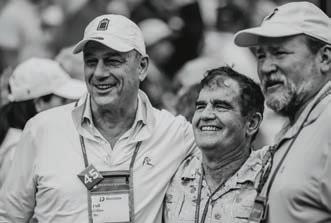
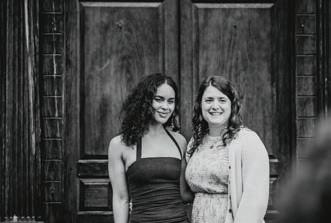
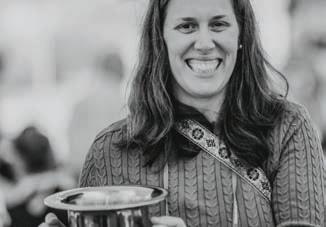

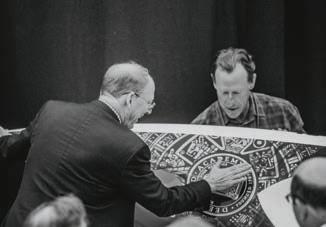

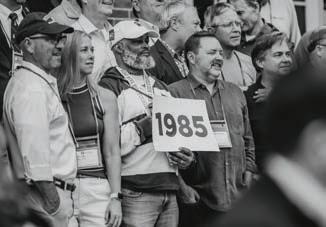
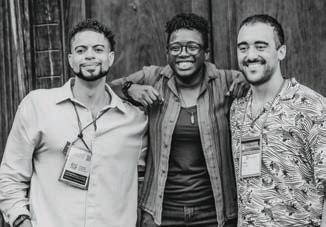
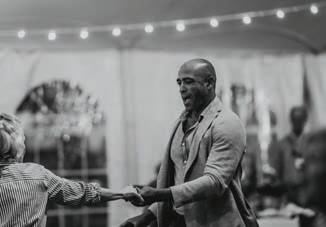


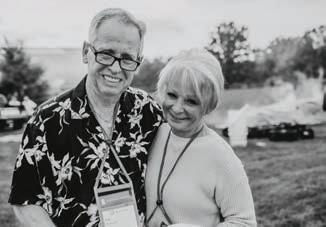

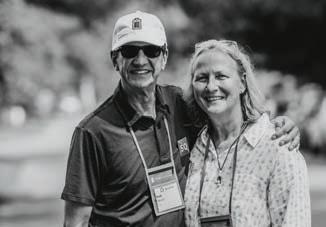





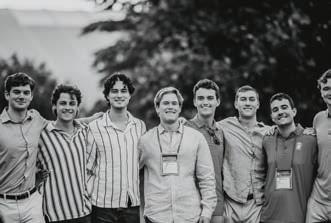







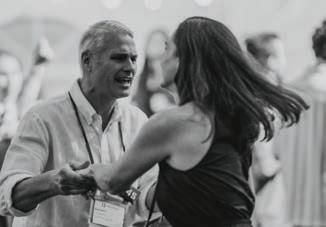




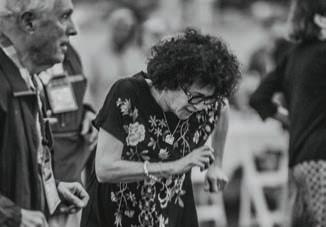
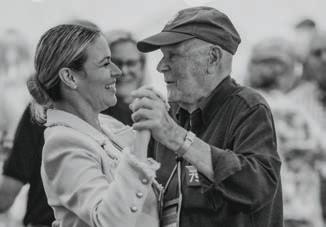








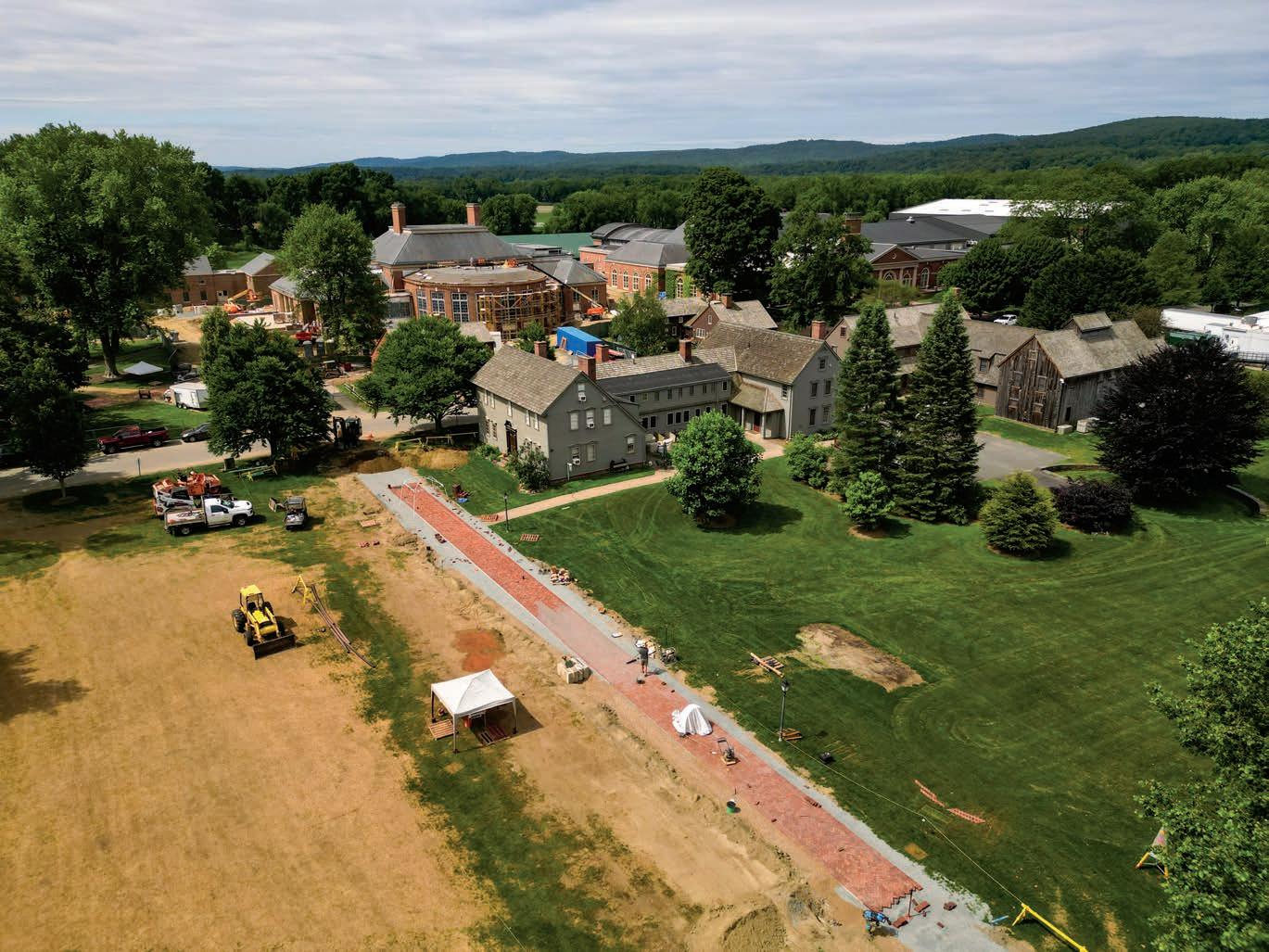
SUMMER CAMPUS UPDATES


It seemed that everywhere you looked this summer, something was being built, painted, or repaired on campus! Even with all the commotion, summer programs including The Experimentory and the Deerfield Academy Summer Arts Camp (DASAC) were enjoyed by more than 250 students, and when the Classes of 2026, 2027, 2028, and 2029 arrive beginning on August 25, with few exceptions, the projects will be complete and residential and academic buildings alike will be ready and waiting for the new school year. When students return from winter break in January, 2026, they will enjoy the first ever sit-down meals in “The Brick”—the Academy’s new dining hall—which will be o cially dedicated in March, 2026.
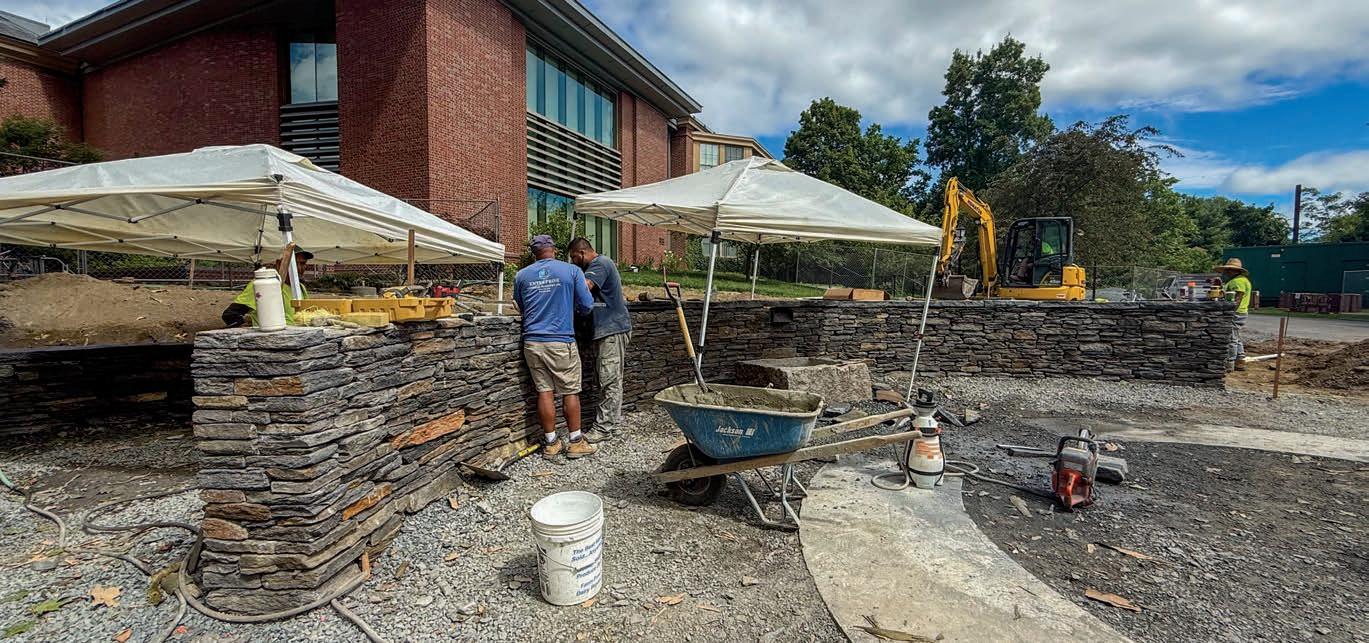


West Campus Dorm preparations

<<< Brooke’s Garden, in memory of Brooke Emmens Gonzalez ’97, adjacent to the Arms Building and the Hess Center, was completely refurbished. It now features a new granite bench honoring faculty with 25 or more years of service, a stone wall honoring members of the sta with 25 or more years of service, a bubbling water feature, and beautiful new plantings.
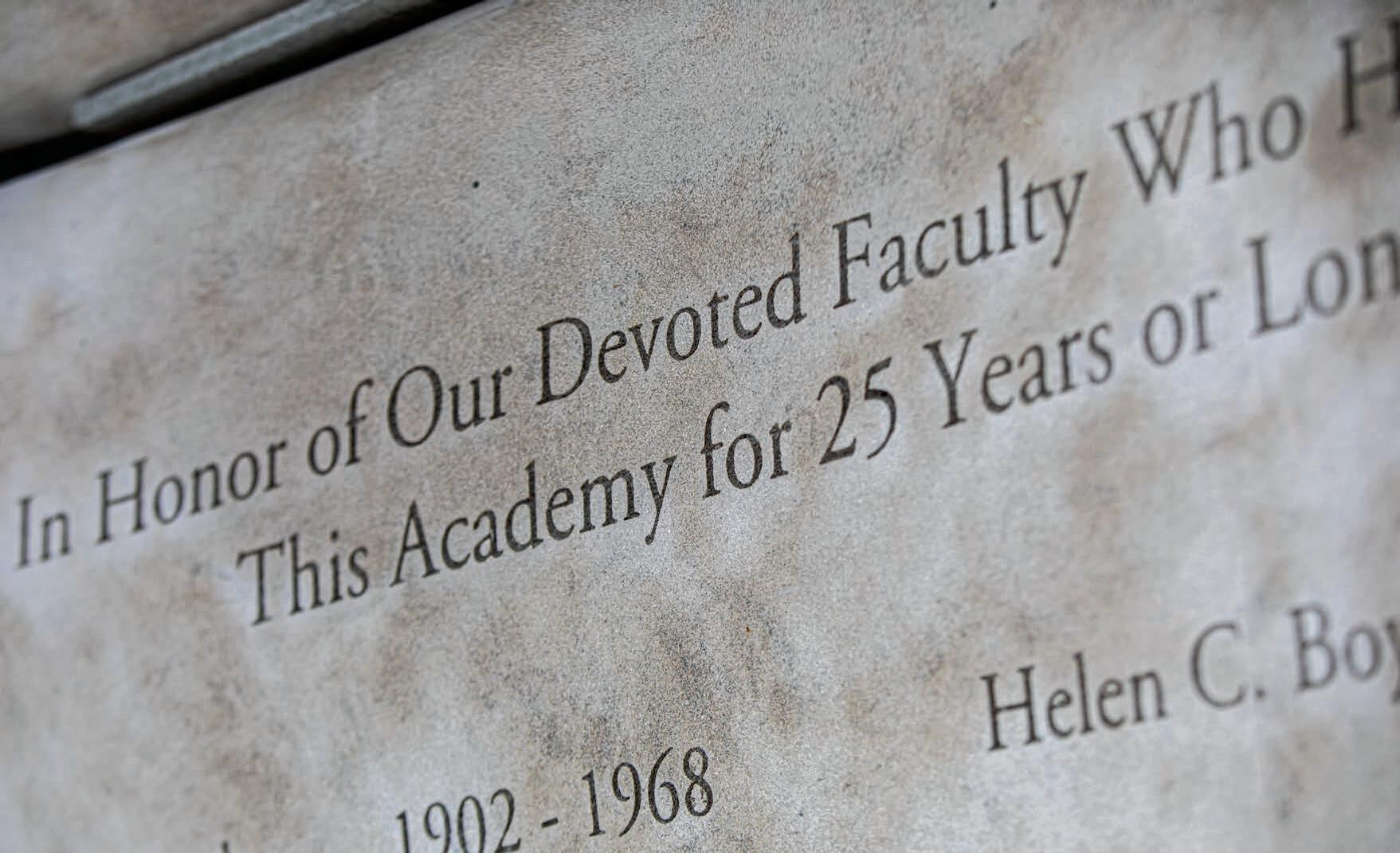
PA R TIAL SUMMER PROJECT LIST
Early Learning Center / expansion into Stockade House
Hess / roof
Pool / roof + replace lockers
Squash Courts / fresh carpet
Kendall Classrooms / common areas refresh
Stoltzfus Room / refinish wooden floors
Fitness Center / freshen wall paint
RoSho and DeNunzio Dormitories / crawlspace ventilation
Hitchcock / chimney rebuild
New Brick Sidewalks / Flagpole to Albany Road
East side of campus / water line replacement and looping
Scaife/Mather quad / refresh landscaping
Old Albany Cemetery / treework
New fryolators / Greer Store kitchen
Supplemental hot water system / DeNunzio
Koch Center / lighting retrofits in all rooms
Power washing / walks and stairs across campus
Carpet steam cleaning / all dorms
Prepared 20 houses and apartments for faculty families
Prepared hundreds of dorm rooms for Reunions and summer programs, and then again for returning students
Keyless access controls installed at Main School Building and Hess front doors
Harold Smith Dormitory / upsize rain gutters
Carpet replacement / Barton Dorm
Expanded Shipping and Receiving / package locker capacity
+more!

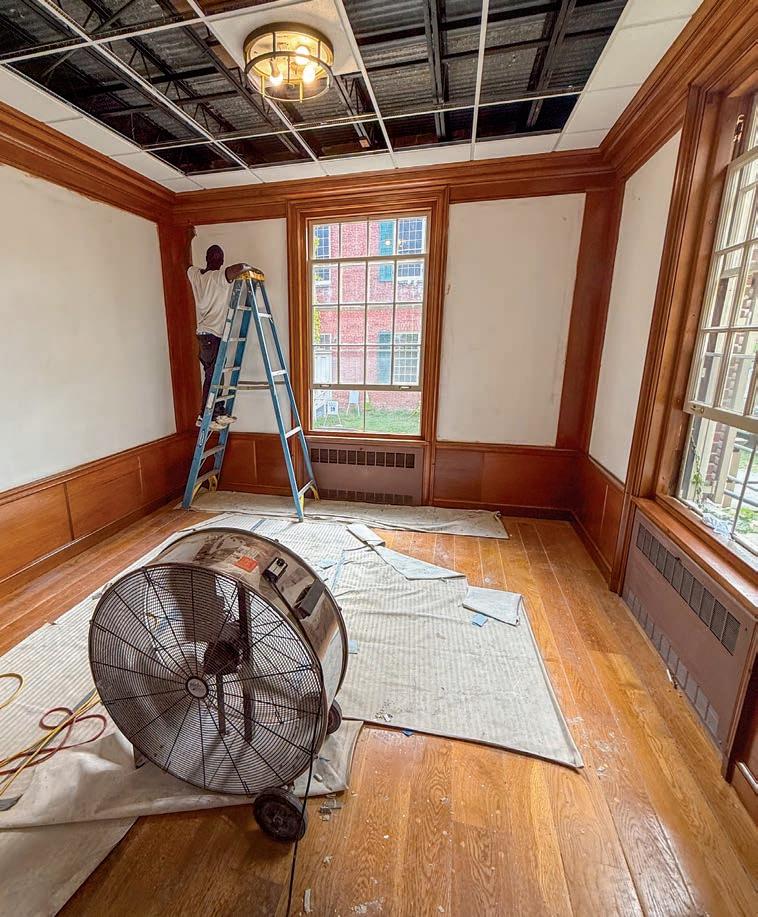
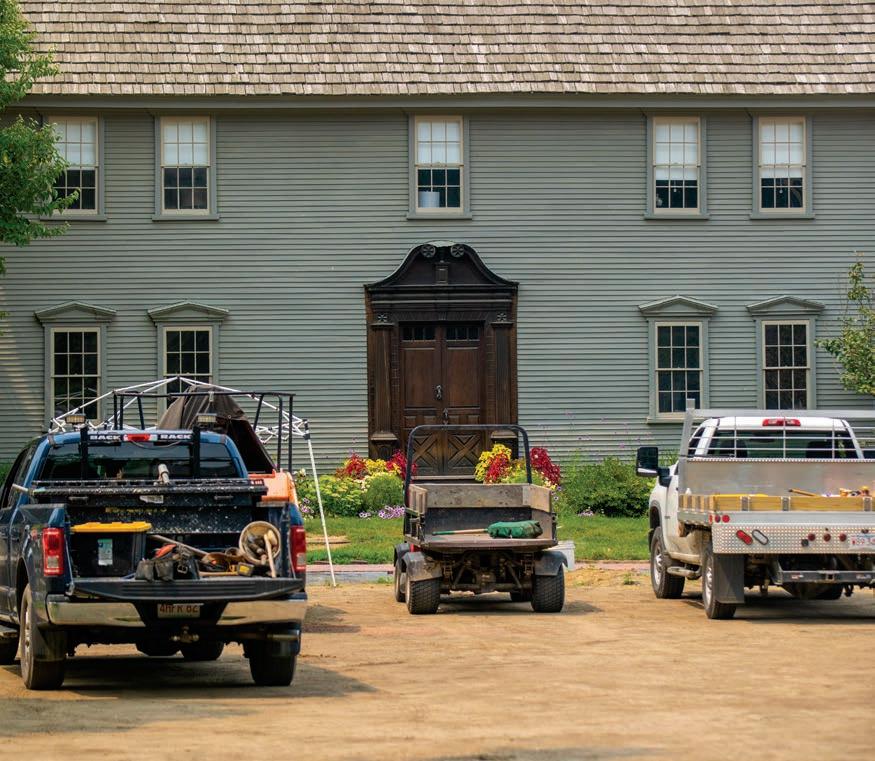

Completed the renovation of Arms Barn (adjacent to the turf field and Routes 5/10), which will be used for the storage of athletics equipment and other supplies.


And through it all...FLOWERS!!
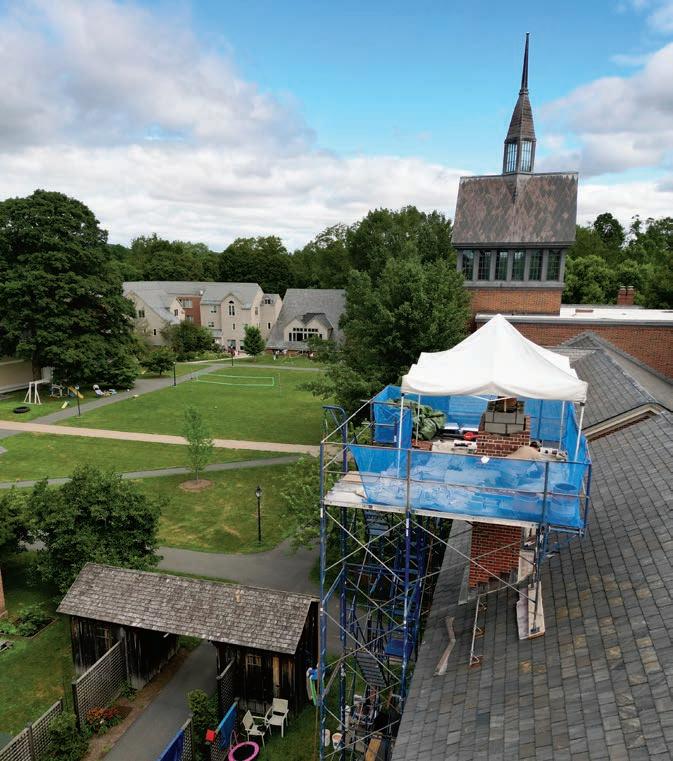
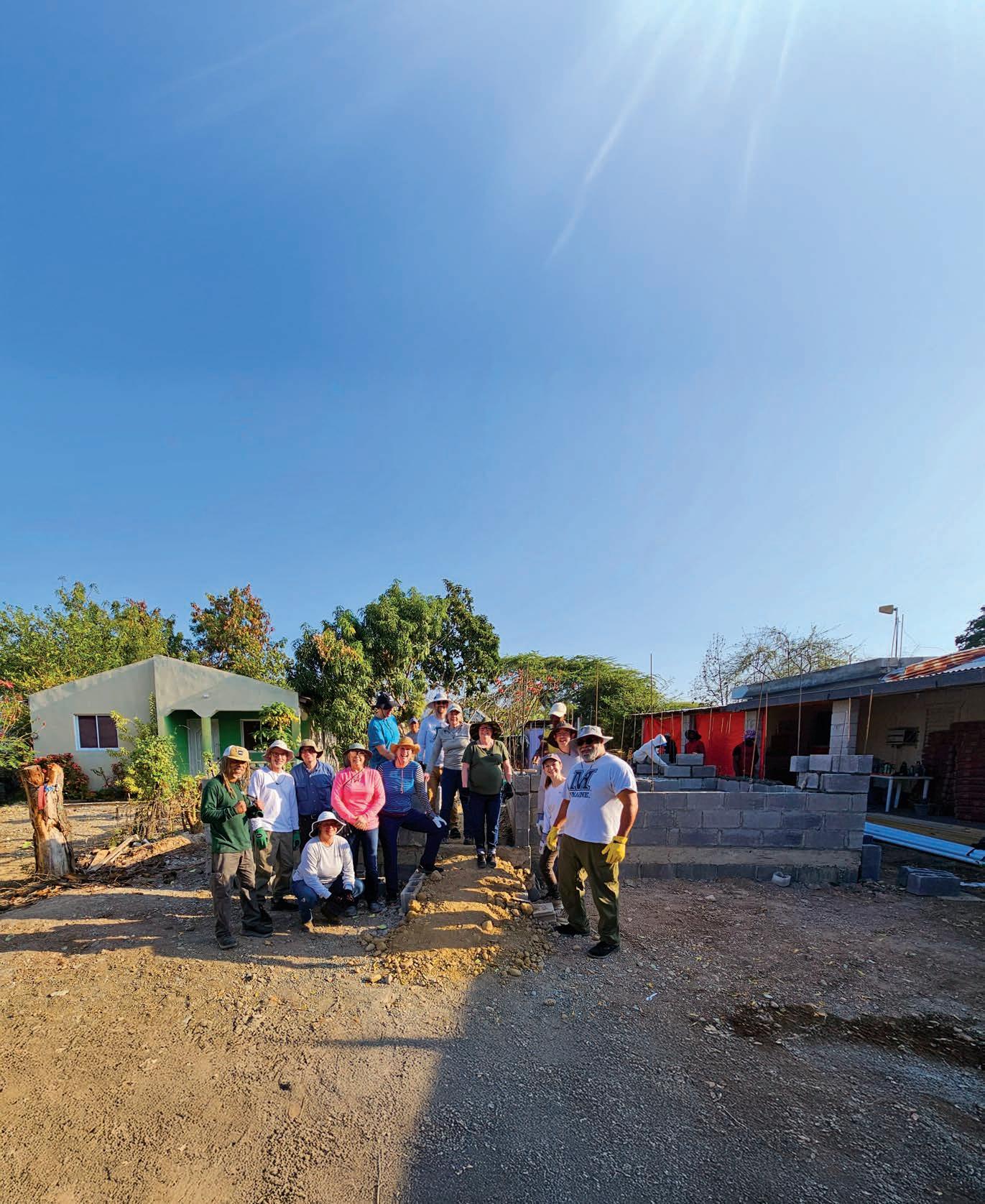
8 : 00 AM, MONDAY, MARCH 10, 2025 : TRAFFIC STOPS OUTSIDE AN ELEMENTARY SCHOOL IN THE VILLAGE OF LAVAPI E , SAN JUAN, DOMINICAN REPUBLIC. STUDENTS, IN ROWS OUTSIDE, SING THE NATIONAL ANTHEM OF THE DOMINICAN REPUBLIC. WHEN THEY FINISH, WE WAVE, AND THEY WAVE BACK, AND OUR BUS MOVES ON THROUGH THE VILLAGE. FRAMED BY MOUNTAIN RANGES, THE LANDSCAPE ALTERNATES BETWEEN IRRIGATED GREEN RICE FIELDS AND PARCHED FARMLAND. THIS DRY REGION HAS NOT SEEN A DECENT RAIN IN A FEW MONTHS.
At the worksite, we find a poured foundation and a crew from the Lavapié community already in motion. Within minutes, we join in and form a long line to carry hundreds of cement blocks from a stack o site onto the new foundation. As a cement mixer turns, we take trowels and set blocks in place with mortar. We work alongside local masons and members of the Guzman family, whose house we are helping to build. The morning heats up, and the worksite hums; sca olding is constructed, and the walls of a home rise around us.
Since 2009, Deerfield Academy has sent more than 20 trips and over 300 students to the San Juan region of the Dominican Republic to work with Cambiando Vidas, an organization that brings volunteers together with the local community to build a ordable housing with and for local families. In the first trip of its kind, an employee-only group traveled to San Juan: 14 members of the Deerfield community, faculty and sta from across departments, including the health center, grounds, athletics, dining services, IT, custodial, advancement, the library, and English, math, and science departments. Despite working at the same school, many of us had never truly connected until this trip.
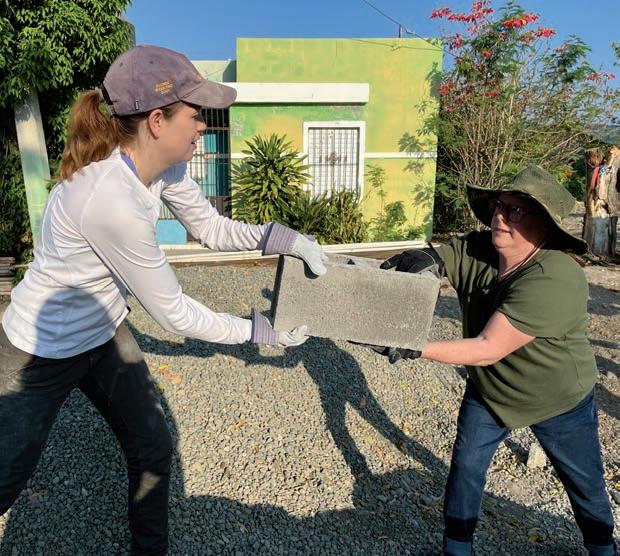
Trip leaders Sheryl Koyama, who teaches math, and then-director of the Center for Service and Global Citizenship David Miller have long been interested in a Cambiando Vidas house build that brings together employees. “I had zero interest in an all-faculty trip,” Koyama says. They were thrilled when the Academy o ered its full support to this alternative approach to professional development and team building. Behind a neighboring house, the Guzman family prepares enormous pots of rice, beans, and chicken over fires. At midday, work stops. Our crew, comprised of Dominicans, Haitians, Americans, and a Cape Verdian, locates shady spots to sit. A man pulls up on a motorcycle, a cooler of popsicles strapped to the back. We eat with relish. After lunch, we tour the elementary school our bus passed by earlier. Work continues at the site in the afternoon sun.
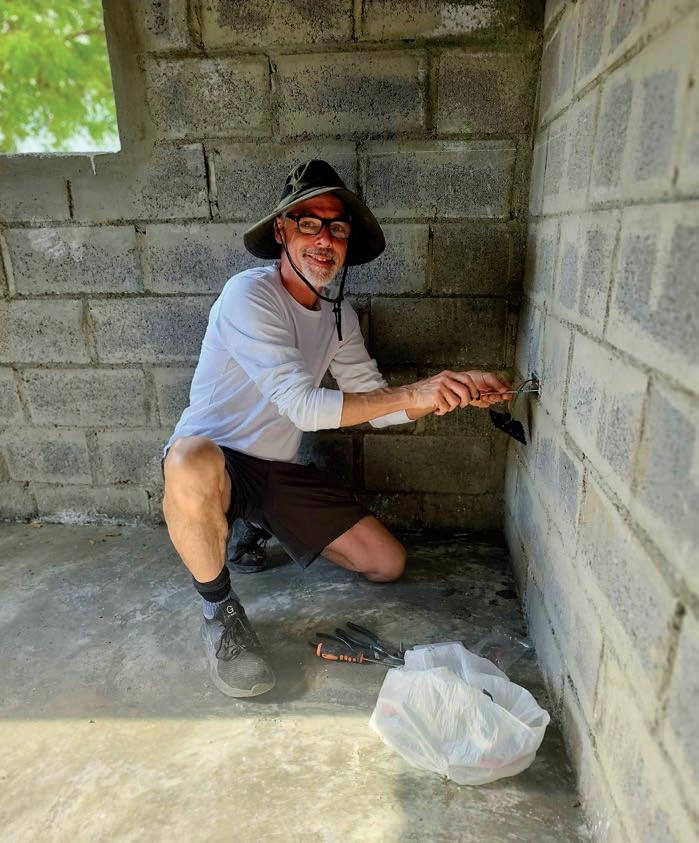

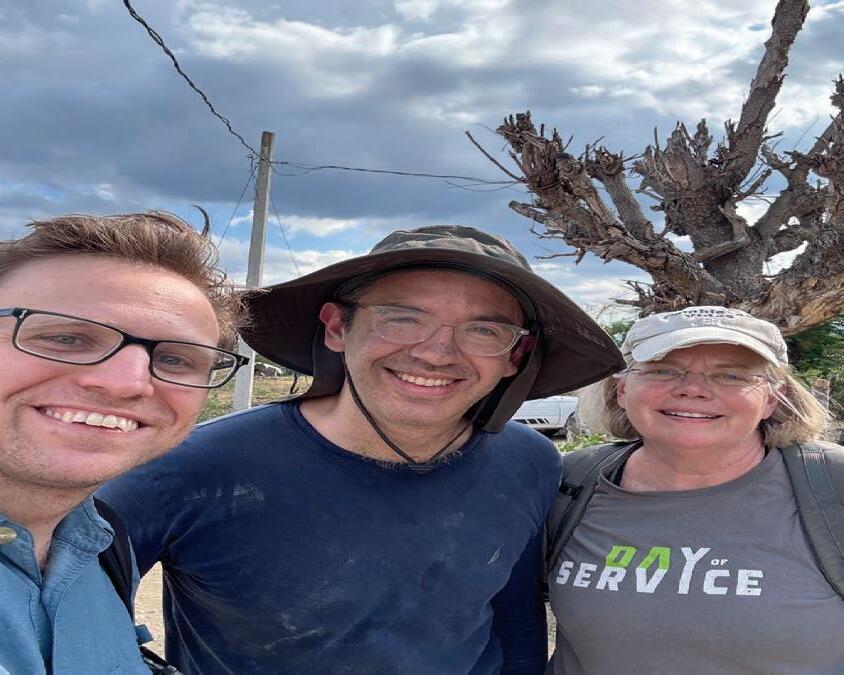

“LOOKING UP AND SEEING IVY [PALMER, FROM GROUNDS] ON TOP OF SCAFFOLDING DOING MORTAR WORK—I WAS JUST AMAZED.”
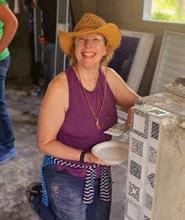
—Mara Kohls
The rest of the week follows a similar cadence. We arrive early, before the day’s heat. We join the Guzmans and Lavapié community in the day’s construction tasks, carefully planned so that the house is complete by the week’s end. We pour cement. We bend and tie rebar. We assemble a roof and dig trenches for plumbing. In the evening, we extract sore feet from steel-toed footwear and see the city of San Juan de la Maguana and the dam that provides it with electricity. We attend a presentation by a local activist on e orts to resist the encroachment of rare earth mineral mining near a vital water supply. We learn to dance the meringue. In pocket -sized notebooks distributed by trip leaders, we pause to record reflections.
As the week goes on and we learn more about the Guzman family, our coworkers from Lavapié, and our colleagues from Deerfield, our work onsite grows more coordinated and light. We begin to know—despite language barriers and, for many of us, lack of construction experience—where to go onsite and what to do, and a sense of joy and camaraderie grows. Once the house has a roof over it, we pour the concrete floor. Another long synchronized chain forms. It begins at the mixer, where we prepare concrete, pour it into wheelbarrows, and then push it to a spot just outside the home’s entrance. There, a line passes heavy buckets inside to pour and empty buckets back outside to fill. The work includes much of our Deerfield crew and many coworkers from Lavapié, working together at a sustained, brisk pace.
Sean Casey Librarian
Jason Cook Aquatics Director
Callie Gray Math Teacher
Mara Kohls Leadership Gift Officer
Sheryl Koyama Math Teacher
John Laprade Production Services Coordinator (ITS)
Laura Manners Custodian
David Miller Center for Service and Global Citizenship (Past Director)
Ivy Palmer Groundsperson
Jim Perry Science Teacher
Carol Rogalski Office Manager (Chen Center)
Rui Santos Custodian
Will Shea Baker
<<< left, clockwise from top:
Will Shea; David Miller, Sean Casey, Sheryl Koyama; Laura Manners, Jim Perry; Laura Manners
Andy Stallings English Teacher
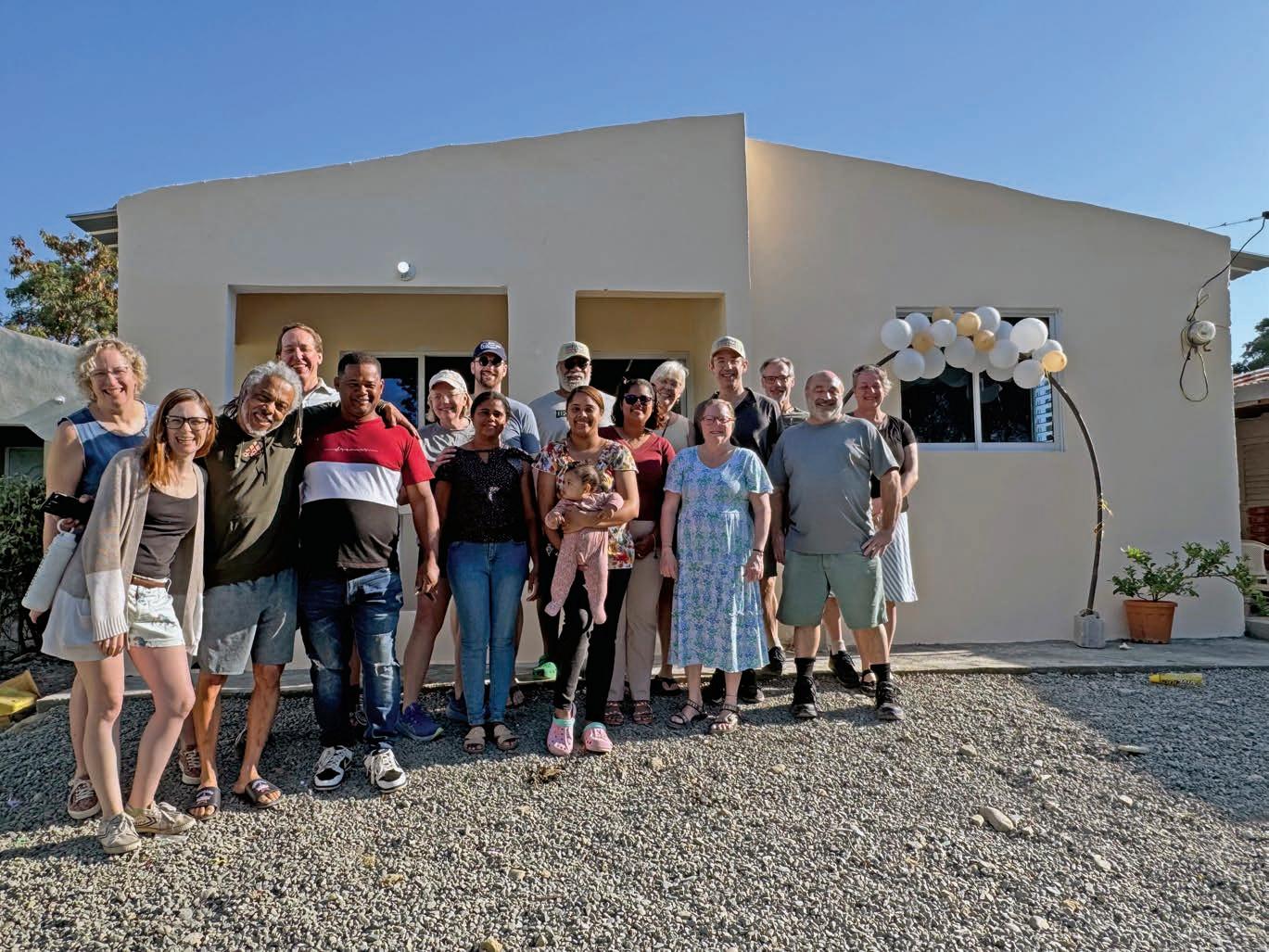
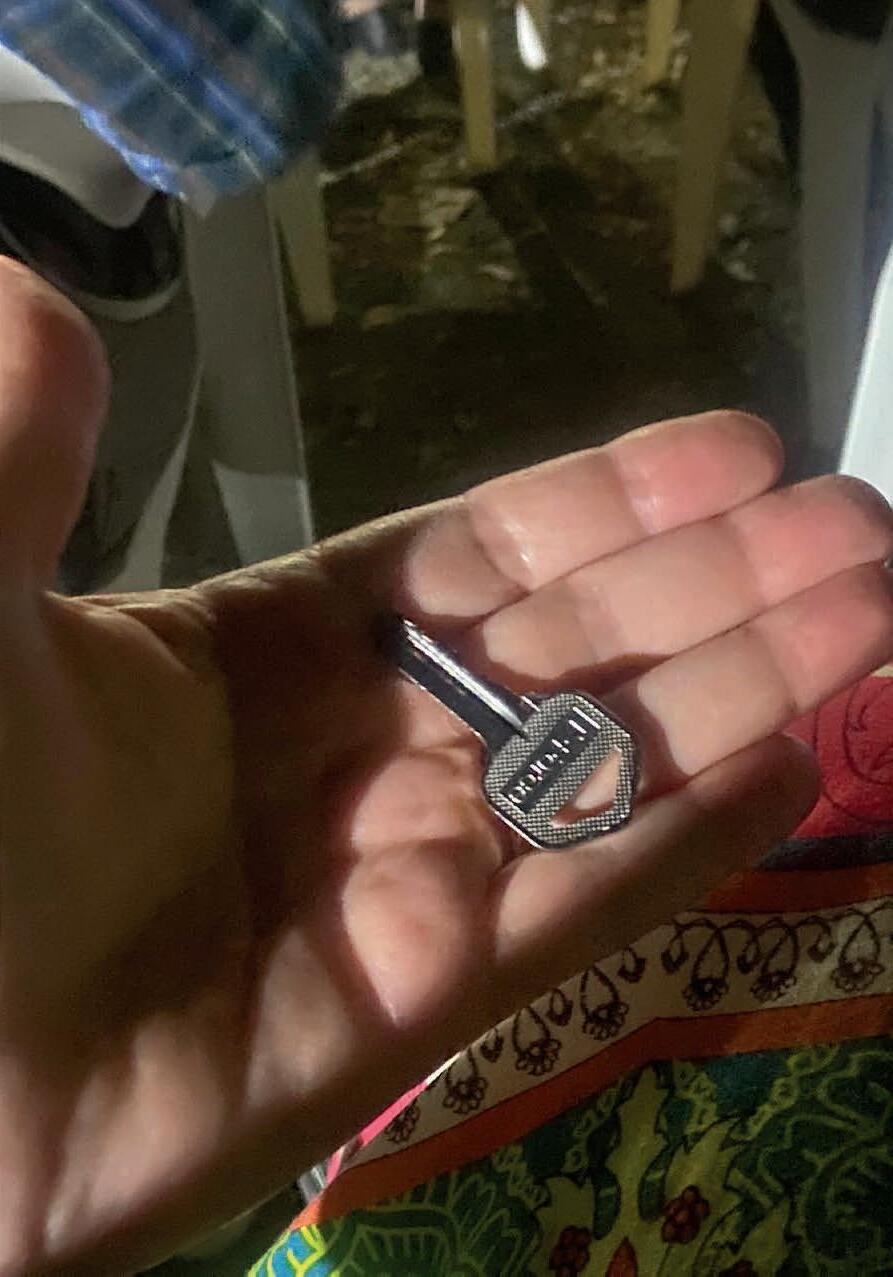
THE GUZMAN FAMILY'S HOME IS COMPLETE BY FRIDAY AFTERNOON, RIGHT ON SCHEDULE. WE RETURN THAT EVENING FOR A FINAL CELEBRATION. A PASTOR OPENS WITH A BENEDICTION. A MERENGUE BAND PLAYS FROM THE PORCH. WE DANCE INSIDE AND OUTSIDE THE NEW RESIDENCE—COLLEAGUES, COWORKERS, AND FRIENDS. TOMORROW, THE GUZMANS WILL MOVE IN.
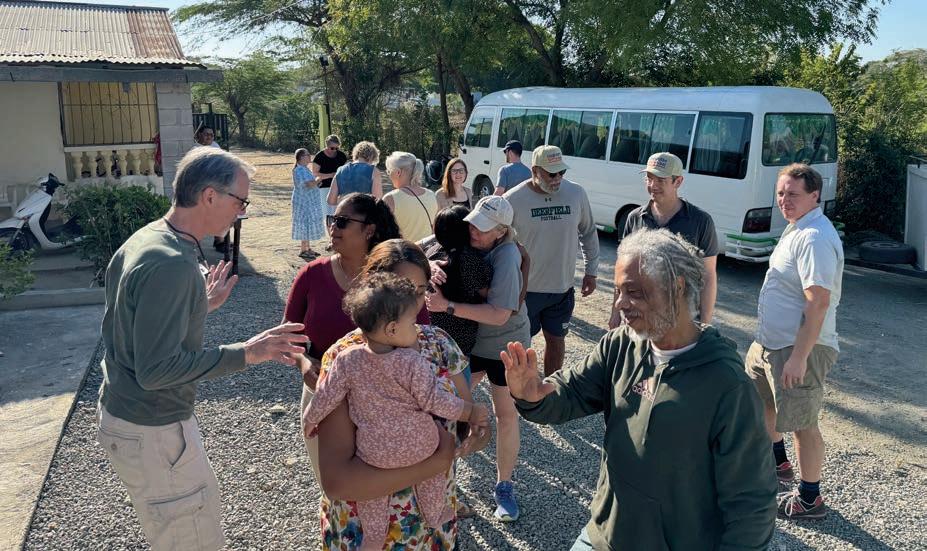
THERE WAS SUCH A COLLABORATIVE SENSE OF GOODWILL. WE WERE INSTINCTUALLY ABLE TO DISTRIBUTE WORK ACROSS OUR SKILLS AND STRENGTHS IN A FLUID, JOYOUS, AND EFFICIENT WAY. THAT'S SOMETHING YOU CAN TAKE BACK TO EVERY TASK OR ENDEAVOR.
—John Laprade













The Guzman family’s home is complete by Friday afternoon, right on schedule. We return that evening for a final celebration. A pastor opens with a benediction. A meringue band plays from the porch. We dance inside and outside the new residence— colleagues, coworkers, and friends. Tomorrow, the Guzmans will move in.
Back at Deerfield, the trip’s participants note the project’s confluence of cultural immersion, service, and team building, which strengthens Deerfield community bonds while enlarging that community into the Caribbean.
One image stands out when Mara Kohls, from the O ce of Advancement, thinks back on her time in the Dominican Republic. “Looking up and seeing Ivy [Palmer, from Grounds] on top of sca olding doing mortar work—I was just amazed.” Kohls found both challenge and transformation in the work. “It tested my physical strength and made me realize I could do things I didn’t know I could do. It’s a huge confidence booster and community builder that changes lives.”
For John Laprade from Information Technology Services, the construction site teamwork in Lavapié raises the bar for collaboration and transfers back to his work at home: “There was such a collaborative sense of goodwill. We were instinctively able to distribute work across our skills and strengths in a fluid, joyous, and e cient way. That’s something you can take back to every task or endeavor.”
Sheryl Koyama sums up the Cambiando Vidas employee trip this way: “It was a great equalizer: teachers, custodians, a librarian, a baker—at the worksite, we’re all members of one team. We go thinking we’re changing the lives of a Dominican family, and leave thinking it was ‘my life’ that was changed.” And she’s happy to know that another employee crew will head to the Dominican Republic in March of 2026. //

Faculty advisors provide students with a strong foundation, and then give them the confidence to soar.

It was really, really late. Or maybe it was really, really early? To be honest, Dasha Lukyanenko ’25 doesn’t remember exactly, but it was definitely past any reasonable person’s bedtime. Dasha was running through JFK to catch a connecting flight to be with her family for winter break, only to learn that the flight had been canceled. Her parents had recently relocated from war-torn Ukraine to Newfoundland, a place that isn’t easy to get to any time of year, but especially now. It was the first time she’d be seeing her parents since she’d started at Deerfield. And, perhaps most importantly in this moment, it was the first time she was flying alone.



In this stressful moment, Dasha did what any Deerfield student would do. She picked up the phone to call—her best friend? Her favorite teacher? Her mom? Nope. She called Melissa Persons, Director of Financial Aid and Enrollment Operations, better known to Dasha as her advisor.

For most students, their high school advisor is someone they meet up with two, maybe three times a year. It’s a person who helps you pick classes for the next semester and perhaps gives you a little pep talk about your grades. If you’re lucky, it might be the person who takes a special interest in you and pulls you aside to talk about scholarship opportunities or college programs that would be a good fit. They’re not the person you call in the middle of the night from a major airline hub.
At Deerfield, the advisor/advisee relationship includes all this and more. “Every kid at Deerfield knows when they’re really excited about something, they go to their advisor,” says Amie Creagh, Associate Head of School for Student Life, “and when they’re really struggling, they go to their advisor. For all the highs and lows, they’ve got a person to turn to.”


The overarching goal of the advising system is to position students at the center of their Deerfield experience, and to foster self-reflection, responsibility, and agency, even as they’re supported by their advisor. Building relationships like these doesn’t happen by chance, but there is a chance element to it at the beginning, when students are first paired with a faculty member. A student’s first advisor is typically also their dorm resident or one of their classroom teachers, so it’s not a total stab in the dark, but the advisor and advisee are meeting as strangers, particularly in the ninth grade.



“That initial advisor assignment seeks to leverage time spent together during regular routine interactions,” says Creagh. And after that first year, Deerfield students are presented with a choice. They can stick with their original advisor assignment if they want to, but many students form rapports with other adults on campus over the course of the year, and they are more than welcome to lean into those relationships. “The Student Life O ce pairs them with an advisor with whom they’re likely to interact with during the natural cadences of the day,” says Anne Bruder, Dean of Academic A airs. “But let’s say that the child has formed an awesome relationship with their science teacher or with their basketball coach. Not all first matches are the perfect match, so students can make the decision to seek an advisor with whom they’ve organically formed a strong connection.”
Anneke Wittink ’25, another of Persons’ advisees, was not assigned to Persons when she arrived on campus. In fact, she just switched into her advisory partway through this past year. “I’ve had an astonishing four advisors in three years,” Anneke says a bit sheepishly. She’s quick to add that it wasn’t as though her previous advisors were poor fits. “They’ve all been great, but Mrs. Persons was my dorm resident last year,” Anneke explains. “She had always been such a kind and welcoming person. I felt like she was kind of like my second mother! Anytime I had an issue to chat about, she was there. She always had food, and her apartment was so cozy, and she’s just always been a lovely person that I feel like I could turn to.”



After their first year, whether that’s as a ninth grader or beyond, students are asked to identify four faculty members who they feel would be a good fit, and then the Student Life team takes it from there—working to make assignments that will benefit students and allow advisors enough time to work in meaningful ways with all their advisees, including communicating with parents and guardians, building academic programs that o er challenges and success, and being good listeners, among other skills.


And that’s exactly the point—there is always a safe, knowledgeable, and available person on campus to whom students can turn. Creating that sense of emotional safety takes time, and the Deerfield schedule creates that time by setting aside regular blocks for advisory meetings. Lunch on Tuesdays, for example, while still a sit-down meal, is when advisors eat with their entire advisee cohort, which can be up to nine students. And on Fridays, daily “Community Time” is dedicated to advisees gathering with their advisors again for 45 minutes. “Most advisors will meet up with advisees beyond those times, too,” explains Creagh. “But these set times are at the beginning and the end of the week, so that we have checkpoints for seeing the kids.”


“Seeing the kids” has layers of meaning. “We have eyes on kids throughout the day, but being seen isn’t necessarily about the visual field,” Bruder says. After all, advisors can’t be with their advisees every minute. But some adult on campus will have eyes on a student at any given time. “If I see a kid who doesn’t seem quite like themselves—unusually withdrawn or quiet in class, for instance—it’s not at all uncommon for me to jot an email to that child’s advisor and say, “Hey, this is what I noticed.’ There’s this kind of invisible chain of communication between adults in the background, and that all flows through the advisor. It’s like a mosaic, bringing all that together to deepen their work with each student.”


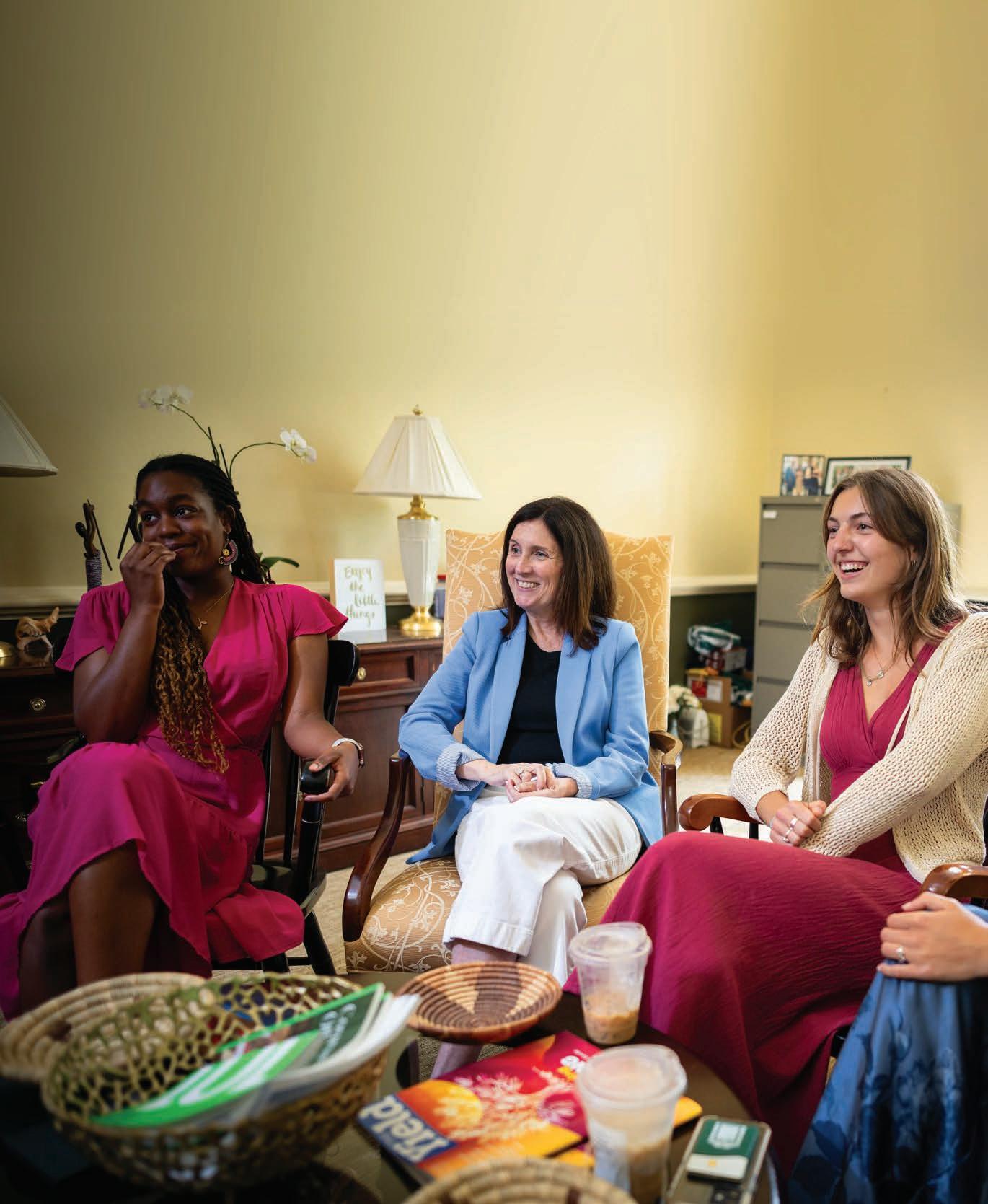
THE OVERARCHING GOAL OF THE ADVISING SYSTEM IS TO POSITION STUDENTS AT THE CENTER OF THEIR DEERFIELD EXPERIENCE, AND TO FOSTER SELF-REFLECTION, RESPONSIBILITY, AND AGENCY, EVEN AS THEY’RE SUPPORTED BY THEIR ADVISOR.
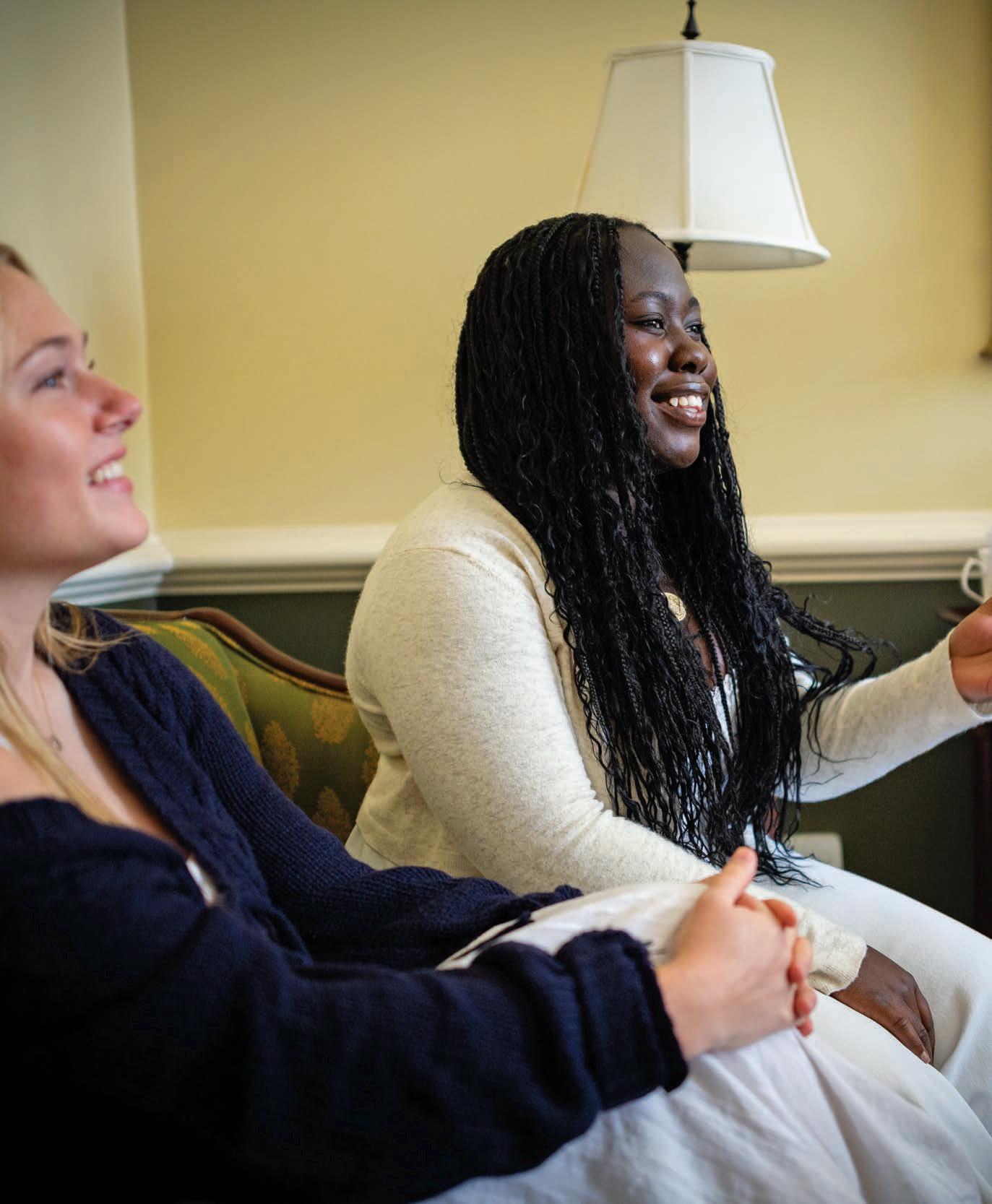
AS TIME GOES BY, ADVISORS BEGIN TO UNDERSTAND WHERE A STUDENT’S STRENGTHS LIE— AND WHERE THEY NEED SUPPORT OR EVEN SOME GENTLE CHALLENGING.
Spending so much time with each other does more than just create ease and comfort. As time goes by, advisors begin to understand where a student’s strengths lie—and where they need support or even some gentle challenging. When Adeeva Alli ’25 arrived on campus from Saudi Arabia, the culture shock was overpowering, and Persons immediately represented a safe haven. “She was one of the first faculty I felt really comfortable with when I got here. I don’t know, I just felt like I could speak to her on a personal level,” she says. “I didn’t have to be as formal as I was acting towards other faculty members.”
Adeeva could be herself with Persons, which means Persons was able to tune in to what she really needed. As a ninth grader, Adeeva was on the wrestling team—and excelling. She made it all the way to New England Nationals. But she hated it. “I didn’t know how to walk away from this sport. I was miserable in it. And everyone on my team was expecting me to continue on,” Adeeva recalls. “I couldn’t really bring myself to admit that I wanted to leave.” But this is just the sort of thing a student shares with an advisor. And when Adeeva finally confessed the truth to Persons, she realized she needn’t have worried. “I should have just known that she would be there, regardless of what I chose to do. Because at the end of the day, she cared for me more than she did for my accomplishments in wrestling.”
Persons went to an independent school, too, and she remembers her own advisor. Let’s just say that advisor was not the model for her role today. “I do almost everything that my advisor didn’t,” she laughs. “That advisor-advisee structure was simply about academics. It was very robotic: ‘Okay, these are your grades. How are they going to improve?’ I never, ever looked forward to my advisory meetings.”
Persons approaches her role as advisor in an entirely di erent way. “My responsibility to my advisees is making sure that they know I’m the person to come to if they need help with . . . anything, basically.” There are limits to this, of course. Advisors are not social workers. “I would send students over to the Chen Center if there was any concern about their well-being,” Persons points out. “But if they’re having a problem with their friend group, or even if they’re frustrated with one of their teachers, those are things that we talk through.”

Just as they’re not social workers, there’s another role that advisors do not try to play. “In the past, we often used that phrase in loco parentis, ‘in place of parents,’” says Bruder. “That phrase—and thinking—has fallen out of fashion. We are very much not their parents, but we are highly invested in helping them grow into the adults they want to be.” Creagh heartily agrees. “There are clear lanes, and as advisors, we are not veering into the parents’ lane. Those are distinct roles,” she says. “But we are partners with parents.”
And like parents, when advisors fulfill their roles well, they work themselves right out of a job. Think back to Creagh’s point about how kids go to their advisors when they’re really excited and when they’re really struggling. “The other side of that is like, ‘I’m really struggling with something, but my advisor is not currently available. I can handle this,’” Creagh says. “On the one hand, the advisor has been there for the child. And on the other hand, the advisor has created a sense of ‘you got this.’” Just like parents, advisors watch their advisees grow, mature, stretch their wings, and fly. . . .Well, sometimes they fly. But sometimes the plane is grounded. Which brings us back to that night in the airport, when a panicked Dasha dialed her advisor—who also was the person who had booked the tickets, explained to her every step of the itinerary, and assured her that if there were any hiccups, she’d be right there, day or night. Even very late at night. “I don’t know if Mrs. Persons was asleep when I called her,” Dasha admits. “But it was definitely late— around 11:00 pm or midnight. She told me that whatever happens, we will figure something out, that she is not going to go to bed until she’s sure I’m okay and that I have a plan.”
That plan involved Persons speaking with ticket counter workers, finding new flights, and arranging for Deerfield alumni to meet Dasha so she could spend a night in Toronto as she made her way to Newfoundland. In the wee hours of the morning, once Persons knew that Dasha had touched ground in Toronto and that Deerfield alumni were there to help, she finally went to bed.
Fast forward three years, and both Dasha and Persons know that she could manage this trip without any guidance. And this fall, when seven of Persons’ advisees head o to college, she knows they’ve all learned the skills they’ll need to thrive and navigate the world without her. That’s the beauty of Deerfield’s advisory program: It teaches students how to ask for help, and how to solve problems, and that sets everybody up for success. //
Constructive Speech:
BY:
Julia Elliott
Billy Tang ’25 joined the Deerfield Speech and Debate Club as a ninth grader because, he jokes, “I’m a motormouth!” but also because, like most Deerfield students, he is deeply interested in many different subjects.
“Whether it’s feminism, AI, import-export economies, foreign policy, social justice theory, debate is the best way to be exposed to all sorts of things—and talk about them.”
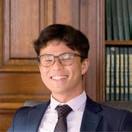
Tang’s passion for debate was on display this past April, when 130 students from 16 New England independent schools met in the Koch Center classrooms to compete in the 50th Annual Deerfield Academy Parliamentary Debating Tournament. Teams of two faced o in three rounds of debate, learning the topic and whether they were arguing for or against it just ten minutes before the start. The Deerfield students felt the pressure. “[It was] kind of humbling to represent fifty years of e ort,” says Tang, “and continuing that legacy of excellence that previous generations acquired.” Happily, Deerfield won first-place school overall, and Tang won first-place speaker. “To finish up strong felt really good,” he says. Debate in one form or another has existed at Deerfield as far back as the 19th century. In the 1870s, the Academy organized a Friday night debating society to distract students from attending dances held at the Deerfield Hotel. One hundred years later, as Geo Buerger ’75 describes in “Deerfield Debate in the 1970s,” debates were held on weekday evenings against another prep school. At home debates, spectators packed into the Caswell Library, debaters donned tuxedos, and heckling was encouraged. The OPEC energy crisis and high gas prices of 1973 gradually led to multi-school tournaments held on Sundays, which “maximized the number of debates that could be had per gallon.” In 1978, Deerfield joined the newly formed Debating Association of New England Independent Schools (DANEIS). Decades later, Buerger’s takeaways remain clear: “For those of us who participated, debate was a crash course in American constitutional law, civics, history, and current events— an invaluable introduction to the responsibilities inherent in joining the body politic. It also made us more skeptical, analytical, and reflective as thinkers; more articulate and confident as speakers; better organized and more persuasive as writers; more resilient in response to criticism; and better informed and more open-minded as citizens.”
“[It was] kind of humbling to represent fifty years of effort . . . and continuing that legacy of excellence that previous generations acquired.” —Billy Tang ’25

In the 2025-26 academic year
Deerfield will expand the debate program to a cocurricular making it an option alongside required afternoon activities in the arts and athletics—not only because of the club’s success and popularity, but because the skills taught through debate closely align with the Academy’s mission and are increasingly relevant in today’s world.
In recent years, Speech and Debate has been racking up wins across New England and around the word. The team has brought home trophies from the International Independent Schools Public Speaking Championships (IISPSC or “Internats”); students have qualified for and won awards at the World Individual Debating and Public Speaking Championships (WIDPSC or “Worlds”); and both the novice and advanced teams consistently win DANEIS tournaments. In the 2025-26 academic year, Deerfield will expand the debate program to a cocurricular—making it an option alongside required afternoon activities in the arts and athletics—not only because of the club’s success and popularity, but because the skills taught through debate closely align with the Academy’s mission and are increasingly relevant in today’s world.
“We take debate seriously,” says Coach Dr. Dan Houston. Speech and Debate practices, known as “training pods,” are held three times a week after sit-down dinners, and debaters are encouraged to attend at least one “pod” per week. DANEIS hosts tournaments on thirteen Sundays throughout the academic year and, as Houston describes, “It’s a day. We might leave at 8 am, drive two hours, debate all day, drive back, and stop at Chipotle for dinner. The kids who stick with it throughout the year are deeply committed to it.”

Dr. Houston seen here l to r: Edie ’25, Avery ’25, Kellie Houston, and Lily ’25 in Kuala Lumpur, Malaysia, for the World Individual Debating and Public Speaking Championship this past March. Speaking, Interpretive Reading, Parliamentary Debating, Impromptu Speaking, and After-Dinner Speaking.
Houston is the Chair of the Language Department and teaches ancient Greek and Latin. For the past two years, he has been assisted by History and Social Science teacher John Leistler and, in the last year, by Chinese teacher Matt Kutolowski. All three debate coaches, as Tang describes, are “not only good advisors but good mentors.” Avery Zakowich ’25 says what makes the club tick is that Houston goes above and beyond: “He really cares. He is super positive and really into debate, and that has a trickle-down e ect and shapes the attitudes of the kids.”
Practices for Speech and Debate are largely student run. This year, a board of six students (Tang, Zakowich, Edie Hu ard ’25, Myles Mzyece ’25, Lily Pierce ’25, and John Woo ’26) met weekly with Houston to review the curriculum. Two board members ran one of the three training pods each week, leading the novices through drills, rounds, speeches—everything they need to learn for parliamentary debate, the format debated in DANEIS.
Houston initially was anxious about not being able to attend every training pod, but says, “My not going has had the great consequence of giving [students] more ownership.” Tang remembers idolizing the older debaters who coached him, such as Thomas Harrick ’23, who in 2022 won the world championship in impromptu speaking in Durban, South Africa, and Justin Ahn ’24, who was the top individual speaker at the 2023 IISPSC in Vancouver, Canada. As board vice president this year, Tang’s goal was to be “the person my freshman-year self would look up to. That’s the guiding philosophy for all of us: How do we get the students who have never done debate to engage and be passionate, but also feel welcome and to grow and succeed and be excellent in that space?” Teaching younger students has helped him be a more concise and e ective communicator, skills he’s been able to apply to other roles at Deerfield, such as serving as proctor or peer tutor or making presentations as Student Body President. The highlight, however, has been watching the novices do well in tournaments. “They were rocking out policy memos. They were able to recall facts and bring out examples. I’ve enjoyed seeing them become more assertive and grow in confidence.”
All agree that the most valuable skill debate has taught them is learning to look at all sides of an argument.
Speech and Debate practices, known as “training pods,” are held three times a week after sit-down dinners, and debaters are encouraged to attend at least one “pod” per week.
/// COACH /// Dr. Dan Houston Chair of the Language Department Teaches ancient Greek and Latin
/// ASST. COACH /// John Leistler Teaches
History and Social Science
/// ASST. COACH /// Matt Kutolowski Teaches Chinese
“I think people underrate the collaborative aspect of debate,” says Myles Mzyece ’25. His debate partner is Edie Hu ard, and the two developed what he describes as a good cop/bad cop routine, with Hu ard being more charitable to their opponents. Hu ard agrees that their strength was their di erences. “Every resolution we get, we view from totally di erent sides, which has been great, because there’s nothing our opponents can think of that one of us hasn’t already come up with!” At a tournament at Loomis Cha ee, the two were debating meat subsidies. Hu ard knew a lot about the meat industry and environmental impacts, Mzyece knew about subsidies and the economic impacts, and their combined understanding of the subject led to a win. The best part of their partnership, however, has been that the discussions don’t end after the trophies are awarded “More than once,” says Hu ard, “I’ve received some link to an article at 3 am from Myles because we are still talking about an issue. You and your partner become very bonded because you’re having fun no matter how the tournament goes.”
Zakowich says the highpoint of her senior year was winning the cross-examination debating championship at Internats in Bermuda, not so much because of the award, but because it was “the cherry on top” of her three-year debating partnership with Tang: “It was a sweet moment. I think debate gets a bad rep for being this cutthroat competitive environment. At Deerfield, it is more collaborative and everybody supports each other.”
In addition to teamwork, parliamentary debate encourages debaters to learn how to structure arguments and articulate ideas, which inevitably leads to excellent public speaking skills. Dean of Academic A airs Anne Bruder recalls Mzyece’s speech at the Senior Dinner this year. “It was remarkable,” she describes. “It had turns of phrase that he used as refrains. It was expansive but also had moments referencing specific students.” Three minutes into it, Bruder realized Mzyece had no written notes. “That confidence to stand up in front of the entire senior class, all the faculty, and deliver that address is totally incredible.” Mzyece chalks his skill up to the debate club’s accessibility. “Being a good speaker is something you can train and rehearse for. You don’t need years of prior experience; just show up to training pods, practice, do your own training outside of club hours— all those things add up.”
“A lot of kids think argument is synonymous with disagreement, we teach them that it’s a claim backed by reasoning and evidence.”
Dan Houston
All four debaters agree that the most valuable skill debate has taught them is learning to look at all sides of an argument. Because in parliamentary debate they are assigned a perspective on an issue, students may find themselves arguing on behalf of communism one day and unfettered capitalism on another. Hu ard says this has taught her how to disagree with others in a non-confrontational manner. “It’s made it a lot easier to have calm, reasonable discussions in my day-to-day life.” Tang puts the benefit of debate succinctly: “Debate is a tool that teaches you empathy. Being able to put yourself into other people’s shoes is super valuable.”
In May of 2024, Head of School John Austin led a task force that released Thriving in a World of Pluralistic Contention: A Framework for Schools—a series of guidelines for schools to encourage freedom of expression, non-partisanship, and intellectual diversity. For Austin, debate is key to fostering a learning environment where students can encounter new and di erent ideas. “That third pillar of intellectual diversity sits at the center of our academic program, and nothing emphasizes that more than debate-centered learning.”
When he first read the Framework, Houston immediately saw overlaps with the Speech and Debate curriculum. One of his early lessons is to get students to engage thoughtfully through arguments. “A lot of kids think argument is synonymous with disagreement,” he says. “We teach them that it’s a claim backed by reasoning and evidence. Just that first step already aligns with [the Framework].” Houston was also struck by how the Framework encourages students to practice “thoughtful self-regulation and civility,” which are some of debate’s guiding principles. Lastly, the Framework mentions encouraging kids to cultivate humility. “No debater wins all the time,” says Houston. “Learning how to lose,” is an important step toward humility.
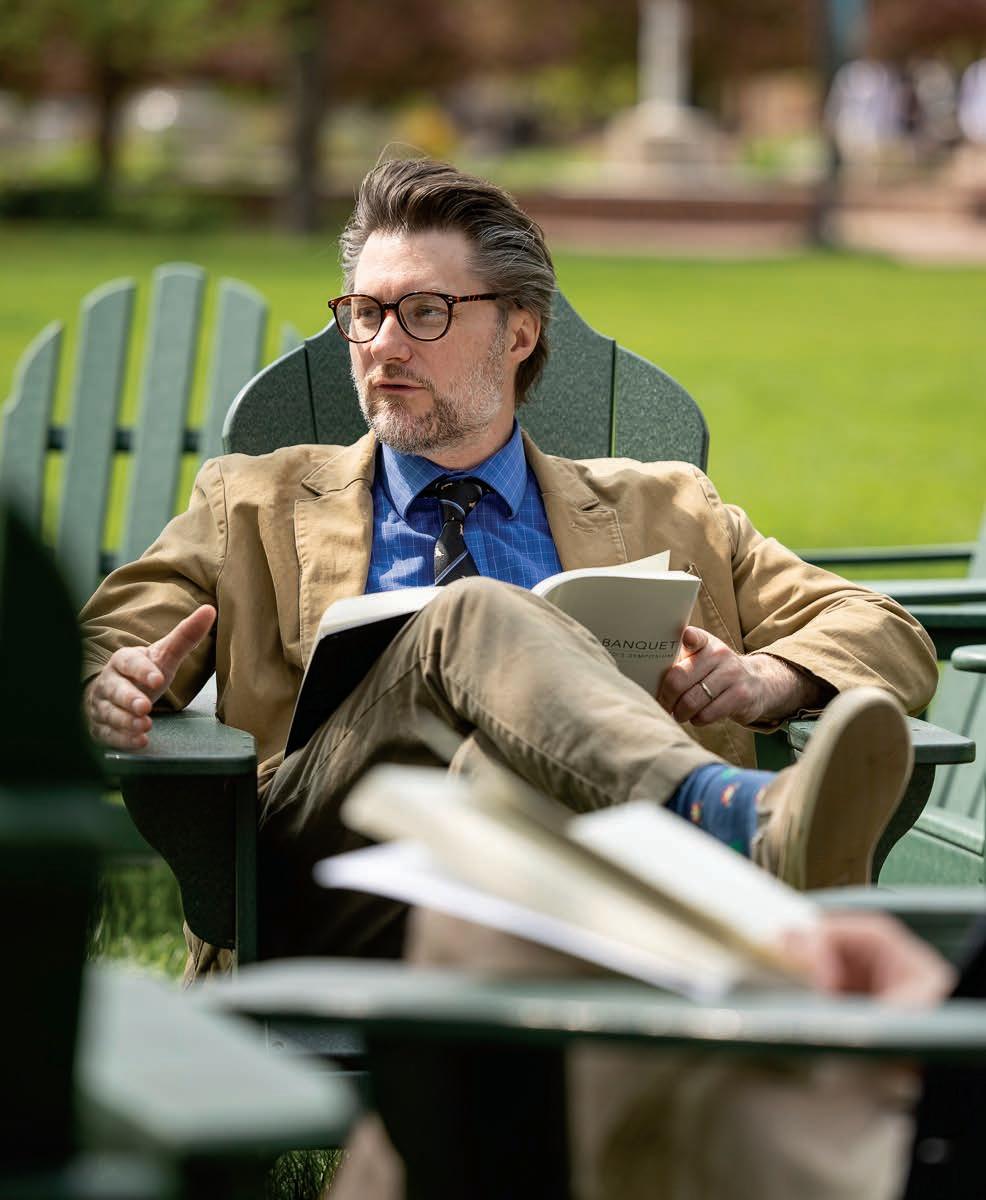
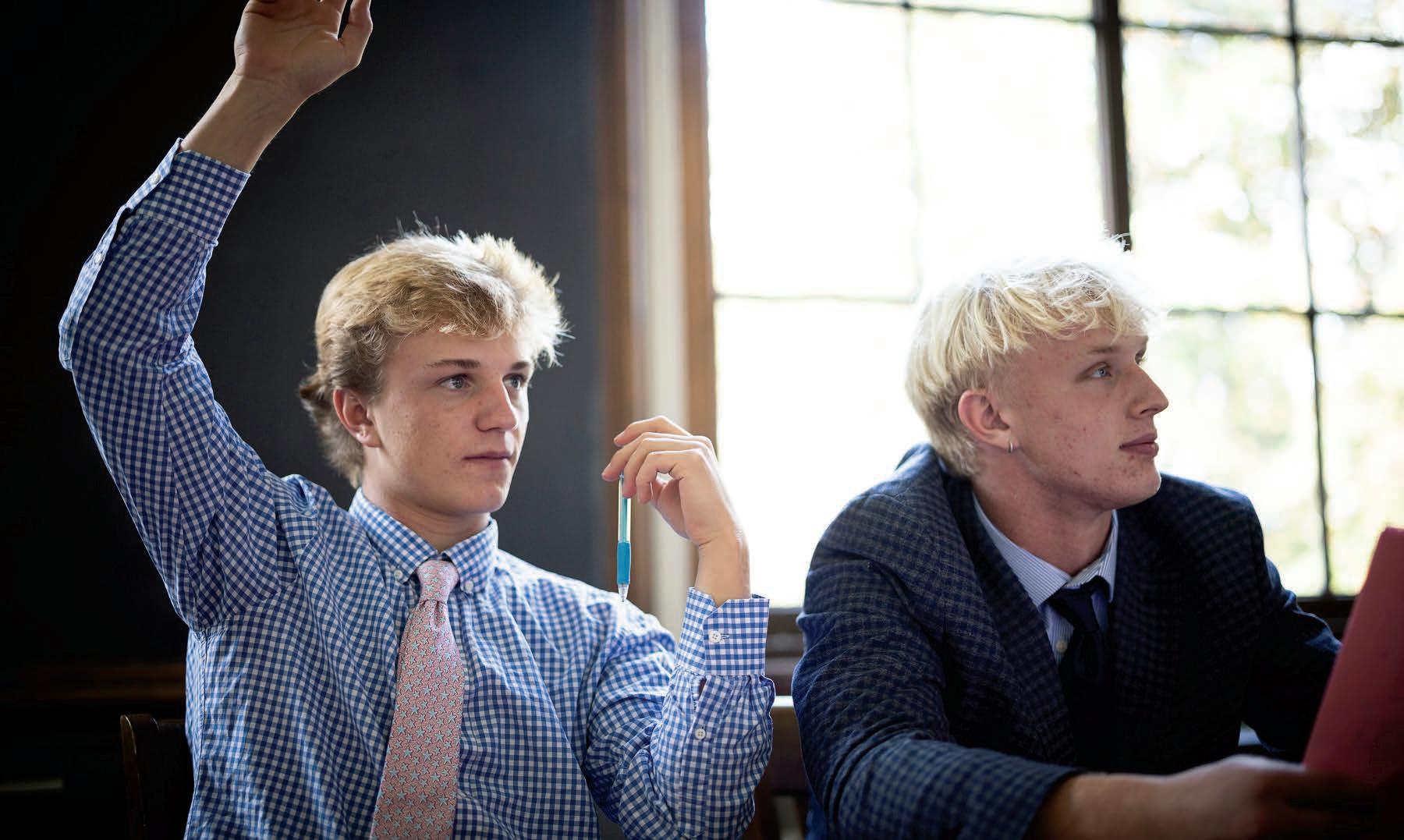
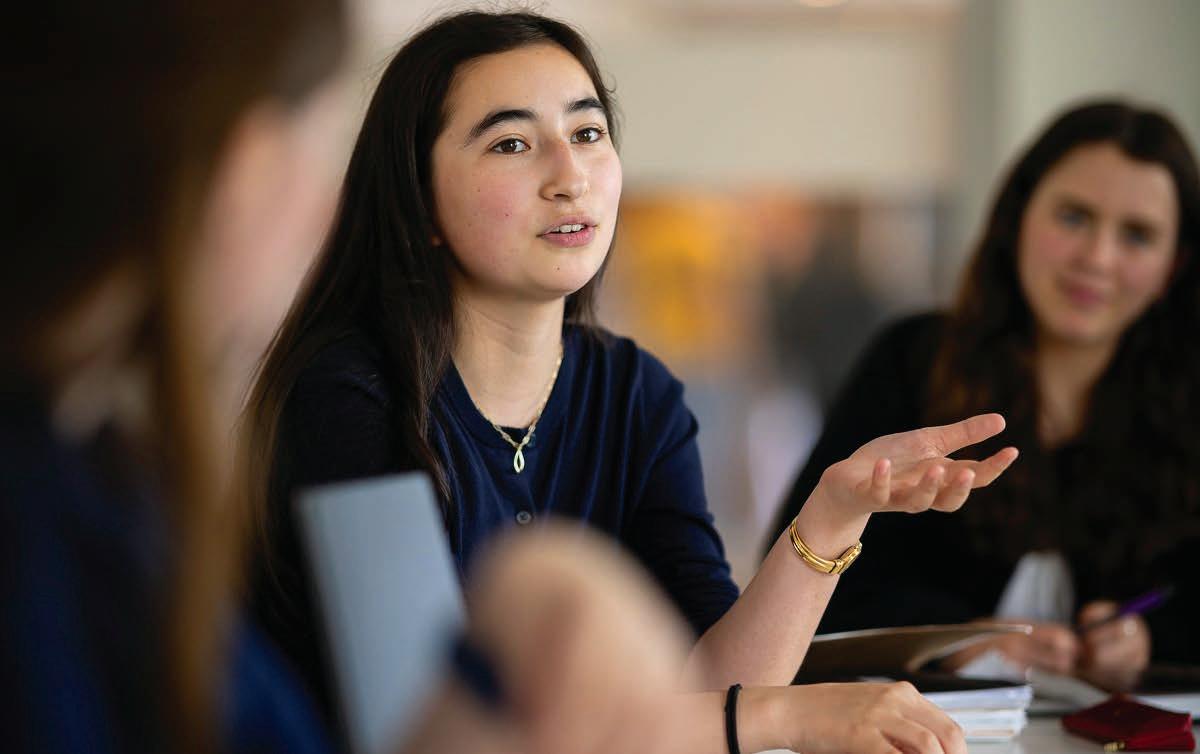
Deerfield has begun to incorporate elements of debate more broadly throughout the curriculum.

“Debate encourages students to inhabit ideas and positions and arguments that may not be their own, and it emphasizes deep listening and persuasion.These skills are not only fundamental to initiating young people into the life of the mind: they are critical to creating a healthy civic-minded society.” John Austin
Partly in response to the Framework, but also because of faculty interest, Deerfield has begun to incorporate elements of debate more broadly throughout the curriculum. At a faculty meeting in the fall of 2024, Houston gave a presentation and students staged an impromptu debate on standardized testing in college admissions. “Watching the students demonstrate the communication, problem solving and collaboration skills that are at the heart of what we are trying to do in our classrooms was a powerful bit of professional development,” says Bruder, and it helped spark ideas about the way debate can be incorporated across disciplines.
In the 2025-26 academic year, Speech and Debate will be expanded to be both a club that meets in the evenings and a cocurricular o ered in the fall, winter, and spring. Houston will coach the fall and spring cocurricular and Leister will coach the winter. Growing the program meets the desire of club members who, despite their many wins, were clamoring for coaching time with Houston. More ninth and tenth graders will have the opportunity to try parliamentary debate, and Houston will have the time to teach other formats, such as Lincoln Douglas or Public Forum.
While the victories have been important, for Houston and his students, the highlight of Speech and Debate has been the time spent together: riding the van to Boston, befriending students across grades, standing in awe at the Nelson Mandela Capture Site in Howick, Natal, South Africa, or sharing a communal hotpot in
Malaysia. “We really are a team in every way,” Houston says. Zakowich agrees: “We have practices like a team, travel like a team, share meals like a team. Debate shares so many of the aspects of a varsity sport—minus the physical component. That was why I was so adamant about making it a cocurricular.”
Not every school has the resources to send students to compete at Worlds or Internationals, and for this, students are grateful to the broader Deerfield community. “Part of why debate at Deerfield has been so transformative is because of the support from generous alumni who give back to programs such as debate,” says Zakowich. “It is the only reason we are able to have these experiences and opportunities.”
For Austin, growing the debate program is a “a happy convergence” of several elements: “We have a tremendous and gifted debate coach in Dan Houston. The kids have been doing exceptionally well in competitions, and we want to deepen that. [Lastly, debate is] very much in keeping with the Framework and the kinds of young people we are trying to graduate. Debate encourages students to inhabit ideas and positions and arguments that may not be their own, and it emphasizes deep listening and persuasion.” These skills, Austin says, are not only fundamental to initiating young people into the life of the mind: they are critical to creating a healthy civic-minded society.
The ability to go out into the world and deeply engage with others has, for Tang, been the biggest takeaway from Deerfield Speech and Debate: “to have this genuine connection with people, that’s the greatest benefit. It’s, ‘let’s actually have a conversation; I’m interested in what you have to say.’ The more people we encourage to do that, not only do we have a stronger community, but we have more nuanced and critical thinkers in our student body who are more willing to speak up and advocate for other people.” //
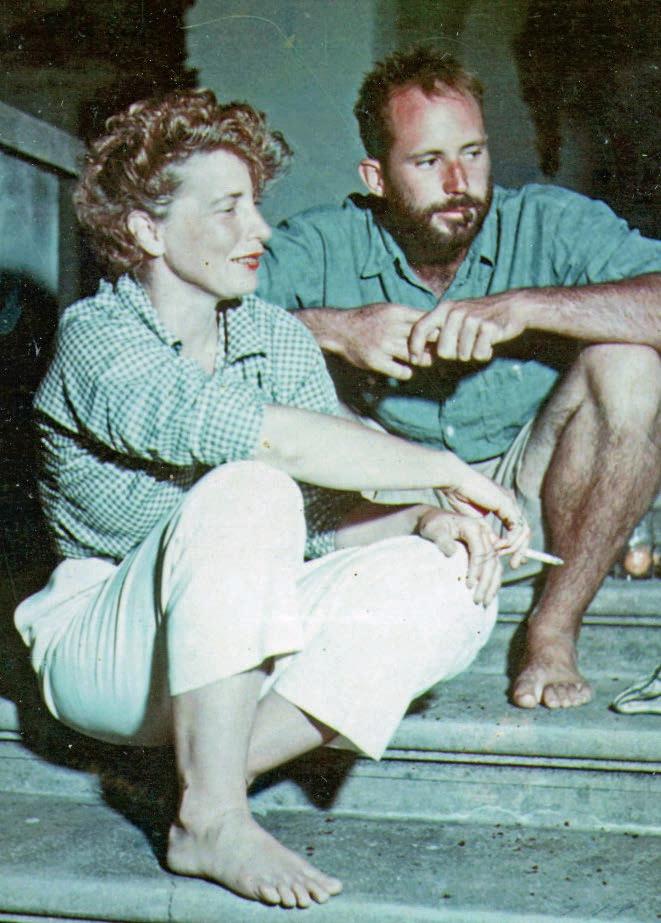
above: Margaret Wise Brown and James Stillman Rockefeller Jr.; James’ memoir, Wayfarer.
James Stillman Rockefeller Jr., a member of Deerfield’s Class of 1944, died on January 8, 2025, at home in Camden, ME, a day after he turned 99. Born to Nancy Carnegie Rockefeller and James Stillman Rockefeller Sr., he was the great-grandnephew of both John D. Rockefeller and Andrew Carnegie. Jim was given the nickname “Pebble” to distinguish him from his father. He grew up in Greenwich, CT, and attended Greenwich Country Day School prior to Deerfield. He served in the Army Air Forces as World War II was ending, followed by attending Yale University. Jim claimed the most valuable classes he had were in celestial navigation and writing.


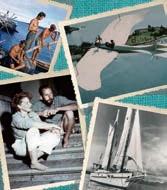


While visiting the Carnegie family in 1952 on Cumberland Island, o the coast of Georgia, Jim met and fell in love with Margaret Wise Brown, the prolific and renowned children’s book author (Goodnight Moon). She brought him to mid-coast Penobscot Bay in Maine and introduced him to the island where she had a rustic refuge and sailed a North Haven dinghy. They decided to get married, but first Jim would finish his cruise, on his forty-foot Friendship sloop, to the Pacific. He was in the Caribbean when news came of her sudden, untimely death in a Cannes hospital during a visit she’d made to France. Excerpted from my review of Wayfarer: “Grief descended, but now a voyage was underway. He never minimized the impact of that loss, but as the cruise developed, there were other challenges to deal with: relationships with crew, sailing conditions, and boat maintenance. Rockefeller seems to have benefited from personal qualities like optimism and resilience. His cruise went from the Virgin Islands to Panama to the Pacific, with stops at the Galapagos Islands, the Marquesas, the Tuamotus, Tahiti, Fiji, and New Hebrides, ending in Australia. Then, on land, he spent time in Lapland and Norway.”
Jim had his first child while in the Pacific, with Stella, whom he met there. They had a son, James (Wawa). He later married Liv Heyerdahl (her ex was Thor Heyerdahl, author of Kon-Tiki). Jim and Liv had two daughters, Liv and Ola. The family settled in Camden, ME; Jim built a landing strip on a mountainside farm and founded Bald Mountain Boatworks, where he and friend Fred Holbrook constructed and restored aircraft, boats, and vintage cars. In 1974, Jim, Tom Watson Jr., and Steve Lang created Owl’s Head Transportation Museum nearby, originally seen as a way for Tom and Jim, both passionate aviators, to fly old planes out over Penobscot Bay. (Ultimately, Jim clocked more than 2000 hours in the air and flew until he was 90.)
Jim conformed to Deer eld expectations, including assigned dining hall tables and duties, class dress, athletic teams (his were football and lacrosse, for which he captained), and academic preparation for college. Yet he was most comfortable in clothes he could get dirty, opportunities to use his hands as well as his brain, and friendships built on passions he shared, not status or family name.”
Jim served 50 years on the museum’s board of directors and 17 as its president. He imagined the museum should be an interactive place where the work of restoration and repair of various means of transportation could be observed. Visitors could ask questions, learn, and be inspired. Museum publicity describes: “A dedicated restoration shop keeps everything in working order. A growing STEM education program is engaging the next generation of inventors, tinkerers, and dreamers. . .. More than a collection, Owl’s Head is an experience. . . interactive, fully immersive, hands-on.”
Although Jim knew his father was “an inveterate tinkerer,” he seemed to reject early any idea of following him into banking. He gained other role models. Life in Greenwich had provided the benefits of an extended family that included those working there as sta ; he learned skills from many. When he left for school at Deerfield, one imagines there was some comfort in Mr. Boyden’s approach to boarding school education: students were members of a school-based family. Jim conformed to Deerfield expectations, including assigned dining hall tables and duties, class dress, athletic teams (his were football and lacrosse, for which he captained), and academic preparation for college. Yet he was most comfortable in clothes he could get dirty, opportunities to use his hands as well as his brain, and friendships built on passions he shared, not status or family name. With Boyden’s belief in the value of having many caring adults in one’s life and that boys are more important than rules, Deerfield was likely the ideal school for Jim and o ered a life lesson: campuses and classrooms (and museums) could be nurturing places. Boyden’s ethos endures, echoed by current Head of School Dr. John Austin, who wrote: “Young people flourish when adults are fully present in their lives, broadly engaged with them across all dimensions of school life, and connecting to building relationships of trust, challenge, and wise mentorship.”
Although Jim wrote little about his Deerfield years (1940-44), he described breaking rules a few times, afterwards having to face Mr. Boyden in his o ce. He explained that he sometimes craved solitude, needing time alone, and would hike to the top of nearby Pocumtuck Ridge to spend the night camping. The Head later
heard that Jim had been seen riding ice floes on the Deerfield River behind campus and called him in again. Jim saw the Headmaster as a figure “who exuded authority and wisdom.” In Wayfarer, he wrote, “Even while being dressed down . . . my detached eye felt sorry for him having to waste his time on a little fish like me for a airs of no importance to either of our destinies. His last words to me came in the form of a bleat: ‘Pebble, when are you going to grow up?’”
References for this article include various obituaries (notably, Maine Coastal News, “Passed Over the Bar,” April 2025). Jim was a gifted storyteller, and Wayfarer: A Memoir (Islandport Press, 2016) is a compelling book, having won the 2019 Maine Literary Award for Memoir. It was reviewed in the January 2019 issue of The Working Waterfront (Island Institute) by this author. Thanks go to Jim’s daughter, Liv Rockefeller, who fielded questions recently and continues to call Camden and Penobscot Bay home. I drew on my own Deerfield Academy insight, having been a faculty member working in the archives and Boyden Library for 24 years ending in 2003. Also helpful were the websites for Owl’s Head Transportation Museum and Deerfield Academy. Much has been written about the life and work of Margaret Wise Brown, including references to Jim and their time together. A recommended title is Margaret Wise Brown: Awakened by the Moon by Leonard S. Marcus (1994). Amy Gary wrote In the Great Green Room: The Brilliant and Bold Life of Margaret Wise Brown (2017), and Jim penned its foreword. Margaret’s picture book, The Little Island (written in 1946 under the pseudonym Golden MacDonald), brings to life her view of Penobscot Bay from her beloved home, Only House. Jim’s widow, Marilyn Moss Rockefeller, has written a memoir about her life and years with Jim: Mountain Girl: From Barefoot to Boardroom (Islandport Press, 2022). On islandportpress.com, Genevieve Morgan, who worked with Jim for a year editing his memoir, posted an admiring recollection (2/5/2025), writing in part, “Jim Rockefeller was a giant among us. He lived and loved and wrote with an earnest abandon, and I will never forget the time I got to have in the presence of such a wondrous and wonderful soul.”
—Tina Cohen P ’95, ’01, Vinalhaven, ME, May 2025
Your generosity to the Deerfield Fund this past year helped us make history! Thanks to supporters like you, we raised more than $7 million, a new Academy record. We honor that collective generosity by putting these gifts immediately to work. They power every facet of campus life—from our dynamic classrooms, laboratories, and studios to our top-flight athletics program, the cherished tradition of sit-down meals, and a leading financial aid initiative making the Deerfield Experience possible for 38% of our students. As we look ahead to the new school year, we’re inspired by your unwavering commitment to Deerfield and excited for what’s to come. Go Big Green!
Magnificent Photography Show in Delphi this Summer! Ry Smith shared that “If you are in the area of Greece this summer you must visit Bob McCabe’s magnificent photography show in Delphi (right)
The show will bring back wonderful memories of simpler times. This is a personal invitation from the photographer himself— robertamccabe@gmail.com. All the best and have a great summer wherever you are!”
Scott Nilsen shared the sad news that Dr. Laurance B. Nilsen passed away in March. (right)
Ilse & Michael Godfrey passed along the following greetings ahead of Reunions 2025: “We very much wish that we could be at the upcoming event. However, we now live in London, where we have lived on and o for very many years. Now we are permanently settled here.
At present, travel to the US presents di culties, at least at our age. In any case, we wish all of our classmates well at the upcoming event!”



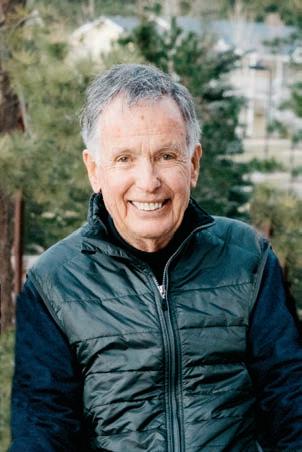
Ellen Knight recently shared the following: “We just returned from (Waimea) Hawaii where Zeke Knight was honored at his former place of employment (an Episcopal boarding school) Hawai‘i Preparatory Academy for a program he and his senior students started 47 years ago called The HPA Olympic Games. During the weeklong series of events, he was repeatedly honored by faculty, sta , and alumni. The academy was also celebrating their 75th year. He was both proud and deeply touched by the outpouring of appreciation and love on campus.” He is pictured here surrounded by the upper school students.
/// by Bryan Callahan ’86 ///
has produced the first comprehensive guide to the works of fellow Deerfield alumnus John McPhee ’49, one of the United States’ most eminent non-fiction writers. Looking for a Story unearths the full catalog of McPhee’s prolific career—from his first ventures in long-form prose as a teenager (in a section appropriately titled “Juvenilia”) to the hundreds of previously uncredited stories that McPhee produced for Time in the 1950s and early 1960s, to his 30-plus books and his 60 years as a writer for The New Yorker Lovingly annotated with revealing insights into McPhee’s creative process, it traces the legendary author’s lifelong quest to discover and tell great stories.
Deerfield Magazine recently spoke with Rubinton about his new book, which Princeton University Press published in May. This conversation has been edited for length and clarity.
DM: How long have you wanted to write about John McPhee?
RUBINTON: My passions for writing, journalism, and McPhee go way back. I knew I wanted to be a writer when I was seven, and I started my first newspaper in fifth grade. When I was 14, I had grown bored with my school in New York City and wanted to be somewhere else—I just had no idea where.
Somehow – probably thanks to my parents—I was given a copy of The Headmaster. I read it and knew immediately that I wanted to go to Deerfield. That’s also when I began to follow McPhee’s writing— something that has never stopped.
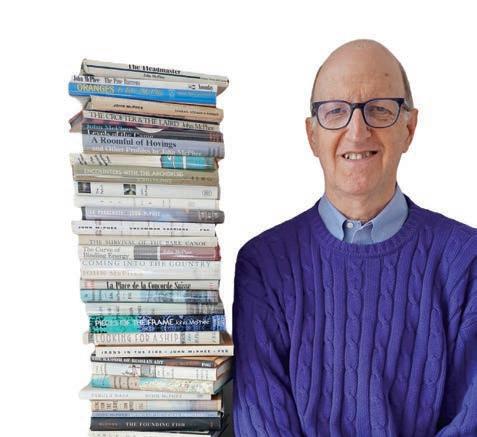
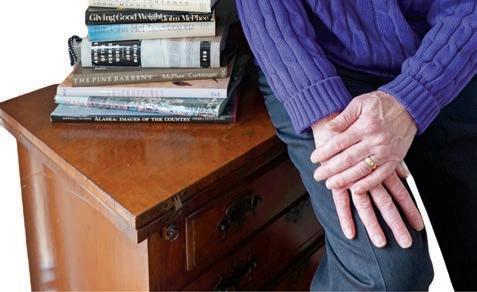
At Deerfield, I worked on The Scroll and had a terrific experience. Then I went to Brown, where I technically majored in history, but, in reality, I majored in the college newspaper, The Brown Daily Herald. I ended up working for Newsday on Long Island for more than 30 years, handling a wide variety of reporting and editing jobs. As the golden age of newspapers faded, I joined UJA-Federation of New York, helping them spotlight their good works before returning to Brown to help raise its profile as a leading research university.
Throughout my career I wanted to write a book but realized I would never achieve that ambition as long as I was working for someone else. I was lucky to be able to go out on my own.
One day four years ago, as my wife and I were packing up for a move from Providence to Washington, DC, the idea of writing a book about McPhee suddenly came into my head, and I decided to pursue it.
DM: What was your idea?
RUBINTON: I wanted to capture the incredible breadth and depth of McPhee’s work and shine a light on the details underlying his writing process, exploring what enabled him to research and write so well about such an incredible array of topics.
DM: And this gave you an opportunity to work with McPhee himself.
RUBINTON: Yes. I started the project back in 2021—during Covid and its obstacles. I pitched the idea to McPhee through an intermediary, and McPhee wrote back almost immediately. He told me how grateful he was that someone was interested in doing this, and he o ered to help.
That led to nearly a dozen visits with McPhee at his home in Princeton and his academic o ce at the university. It was a bit of a surreal experience to meet him. I thought I knew everything he had ever written, which turned out to be far from the truth.
DM: What did you learn about the connection between McPhee and Deerfield in your research?
RUBINTON: I came to see that McPhee is much more connected to Deerfield than I ever imagined, far beyond The Headmaster. He is an incredibly loyal and devoted person, and that has made a tremendous di erence for Deerfield. He has stayed in touch with many former classmates, alumni, and teachers for decades. For instance, Robert McGlynn was a particularly powerful influence and friend, and McPhee contributed to McGlynn’s 10 Trial Street, a beautiful publication in McGlynn’s honor. (Published by Deerfield Press in 1979 and available to see in the Boyden Library.)
DM: As you know, McPhee avoids writing in the first person, so you rarely catch direct glimpses of the author behind his works. What did you learn about him?
RUBINTON: I learned what his students at Princeton University, where he taught for 50 years, have known: That he is an incredibly thoughtful and generous person. I couldn’t have completed this book without him.
It’s true that McPhee rarely shows up in his writings. In Encounters with the Archdruid, one of my favorites of his books, he builds an absolutely seamless story without making much of his own presence. He crafts detailed profiles of his four main characters and then follows them through the journeys they share.
Yet if you look at McPhee’s works in their totality, there’s no mistaking that he has a strong point of view about what he values and what inspires him. He is deeply committed to many subjects and issues, such as the environment, fascinated with landscapes and geology, and driven to reveal the deep history of our world that continues to shape the present.
In The Survival of the Bark Canoe, a story about a craftsman practicing a dying art, McPhee includes a narrative about a woodsman behaving badly on a canoe trip in Maine, which is his understated commentary on what constitutes civilized behavior.
McPhee has enormous curiosity about people and the world around us, which is what has led him to discover so many fascinating stories behind seemingly ordinary things, like, famously, oranges.
DM: What were your most surprising discoveries?
RUBINTON: One of the best was uncovering the hundreds of articles that McPhee wrote at Time at the beginning of his career, mostly in the show business section. Henry Luce, Time’s founder, believed in a group approach to journalism. There were no bylines, and all of McPhee’s stories, including cover stories about stars like Barbra Streisand and Richard Burton, were published anonymously.
For the first time, with guidance from Time’s archivist, I was able to track down McPhee’s articles. I went through thousands of pages of the magazine in bound volumes, examining notations that copy editors had made with red grease pencils identifying the authors.
DM: What do these articles add to what we already know about McPhee?
RUBINTON: They underscore what a great interviewer and writer he is. Richard Burton insisted on McPhee by name because he trusted that McPhee would deliver a fair and interesting profile.
DM: Congratulations on achieving one of your life goals. What’s next?
RUBINTON: A much di erent project about a small and controversial Confederate burial ground in Arlington National Cemetery. I’m trying to unravel its history and understand what it can tell us about the present. As I’ve done throughout my career, I plan to keep applying what I have learned from John McPhee. //

Some books are worth reading twice. A handful are worth reading three or more times. But there’s only one book that some—including Head of School John Austin—have read dozens of times because of its importance to Deerfield: The Headmaster by John McPhee ’49. The book’s power has not diminished. Its lessons about humility, kindness, and common sense endure.
And yet, this tiny, powerful masterpiece has never been “standard issue” for current and incoming Deerfield students and employees.
That changed at the Class of 1980’s 45 th Reunion this past June, when they announced an endowed fund to provide a copy of The Headmaster to every current and future member of the school community. Every year. Forever.
“As we continued to come back for our Reunion every five years, many of us realized how important it would be to make a lasting mark on the Academy’s present and future,” said John Mattes ’80. “I’m not sure when the thought occurred to me. I just knew the idea had to be big enough to be worthy of the Great Class of 1980’s legacy.”
He tested the concept on some classmates. They thought it made sense. And then, not incidentally, he called an honorary classmate, Jim Marksbury H’80, P’96, who had spent quality time with “the Quid” himself when he first joined the faculty in 1968— Mr. Boyden’s final year as headmaster. Jim loved the idea.
So, at their 45 th , Mattes said the time seemed right, and at dinner he and a few other classmates pitched the idea to John Austin as a project for the class’s 50 th Reunion. John sat back. His eyebrows raised. And his eyes lit up. “You know,” he said, “there’s only one book that I read at the beginning of every school year. And it’s The Headmaster .”
As time passed, the project received support from more classmates, and they wondered, why wait? After all, life is short and unpredictable. They had the idea and the support of the current head. What else did they need?
Mattes set about researching the cost and the logistics this past December. Was it still in print? Yes. Could they get the new books printed by September of 2025? Yes. Would they mail it at the beginning of school year? No, too much cost and threat of postal failure. Better to hand out the book on day one as part of everyone’s registration package, with a gold imprint on the back cover: “A Gift from the Class of 1980.”
Looking for a Story: A Complete Guide to the Writings of John McPhee is available on the Princeton University Press website: press.princeton.edu and through additional booksellers.
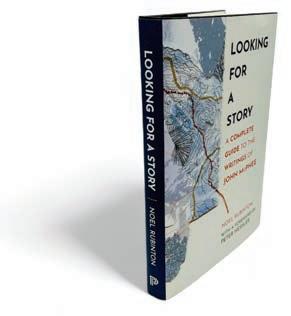
One classmate in particular was excited about the idea from the start, and to the class’s great surprise and honor, he volunteered to fund the first printing of 5000 copies—a gift of nearly $20,000! An endowed fund to finance the remaining years will require an additional $100,000.
Here’s the best news for all alumni and friends of Deerfield: You don’t need to be a member of the Class of 1980 to contribute to the fund; simply reach out to Deerfield’s Office of Advancement (advancement@deerfield.edu) and let them know that you would like to contribute.
As the class gift reads: “The Headmaster captures the genius, the common sense, the leadership, the sometimes hubris, of this great giant of a man, who was so small in stature: Frank L. Boyden. Providing the book to all current and future members of the Deerfield community will help preserve Mr. Boyden’s memory, and his original vision for our school, for generations to come.”
Earlier this summer, a group of Deerfield singers traveled to New York City to help celebrate the 95th birthday of John Rosenwald ’48 —an iconic figure on Wall Street and a devoted Deerfield alumnus. The event, held at the New York Stock Exchange, brought together an impressive guest list to honor Rosenwald. Led by Choral Director Mike Pfitzer, a group of 15 students performed a selection of songs—including, of course, the Evensong —during the opening hour of the celebration. After a brief intermission, the singers returned to close out the evening by leading the group in a spirited rendition of “Happy Birthday.”
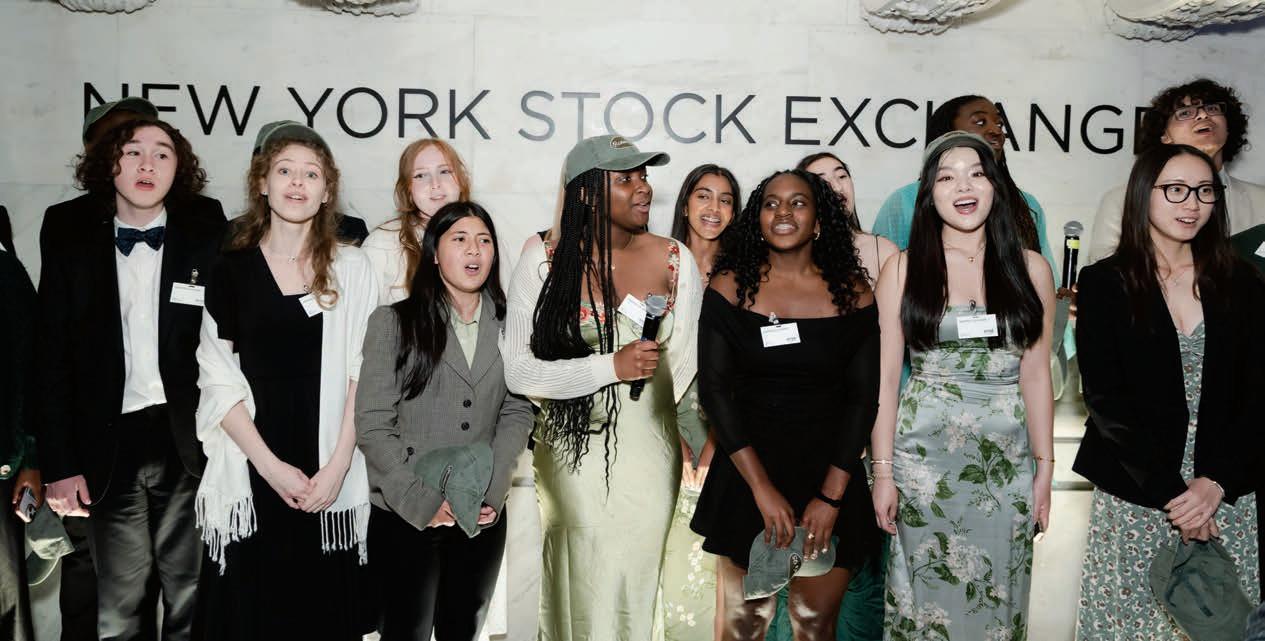
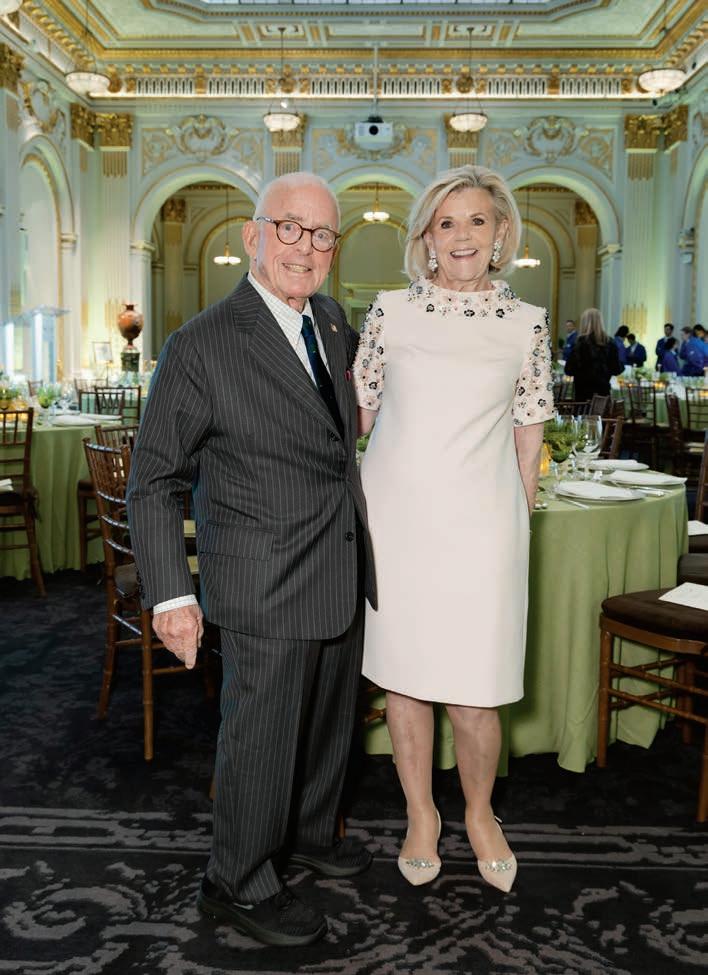







/// by Lori Ferguson ///
She’s worked with established franchises including the superhero action thriller Agents of S.H.I.E.L.D. and the legal drama Suits and created original series as well. Among her forthcoming projects: a revival of Bu y the Vampire Slayer and a new series based on Tess Gerritsen’s novel The Spy Coast. Regardless of whether she’s slipping into an ongoing story or breaking new ground, Zuckerman says she’s always asking herself, ‘How can I make this story more interesting?’
Zuckerman gravitates to storylines that center on crime, mystery, and complex characters, subjects she finds compelling as a fan and a viewer. “I love to be in creative situations where I’m writing stories that I couldn’t write in any other place,” she observes. She cites, for example, the quirky talent of Poker Face protagonist Charlie Cale (played by actor Natasha Lyonne)—Cale possesses a preternatural ability to tell if someone is lying, which gives her a special knack for solving crimes. “This skill creates a lot of fun problems and solutions for her character and makes writing the shows much more challenging and creatively fulfilling.”


Whether penning plots for a supernatural drama like Haven or drafting dialogue for crime procedurals such as Prodigal Son and Poker Face, screenwriter and producer Nora Zuckerman has had a hand in crafting some of the most compelling stories to come out of Hollywood in recent years.
Zuckerman tackles these challenges with her sibling and creative partner Lilla Zuckerman. “We’ve always been close, and our partnership is beneficial because we have a shared history and understand one another’s tastes,” she says. Collaborating with her sister has also sharpened her professional skills, notes Zuckerman. “Our collaborations have taught us to operate e ectively in writers’ rooms. Between the two of us, even if we argue, the best idea wins, which is true in the writers’ room as well. Our partnership o ers us a safe space to explore innovative ideas and fosters a healthy sense of competition, which has led us to write some cool stories.”
While Zuckerman admits the environment for screenwriters is incredibly competitive, she maintains that myriad opportunities remain and encourages emerging writers to lean into their craft. “Keep writing and absorb as much good writing as possible,” she counsels. “Read scripts online—they’re readily available—and watch as many shows as possible. Analyze plot lines, explore why stories work (or don’t), and never rest on your laurels. Sometimes it’s just a matter of finding the right place for your voice.”
“I leaned into all my English classes, but it was a class with Ms. Hannay in my junior year that truly encouraged me. I submitted a piece, and she said, ‘You could get published.’ She was the first person to read something of mine and offer that sort of feedback.”
Writing a spec episode is another good way to learn and garner attention, Zuckerman adds. While it’s not as common an approach to breaking through in the business as it used to be, it’s still a worthwhile exercise. “Lilla and I wrote a spec episode for Dexter while participating in a Warner Brothers television workshop and found the exercise incredibly valuable,” she recalls. “Emulating a script you like can teach you why and how things work; it’s a great training tool.”
Zuckerman knows something about diligence and persistence; she’s been honing her craft since her teens. “I entered high school interested in writing, but I really focused on film and television at Deerfield,” she says. “I leaned into all my English classes, but it was a class with Ms. Hannay in my junior year that truly encouraged me. I submitted a piece, and she said, ‘You could get published.’ She was the first person to read something of mine and o er that sort of feedback. It was so encouraging.” Zuckerman also fondly recalls a senior year film studies elective with Mark Scandling. “I just devoured that class,” she says with a chuckle.
Deerfield was a fantastic training ground for her career in many ways, continues Zuckerman. “I loved being around other people who were serious about learning,” she observes. “Everyone was ambitious and focused on their education; the school felt like a safe place to explore ideas.” And the Academy made her take education seriously, she insists. “I arrived as a green, 14-year-old freshman and grew tremendously over the following four years.”

By the time she graduated and headed to film school at the University of Southern California, Zuckerman was ready to leverage her college years to the best advantage.
“In many respects my experience at Deerfield made college a breeze,” she observes. “I was used to making friends and carrying a heavy class load, and I was trained to absorb knowledge and feel comfortable discussing ideas.” To wit, Zuckerman recalls her first time in a college writing class. “We were sitting around a table talking about the material and it felt natural, just like an English class at Deerfield. And now I feel the same sitting around a table in a writer’s room.”
Nor is taking her spot around the writer’s table the only thing that evokes memories of Deerfield, she adds. Zuckerman often crosses paths with Deerfield alumni when circulating amongst L.A.’s creative community. “I ran into Mike Sucsy ’91 the other day—he’s a director—and I frequently see Heather Mitchell ’93, a friend and television writer who has worked for Shondaland. And during awards season for Poker Face I bumped into Dominic Sessa ’22, who was terrific as Angus Tully in the 2023 film The Holdovers.”
Zuckerman says she would love to see more Deerfield alumni follow in her footsteps. “I think more people should consider pursuing a creative career path,” she concludes. “It’s hard work, but incredibly rewarding.”//


Ted
Brick Church / Deerfield Academy / June 8, 2025
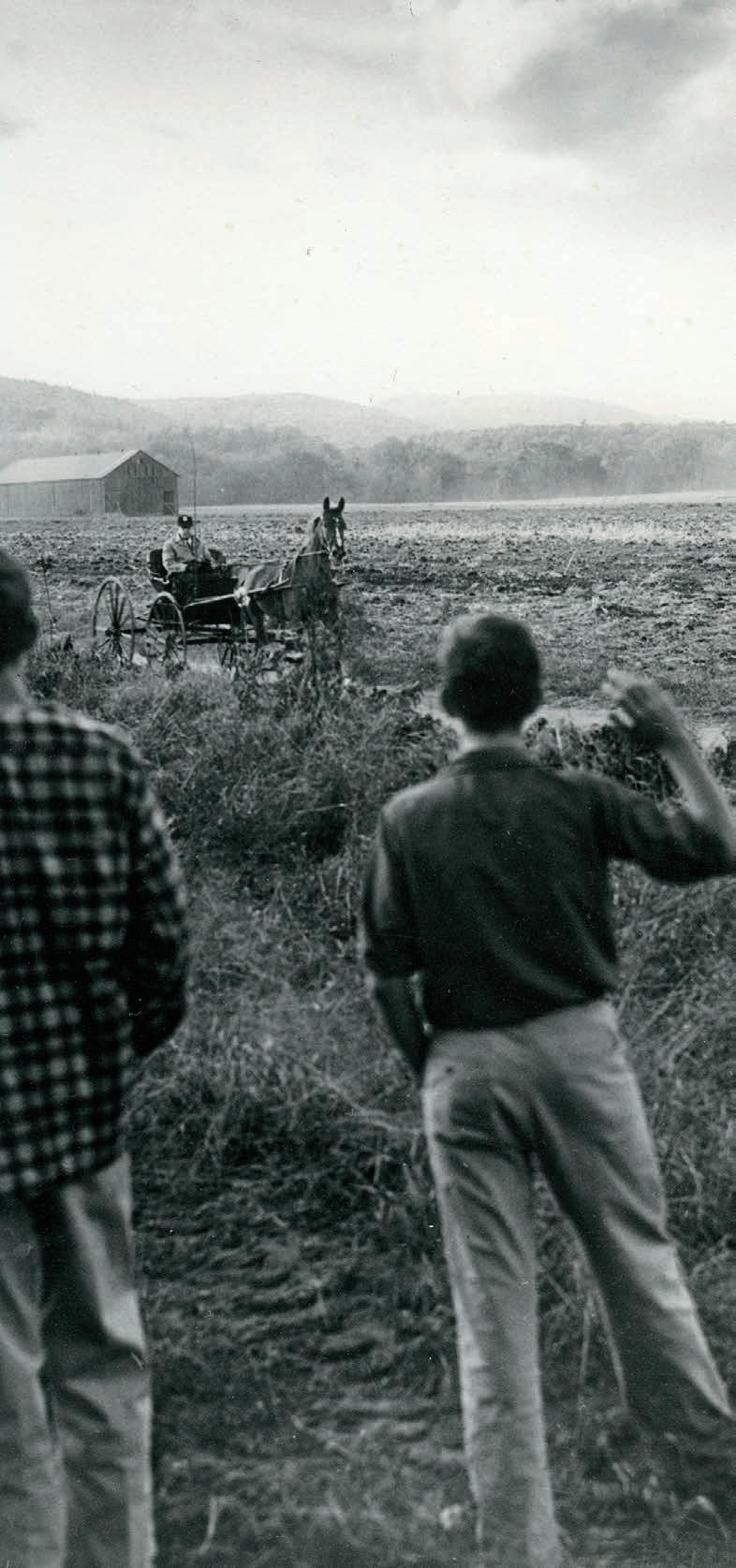
It’s wonderful to be back in the old Brick Church and in Deerfield. On behalf of our family, I want to thank all of you for being here. Many of you came from a great distance.
I sometimes feel a twinge of regret that I did not attend Deerfield, as my dad, I think, hoped.
I did visit, and I could see that this exquisite campus had everything a teenage boy could want— except, of course, the thing a teenage boy MOST wants, which is a chance to talk to a teenage girl.
So I went to a Quaker school in RI, which allowed me to quake in my boots every time a teenage girl came near.
I’d like to reflect briefly on my dad’s remarkable life; which was profoundly shaped by his four years at Deerfield in the 1950s. They were transformative. As he wrote, in a letter to the community, while headmaster, “My time at Deerfield was a seminal time, by which I mean the seed for all of my future development was sown here.”
It so easily might never have happened. He was not naturally destined to go away to boarding school. He came from the wrong demographic in many ways. He grew up in a small, fatherless, academic family in northeastern Connecticut; where his mother had founded the School of Nursing at UConn. He lived with her and his older brother in Storrs—now renowned as a place that breeds national champions in college basketball—but then a very small town, in a rural part of the state, with more barns than college buildings. He later recalled that he had no knowledge of any other boy from Windham County, or any part of eastern Connecticut, who had gone away to school.
In fact, there is a photo, in John McPhee’s book, TheHeadmaster, that shows Mr. Boyden in his buggy, receiving a wave from a young man who looks remarkably like my dad.
But he had hopes of enlarging his horizons. He came from a long line of missionaries and educators in the Middle East, many of whom spent most of their lives in another country. He was born in 1940 in Beirut, Lebanon, where his parents worked at the American University of Beirut. The first words he heard were in Arabic, spoken by a nurse. He arrived in America after a long and dangerous passage across two oceans, to avoid the German troops menacing the Middle East. So his intellectual equipment naturally included a desire to think about the world in all of its complexity.
Also, it was clear that there were limits to how far he could go in Storrs. His first job, as a teenager, was with a local road crew . . . he had to hold a sign that said “Slow” on one side and “Stop” on the other. That said a lot about the possibilities available in Storrs.
So for the first of many times, he decided to encounter the world. He and his mother drove in her old Studebaker to Deerfield, where they met the legendary headmaster, Frank L. Boyden.
A spark was ignited during their meeting; as my grandmother later remembered, Mr. Boyden said, “I like that little feller!” It may have been simply that the Quid, as he was known, recognized another youth of talent, growing up in a forgotten pocket of New England, as he had, half a century earlier. Or perhaps there was more to it, a kind of kinship . . . Mr. Boyden’s grandfather had spent much of his life overseas, in Japan, as a missionary.
In any event, the Quid admitted the Wid, and changed his life forever.
Still, it was nerve-wracking to leave Storrs for a big prep school. To get ready, my grandmother bought him a corduroy blazer, glaringly red. As they drove to Deerfield, he felt butterflies in his stomach, then asked her to pull over, so he could empty his stomach on the road’s shoulder. After taking care of that, he looked up, and saw a sign.
“Welcome to Belchertown.”
But Deerfield embraced him, and vice versa, and here he began his lifelong understanding of what a school community can do to lift up a lonely student.
Much of it was attributable to Mr. Boyden. The Quid had been here 51 years, since 1902, and he was still rolling around the Pioneer Valley in his horse and buggy. In fact, there is a photo, in John McPhee’s book, The Headmaster, that shows Mr. Boyden in his buggy, receiving a wave from a young man who looks remarkably like my dad. The year given is 1953, my dad’s first year at the Academy, when he probably needed a nod of encouragement from the Quid. I can’t say for sure that it’s him, you can only see him from behind, but the resemblance is uncanny.
Deerfield had become one of the great schools, as McPhee’s profile makes clear, and was intimidating in many ways. But McPhee argues an important point about the Academy’s democratic ethos.
“A new boy at Deerfield cannot have been there very long before the idea is impressed upon him that he is a part of something that will not work unless he does his share. The headmaster is able to create this kind of feeling in his boys to a greater degree than most parents are. All boys are given an equal footing from which to develop their own positions. There are no special responsibilities for scholarship boys, such as waiting on table. Everyone does that. In fact, the headmaster insists that scholarship boys not be told that they have scholarships, since that might injure the sense of equality he tries to build.”
I think my dad would want it said here today that HE was a scholarship student. When my grandmother wrote to Mr. Boyden, with some anxiety, about tuition, he replied, “pay what you can.”
My dad later wrote, ”I knew I had been given an opportunity that we could not have otherwise have a orded, and making the most of it was the only way to redeem the investment Deerfield had made in me.”
This quiet egalitarianism pervades McPhee’s book, and explains Deerfield’s remarkable ascendancy in the 20th century. It didn’t become great merely because it taught its classes well, or fielded good sports teams. It became great because it taught character . . . cooperation . . . decency. It built trust.
It was an indigenous institution—McPhee uses that word. It drew strength from its environment, including the food grown plentifully on local farms, and the neighborly spirit of the Valley, and perhaps even a few older memories of the democratic eruptions of earlier centuries, like Shay’s Rebellion in the 1780s, or the Great Awakening of the 1740s.
At any rate, something profound happened here to my dad, between 1953 and 1957.
It was not simply an education; although he certainly received one, from extraordinary teachers.
It was not simply growth, although that too, was indisputable. He grew big and strong, from limitless servings of Deerfield food. The earliest mention of his name in the New York Times came on October 16, 1956, when an article about Deerfield’s undefeated football team predicted that he would see action in the backfield in an upcoming game against Hotchkiss.
He did not grow as a musician. As a freshman, he was proud to secure the seat of the third trumpeter in the band. Four years later, as a senior, he was still holding down the same seat.
But in every other way, it was a Great Awakening all his own. That included his own deeply ingrained egalitarianism, his curiosity about other cultures, and a growing sense that the world could be better if it were simply . . . more like Deerfield.
So, for the rest of his life, that’s precisely what he tried to do. At Brown he became Dean of Student Life, and in that position helped Brown to achieve its remarkable surge of the 70s and 80s, as it began to compete with Harvard, Yale, and Princeton precisely because it gave students more freedom, responsibility, and trust.
Great students were suddenly clamoring to be let in. As Dean of Admissions, it was his delight to do just that, and to build Brown into the best university it could be. In 1993, he gave an interview to the Times in which he explained that Brown wanted to know “the sentient human being behind the application.” “Sentient” . . . the perfect word. Again, traces of Deerfield.
The students felt his joy in their sentience; he was always one of the most popular deans on campus, especially when Dean Widmer did his impression of Dean Wormer in Animal House.
Then he came to Deerfield in 1994, the first alumnus ever to head the school. Jaded Deerfield students must have been confused by this new headmaster, who remembered all the Academy songs of the 1950s and insisted on singing them all the time, at loud volume, to build school spirit.
Even the Deerfield faculty, I think, were astonished by his enthusiasm. After he was hired, he went to see a favorite teacher, Bob Merriam, his old JV lacrosse coach. He drove over to his house in Conway. Mr. Merriam was out on his front lawn, mowing the grass. My dad said, “It’s great to see you, Mr. Merriam.” Mr. Merriam replied, “It’s great to see you too. Who the hell are you?”
But if he loved the old Deerfield, he was also thrilled by the new Deerfield. Having spent all of those years at Brown, he was no stranger to diversity, and embraced it in every way, finding sentient students from an increasingly global pool of applicants. He cherished his memories of Mr. Boyden’s egalitarian ways, but infused them with vigor for a new century.
He was always open to new ideas. One was that we need to be better stewards of our environment. I was amazed to come across an advanced statement of environmental principles, the “Deerfield Declaration,” in a book he co-edited, Owned by the Land: Global Education and the Environment, which stemmed from a visionary conference held here in 2000.
Another newish idea was that this academy, once intensely local, was growing into a great global community. When Frank Boyden came to Deerfield in 1902, the Academy had a grand total of 14 students, two of whom constituted the entirety of the senior class. A hundred years later, there were alumni on every continent, and my dad’s annual letters to the community revealed a deep sense of connectedness to the wider world.
One letter mentioned this church, and said that it had become a sanctuary in the days after 9/11. That tragedy a ected him greatly; it a ected all of us. But his letters to the community helped. One quoted an earlier letter, written by Mr. Boyden as the second world war was beginning.
“We have preserved those fundamental, high traditions of character and scholarship on which our school was founded, and none of the vital things which have given a feeling of permanence and security have been lost or changed. We still study and work, play and sing, and pause to look up to the hills.”
It could be di cult to a rm uplifting sentiments like that in the wake of 9/11 and the wars that followed. But once again, Deerfield was the nursery of deep thinking.
Psalm 45 tells us, “Instead of thy fathers shall be thy children, whom thou mayest make princes in all the earth.” My dad wanted all of his students to feel like they were the equals of royalty; but even in this very democratic environment, there occasionally surfaced an actual prince, or even a king.
That was the case during the alumni celebrations, 25 years ago this weekend, when the class of 1980 celebrated its 20th anniversary, and one of its members stayed in the Manse for long talks with my dad.
The talks nearly didn’t happen, because King Abdullah’s security detail managed to lock my dad and Meera out of their own house. But they recovered from that setback, and a conversation followed with, as it turned out, global consequences.
King Abdullah had only recently assumed his new responsibilities in Jordan, but already he was thinking about launching a progressive boarding school in the Middle East, to bring new ideas about egalitarianism and trust into a region that needs a constant tutorial in each. In other words, he wanted a “Deerfield in the Desert,” to quote a New Yorker article about the project.
They had an instant rapport, and as the conversation continued, it became clear that my dad would go to Jordan to become the first headmaster of King’s Academy. In 2006, he and Meera went over, and enjoyed nearly a decade of great happiness there, along with Matt, building a campus, a school, and a community.
There were challenges. It wasn’t easy to bring Deerfield idealism to so vexed a region, especially in the aftermath of the Iraq War. It wasn’t easy to promote ideas of diversity and female empowerment in a part of the world that has spent thousands of years focusing on historical grievances instead of future possibilities. But it was thrilling to apply his beliefs about the good society in a place that so desperately needs to believe in exactly that.
As the Deerfield Declaration of 2000 says, “We recognize the indivisibility of our world; we are one earth community, di erent but interdependent.”
It was also a chance to invent new school traditions, and to write school songs, the job he was born to do. He loved working out complicated puns relating to monarchy. The school newspaper was The Rexonian—after the Latin “Rex” for king. The school needed mottoes and uniforms and school ties—this was all in his wheelhouse, thanks to Deerfield.
With such a solid foundation, Kings Academy thrived from its first day, and is now approaching its 20th anniversary. We had a wonderful celebration of my dad there two weeks ago, and we deeply appreciate all the ties that continue to connect Kings with Deerfield.
I will end with another Biblical quotation. The Psalmist tells us (Psalm 1:3) “he shall be like a tree planted by the rivers of water.”
That seems to describe this proud son of Deerfield, in a place watered by two rivers, a place that meant so much to him. It is likely that the original verse described the Jordan River.
Thank you for today’s remembrance, and for all that Deerfield did to invest in my dad, and turn a quiet 13-year old from rural eastern Connecticut into a citizen of the world. //
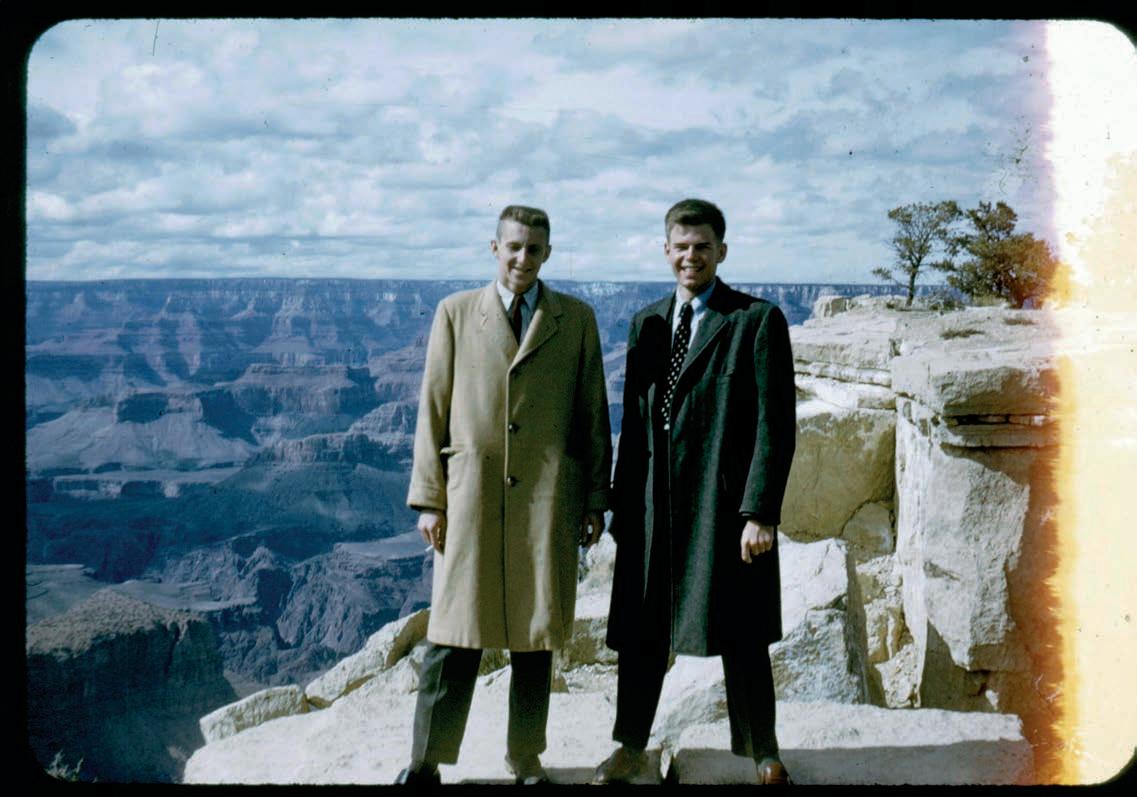

Stephen E. Chalmers / Born in Evanston, Illinois, to Roberta Teale Swartz Chalmers and Gordon Keith Chalmers, the youngest of four children. He grew up at Gambier, OH, where his father was President of Kenyon College and where both parents founded The Kenyon Review in 1939. Schooled in the public schools at Gambier and Mt. Vernon; then at Deerfield Academy (1959). He earned his BA from the University of Ohio at Athens. He enlisted in the U.S. Army and was posted to Bavaria in Austria and honorably discharged in 1968. His professional career began with Sylvania and GTE in Massachusetts, and finished with Boeing International in Palm Bay, FL, working as a proposal and project manager in Africa (Cameroon and Algeria) and in the US (Massachusetts, Florida, and Oklahoma).
He pursued birds, photography, golf, and recreational and competitive sailing—Newport to Bermuda including two transAtlantic races all with Arthur B. “Tim” Hanson on Foolscap (formerly Figaro III), to Cork, Ireland and Travemünde, Germany. He cruised westward on the Erie Canal with Richard Piekos and Camila Cavalcante on Beleza in 2019.


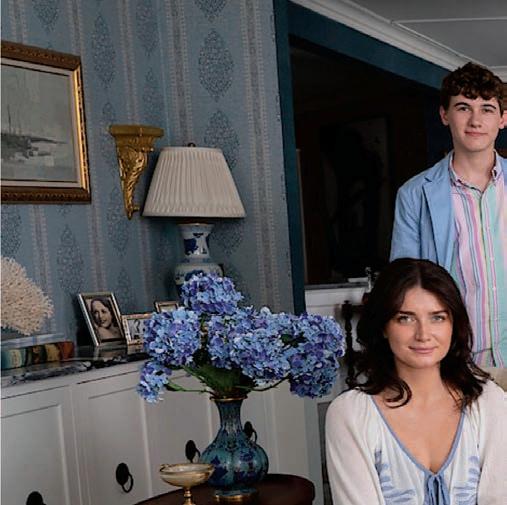






Seven minutes into Episode 4 of the Netflix murder mystery
The Perfect Couple, two characters walk along a Nantucket beach, getting to know each other.
“Benji and I were roommates at Deerfield,” one says.
It’s a small detail, but like many others in the show, it’s rooted in real life, thanks to Holly Whidden ’97.
As a consulting producer on the six-episode series, Whidden’s job was to make sure the series—based on a novel by Elin Hilderbrand—authentically depicted Nantucket life. Starring Nicole Kidman and Liev Schrieber, The Perfect Couple climbed to No. 1 on streaming charts last fall and became one of the most-watched Netflix series of 2024.
Holly’s job was to get every detail right, from wardrobe choices and background art to backstories and dialogue. She even added a tribute to Jimmy Buffett, one of Nantucket’s own.
Growing up, Whidden spent summers with her family on their boat, NorthLight, docked on the island. “Jimmy was often there too on his boat Last Mango,” she says, “and he and my dad would take off deep sea fishing on many August days. I have known Jimmy my whole life. He was one of my dad’s closest friends.” Buffett’s longtime captain sent a Last Mango shirt, which makes a cameo. “Blink and you’ll miss it,” Holly says, “but every Nantucketer recognizes the tribute.”
When director Susanne Bier started work on the show, she turned to Whidden for insight: Why are grown men wearing pink pants? Holly explained Nantucket Reds to the Copenhagen-based Bier. “Nothing pulls you out of a story more quickly than a lack of attention to detail,” Whidden says. From their time working together on HBO’s The Undoing, she knew that Bier is meticulous.
That care extended to the props. Take the book party scene, which features iconic Nantucket baskets. “The coveted ones are the darker, aged baskets,” Holly says, and the show used a range of baskets—from light to dark—to hint at who’s a longtime islander and who’s not.
Showrunner Jenna Lamia also gave Whidden room to showcase local institutions like Nantucket Community Sailing, a nonprofit that offers affordable public access to the activity. Whidden included North Sails gear in the series—a nod to her father, Tom Whidden, a professional sailor and three-time America’s Cup winner who owned and ran the company for years.
Holly traces her interest in producing to Deerfield, where she took a film class taught by Mark Scandling her senior year. The students watched Citizen Kane and tried out movie-making. “I remember cutting a film together in the library with editing machines and absolutely falling in love with it,” she says.
HOLLY TRACES HER INTEREST IN PRODUCING TO DEERFIELD , WHERE SHE TOOK A FILM CLASS TAUGHT BY MARK SCANDLING HER SENIOR YEAR. THE STUDENTS WATCHED CITIZEN KANE AND TRIED OUT MOVIE-MAKING.
“I REMEMBER CUTTING A FILM TOGETHER IN THE LIBRARY WITH EDITING MACHINES AND ABSOLUTELY FALLING IN LOVE WITH IT,”
Early in her career, Whidden worked at Paramount Pictures. She went on to Hearst Magazines, where she ultimately led the entertainment division. Her team was responsible for cover shoots for every Hearst title, from Cosmopolitan to Esquire to Oprah They also developed TV projects for the company.
One of those projects became The Bold Type, a scripted series about three young women working at a Cosmo-like magazine, loosely based on the experiences of Holly and her friends. She served as a co-executive producer through its five-season run on Freeform. The series resonated so strongly with viewers that thousands of young women in Brazil invited Whidden to join their 2021 finale watch party on Zoom. “That was hands down one of the most amazing moments of my career,” Whidden says.
Another was her final Hearst cover: Bruce Springsteen for Esquire during his Broadway run. “It was a closed set at the Walter Kerr Theatre, maybe five of us,” Holly remembers. “When photographer Alexi Lubomirski would break to set up new shots, Bruce would sit at the piano or grab his guitar and sing. Not sure I have words for that day!”
Whidden got the idea for The Bold Type during a 2014 Katy Perry cover shoot. Cosmo’s 68 international editions featured the same cover photo for the first time, which meant navigating editors’ content guidelines and limitations worldwide. “It was a long day on set trying to figure all that out,” Holly recalls. At dinner afterward, producer David Bernad—who’d later work on The White Lotus—said to Whidden, “We should seriously think about doing a TV show.”
It turns out that producing a television series is not so different from producing a magazine shoot. Both start with the same question, Holly says: “What’s going to be interesting to the audience?”
Audiences found The Perfect Couple plenty interesting. Netflix renewed the show for a second season with a new cast and storyline set on Nantucket and based on another Hilderbrand novel, Swan Song. Holly Whidden can’t wait. //

Bob Beane (seated) and wife Peggy Sherlock Martin graciously hosted Bob Opel (standing left) and Tom Snell (standing right) on a visit to Sedona and Phoenix, AZ. Much reminiscing about cross country races on the hill course followed by munching fresh apples supplied by Peter Brush.
Most importantly Steve supported the Marine Resources Council in Palm Bay, FL, serving on the Board of Directors for thirty-six years. In a December 23, 1991 article in Florida Today he was quoted: “My interest is that our community makes informed decisions today for cost and spiritual benefits in the future.” He received the Council’s Stan Blum award in 2019 for Outstanding Volunteer Climate Change Initiative.
Throughout his life Steve maintained an enthusiastic interest in the sciences and shared this with everyone. He wrote poems. He corresponded with Robert Frost and quoted Frost’s poetry, especially “Once by the Pacific.” Another favorite was Walter de la Mare’s “The Listeners.”
He was predeceased by his wife of 48 years Maryanne Dombkowski (2024) and his sister Ann Chalmers Watts (2021). He personally provided twenty-four-hour care for Maryanne for the last dozen years of her life. He is survived by his brothers Geo rey Teale Chalmers and John Putnam Chalmers; his nieces and nephews Gordon Thomas Watts, Christopher Lardner Chalmers, Vivien Maynard Watts, Carrie Teale Chalmers, and Sarah Keith Simmons; grandnieces and grandnephews Julia Robin Heron Watts, George Jarvis Watkins, Theodore Sky Chalmers, Samuel Everett Simmons, Tobin Teale Chalmers, Desmond Kelly Watkins, River Fontaine Chalmers, and Maryanne’s nephew Mark Dausch and his daughter Anna.
A memorial celebration is being planned. Steve encouraged anyone who would listen to support the Marine Resources Council, to which memorial gifts can made at: lovetheirl.org/ or by US mail to MRC, 3275 Dixie Highway, Palm Bay, FL 32905.
Coming in from Cooperstown for the Third Time
“The headline above refers to the fact that Patty and I are once again living in Cooperstown, NY. The first time was for graduate school, where we first met; the second time was during the 1980s and 1990s, when I was working for The Farmers’ Museum, Fenimore Art Museum, and Cooperstown Graduate Program; and most recently we landed here in 2018. During the early 2000s we lived in Newport, RI, where I was in charge of the museums of the Newport Restoration Foundation, retiring in 2015. Newport was a delightful place to live, but as often happens with islands, the various costs of living tend to rise to an alarming degree. Hence, back to upstate New York. Our older son is a professor at Vanderbilt University, and our younger son worked at Deep Springs College, where he worked his way up to the position of Vice President. Through no e ort on our part, he and his family moved here three years ago, after he had secured a position as Director of Operations for The Clark Foundation. I keep busy with a couple of low-pressure volunteer tasks in our village, and the occasional pro bono consultation for museums. I have maintained a lifelong interest in sportscars and racing (the latter, only as a spectator) in such venues as Lime Rock and Watkins Glen; some say, ‘It is never too late to have a happy childhood!’” —Bruce MacLeish
For our third annual DA ’77 Class ski trip, Jim Wade continued his amazing organization with our regular lodging, driveron-demand, and in-home massages. Our new addition, Bill Gramm, joined us, and ski conditions were perfect with sunny skies in Deer Valley and Park City, UT. Stewart Day had to leave due to an unfortunate mishap on Day 1, but our gang included (l to r) Jim Gilmore, Jim Wade, Wayne Wall, Tucker Smith, Andy Ling, Bob Dewey, Dave Martin, (back row) Tom Mallory, Bill Gramm, Hamilton Davidson, John Curtis (up on the mantle), and Jim Gilbane (on the table hanging out).

“Greetings from the Pacific Northwest, where I now live in Olympia, WA, after living all but six years of my life in New England. All is well with my growing family and me (four grandkids and counting). After having such a special time at our 50th in Pocumtuck Valley in June 2023, I am really looking forward to the Great Class of 1973’s mini-reunion at the historic and opulent Omni Mt. Washington Resort in Bretton Woods, NH, on August 24-27. The mini-reunion is not an “o cial” DA event, so if you want to know more or attend (it’s never too late), reach out to Leader Tuck, Larry Jerome, or me.”
—Peter Van Oot
“Having recently retired after 30 years of active duty in the US Public Health Service, I have relocated with my family back to South Deerfield. In fact, we have purchased the family home of my best friend and fellow classmate, John Stobierski. It’s great to be back home in the Valley and we look forward to everything that the area has to o er, including more time spent at the Academy. It’s a bit surreal running into old friends who I grew up with after 40 years away, but it’s wonderful nonetheless. The biggest benefit is no tra c! After having spent 30 years on the DC Beltway, I’m ready for this!” —Mike Noska

Tate Huffard
BREWER + ENTREPRENEUR

THIS IS THE STORY OF A DEERFIELD ENTREPRENEUR WHO TURNED HIS NONALCOHOLIC BEER INTO THE FASTEST-GROWING BRAND IN A CROWDED MARKET. IT'S ALSO THE STORY OF A FUNDAMENTAL SHIFT IN CONSUMER BEHAVIOR.



In 2016, when Tate Hu ard ’05 got the idea for Best Day Brewing, nonalcoholic beer was a punchline—or, as Hu ard puts it, “a signal that things had gone sideways.”
After their workday in the San Francisco Bay Area, Hu ard and his friends liked to unwind with a beer. Before the next day’s work, they liked to surf at Ocean Beach.
“In my 20s, the math was simple,” Hu ard says. “When I rounded the corner into my 30s, that calculus started to change.”
The hangovers hit harder, and surfing at six am was a heavier lift.
Unwilling to give up the outdoor lifestyle, Tate and his friends opted to skip alcohol on weeknights.
“Back then, if you told a craft brewer, ‘I’m interested in nonalcoholic beer,’ they’d look at you like you have five heads,” he says.
At the time, Huffard worked at American Giant, the clothing manufacturer Bayard Winthrop ’87 founded. Following stints in finance and tech, Hu ard loved being part of a company that made something so tangible, “a full-zip hooded sweatshirt that was made in America, told a story of quality, and had its own personality,” he says.
He saw the same opportunity in nonalcoholic beer. “The world didn’t need a slightly better O’Doul’s,” he says of what was then the bestknown brand. The world needed a fundamentally di erent product.”
In 2022—after six years of research and development, plus a marriage and two (now four) kids— Hu ard and his dog delivered the first cases of Best Day beer to a pizza shop in Sausalito, Califorina.
As proud as he is of the taste, Tate is equally proud of the brand. He wanted Best Day to feel lighthearted and fun—like living in California.
This brings us back to consumer behavior.
Nonalcoholic beer used to be stagnant at 0.3 percent of total beer sales. “Now we’ve crested one percent, and five to ten percent is on the horizon,” Hu ard says. In some grocery stores, nonalcoholic beer represents as much as 20 percent of beer sales.
“I still drink,” Tate says. “Ninety-four percent of people who drink nonalcoholic beer still drink. This is totally di erent from what nonalcoholic beer used to be.”


Since then, Best Day has experienced explosive growth, including 100 percent growth in 2025, and they’re on track for another 100 percent growth year; in short, they are the fastest-growing nonalcoholic beer in the US. Today, Best Day is available in nearly 40 states. It’s at Whole Foods, Trader Joe’s, Costco, and aboard Alaska Airlines. It even ran as a Super Bowl ad in some regions this year.
There are two ways to brew nonalcoholic beer: one process minimizes the alcohol from the start. The other, which Best Day uses, is to make a full-strength beer and extract the alcohol.
“That leaves you with all the flavor, all the aroma, all the mouthfeel you look for in a beer,” Hu ard says.
Among the reasons for the shift, Hu ard credits wearable sleep trackers that show better rest without alcohol, as well as the Surgeon General’s recent warning about links between alcohol and cancer.
Best Day now employs 50 people, including veterans from Molson Coors and Red Bull, a nationwide sales and marketing team, and two manufacturing facilities.
He counts several Deerfield alumni as investors or advisors. “So much of who I am comes from Deerfield and what it stands for,” he says, including the value he places on getting out in nature. “I think back to the time spent wandering along the river and hiking with friends or faculty.”
Deerfield also prepared him for the realities of a start-up—the wrong turns and course corrections like that first delivery. The oven took up most of the store at the pizza place in Sausalito, and the beer sold so well that the owners placed it beside the cash register. Then Tate got an all-caps text: PLEASE COME BY.
THE BEERS ARE EXPLODING. The early iteration of Best Day was heat-sensitive, and whenever the oven door opened, 600-degree air blasted the cans. “They were shooting o into the ceiling,” Hu ard says.
At the time, he thought that was the end of Best Day.
“Sure enough, you go back, you work on it, you solve that problem, and you’re onto the next thing,” he says. “The biggest challenge with a start-up is sticking with it.”
Today, he still meets skeptics of nonalcoholic beer—and he sticks with it. “My favorite thing to do is send them a six-pack. I’ll say, ‘Put it in your fridge. You’ll figure it out.’” //

Austin Macauley, 2025
According to BookTrib, A Family of the Old Russian Empire is a beautifully written and deeply personal account of Stanislas Yassukovich’s family: scattered by the Bolshevik Revolution, lost to history for generations, and miraculously rediscovered through fate and archival detective work.
The book’s early chapters transport readers to imperial Russia at the dawn of the 20th century. The Yassukovich family, steeped in nobility and military tradition, resides in a grand apartment in St. Petersburg. The author’s grandfather, Mikhail Stanislavovich Yassukovich, is a military engineer and professor; his father, Dimitri, a promising cadet. It’s a household of discipline, order, and privilege. That world unravels swiftly and violently with the Russian Revolution of 1917. Mikhail is abroad on a military procurement assignment in the United States when the Bolsheviks seize power, effectively saving his life. His wife and children remain in Petrograd, navigating the sudden transformation from elite citizens to “former people”—a Soviet term for those stripped of rights and status. The family’s two daughters, Irina and Marie Magdalena, each face their own fates: one marries and stays behind in Russia, the other escapes to Poland. Meanwhile, Dimitri flees across borders and eventually lands in New York, where he begins anew.
It is Irina’s fate that lies at the heart of this book. For decades, she was presumed to have perished during the revolution or its aftermath. But as Yassukovich reveals, her story was far from over; many years later a message arrives from Russia. A woman named Alla Semenova believes she may be related to the Yassukovich family. Through a series of email exchanges, photographs, and historical breadcrumbs, Yassukovich uncovers a truth more astonishing than fiction: Irina survived. She lived through the worst of the Soviet regime. She raised a family. And her descendants were now reaching across history to reconnect.
What follows is an extraordinary voyage of rediscovery. With the help of scholars, cousins, and archivists, Yassukovich pieces together the missing half of his family tree. As the narrative stitches the family back together, we witness not only a reunion of people, but a reconciliation with the past. It’s a reminder of how much can be lost in a single generation, and how much joy can be found in its recovery. //

Peace Corps Writer, 2025
In his ninth novel, David Mather departs from his Cresent Beach Series and sets When the Land Belonged to God in the year 2080, amid giant domes and characters who must wear “bubble-helmets” to protect themselves from horrendous dust storms; a time when androids do most work, and over ninety percent of wildlife is extinct.
Exhausted by the dystopian landscape and his dysfunctional homelife, Steven Masters, history buff and the largest producer of virtual reality programs in the US, decides to escape to a simpler—and much more beautiful—time. He has his engineers design a program in which he is able to join Lewis and Clark and the Corps of Discovery on their journey to the Pacific Ocean and back. He soon becomes addicted to the VR program, bonds with the men on the expedition, and even falls in love with an Indigenous woman named Slender Doe. Masters dreads returning to his real life when he is rocked by the program’s conclusion.
Including an afterward that highlights historical facts— such as they are—When the Land Belonged to God imagines both a past and a future where both life and love find a way in the midst of tragedy and events outside of one’s control.
David Mather “lives off the grid” in New Hampshire, and can relate to the grit and determination of Lewis, Clark, and the Corps of Discovery; it was their pristine world that inspired this latest novel. //


Viking, 2025
At fourteen, Laura Delano ‘01 was diagnosed with bipolar disorder, marking the beginning of a personal story rooted in pathology, chemical imbalance, and medication. What followed was not healing, but a slow unraveling: years lost to side effects and confusion, and a system seemingly more invested in managing her than understanding her. Unshrunk is the account of how Delano broke free from that narrative. With clarity and conviction, she reveals the toll of overdiagnosis and overmedication—and how easily the self can vanish within a system that promises help but often deepens harm. This memoir challenges entrenched assumptions about mental health treatment in America. Delano’s story resonates because it is alarmingly familiar; what sets her apart is the courage to question everything—and the eloquence to share what she discovered.
Laura Delano is a writer, speaker, consultant, and the founder of Inner Compass Initiative, a charitable organization that helps people make more informed choices about psychiatric diagnoses, drugs, and drug withdrawal. She is a leading ex-patient voice in the international movement of people who’ve left behind the medicalized, professionalized offerings of the mental health system to build something different. Laura works with individuals and families around the world seeking guidance and support for the withdrawal journey and life post-psychiatry. //
She Writes Press, 2025
Casch Abbey is a waitress, single mom, and recreational boxer who falls in love twice: first with a veteran who secretly grows pot on a rich man’s land in Vermont’s Green Mountains, and then with a painkiller that eases her long-buried pain.
After her foot is crushed under the wheel of a station wagon, Casch loses her waitressing gig and goes broke—and the meds for her foot are her only source of relief. But when the drug is recalled due to outcries of widespread addiction, Casch’s dependence imperils her already tenuous life, as cravings lead her into her small town’s simmering netherworld.
Described as intimate, exhilarating, and a gritty thriller, Kirkus Reviews also called The Untended “a lucid critique of American individualism.” A 2025 American Fiction Book Awards winner in Psychological Thriller, The Untended will upend every assumption about who is a hero and who is worthy of love.
Author Mattea Kramer is an Amherst, MA, local and drug policy journalist researcher; her work has been published in The Nation and has appeared on MSNBC. Inspired by her hometown, where she worked with women at the local correctional facility and covered the opioid crisis as a journalist, The Untended is dedicated to the women who are incarcerated at that local jail. It is Kramer’s first novel.//

The Dial Press, Penguin Random House LLC, 2025 Anna-Marie McLemore’s eleventh novel introduces us to the Iverson family—headed up by matriarch “Mother May I” Iverson, a massively successful influencer who has built an empire with endearing videos featuring her five mixed-race daughters. The girls all are grown up now, and the ramifications of having their entire childhoods commodified starts to spill over into public view, especially considering the pivotal question: Who killed May’s newlywed husband and then torched her mansion to cover it up?
McLemore is the author of a William C. Morris Debut Award Finalist, The Weight of Feathers; Wild Beauty; Blanca & Roja, one of Time Magazine’s 100 Best Fantasy Novels of All Time; Indie Next List title Dark and Deepest Red; Lakelore, an NECBA Windows & Mirrors title; Venom & Vow, co-authored with Elliott McLemore; Flawless Girls; and National Book Award longlist selections When the Moon Was Ours, which was also a Stonewall Honor Book; The Mirror Season; and Self-Made Boys: A Great Gatsby Remix The Influencers is their adult fiction debut, and their next young adult novel is We Could Be Anyone, forthcoming in the spring of 2026. Campy and escapist, The Influencers is nevertheless timely as it eviscerates “influencer culture” and its treatment of race, gender, sexuality, and class, and paints a chilling portrait of the line between performance and authenticity. By the end, readers might be able to answer the question: What do you really know about the people you’ve made famous? //

June 17 / Dating to Die For
A rom-com that starts with a disastrous swipe right. I mean, who even wants to be a Grim Reaper?
July 29 / Shadow Bound
A vampire walks into a tanning salon but doesn’t walk out.
August 26 / Shades of Rose
This sapphic duology explores how love, loss, and survival shaped Kendra Cassidy before she became a legend.
October 14 / The Shape of the Fire
A collection of short speculative fiction that digs into transformation, rebellion, and the spark that starts it all.
November 11 / The Eternity Protocol
The finale to Kendra’s arc—hopepunk space opera with teeth, including a heroine who has to burn everything down before she can rise.
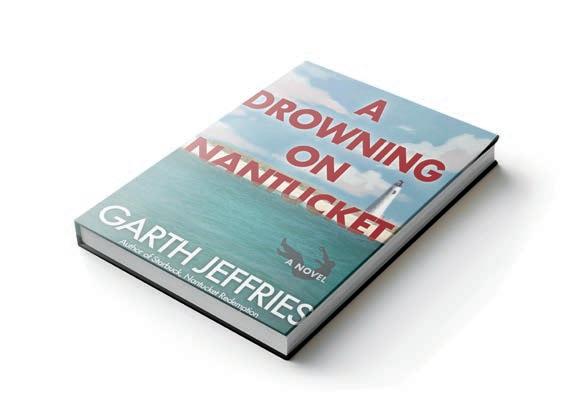
Geo Tolsdorf, writing under the pen name Garth Je ries, recently published his third novel, A Death on Nantucket. What started as a retirement hobby has turned into a second career. His fourth novel is scheduled for release in early 2026. All three of Geo ’s novels are available as eBooks, softcover, or audiobooks wherever you get your books.
I’ve got five new books coming out in 2025 (le )—something for every reader who likes their stories a little off-center and a lot of fun. More at: adamga enauthor.com —Adam Ga en
Pretty Good Year / April 19, 2025, 11:42 am
“I’ve been fortunate to be on faculty at the University of Pittsburgh, first training and then working at UPMC Children’s Hospital of Pittsburgh since 2010. In January, I received my academic promotion to Associate Professor of Plastic Surgery at the University, and was recently named Vice Chief of Pediatric Plastic Surgery. I am the Director for Pediatric hand, upper extremity, and brachial plexus surgery at CHP, and love every minute of it. Most days are not like work at all, and I recognize how much of a privilege it is to feel like that, especially mid-career! Unfortunately, all of this work means I can’t make our 35th this year, but will hopefully be there at our 40th!” —Alex Davit ’90
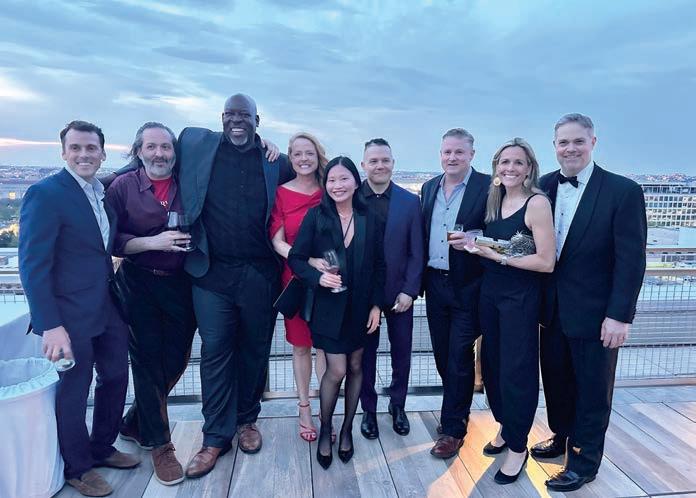
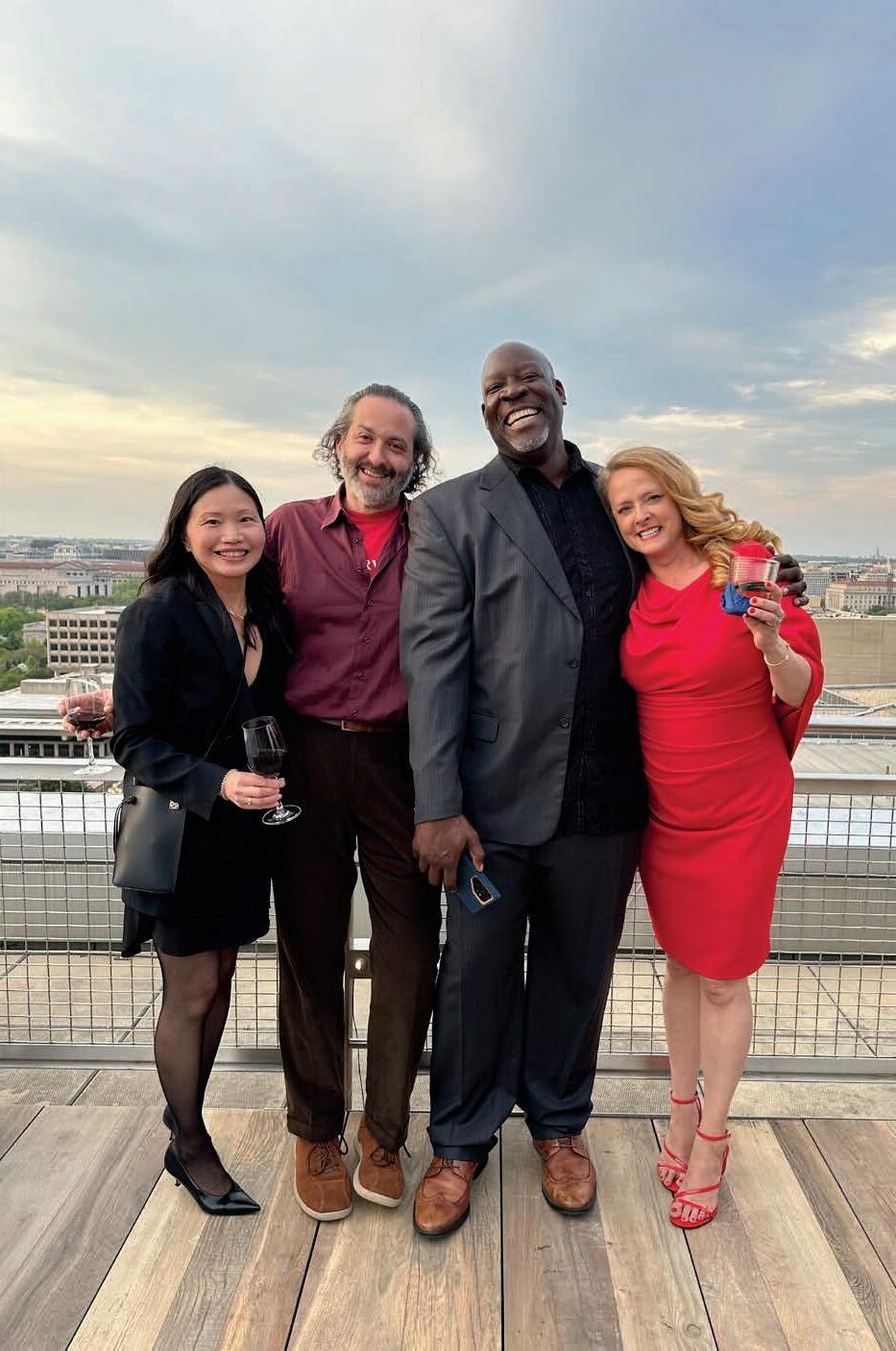
An amazing group of Deerfielders from multiple class years attending Melanie Corcoran’s 50th Birthday party at the Spy museum. Michelle Lin Greenip ’93, Mark Manning ’93, Jack Chester ’93, Clayton Sullivan ’92, Kelly (KJ) Roman ’92, and Rush McCloy ’92, Brooke McCloy ’95, and Mark Sullivan’89. Deerfield friendships are never-ending— a truly a special part of our everyday lives.
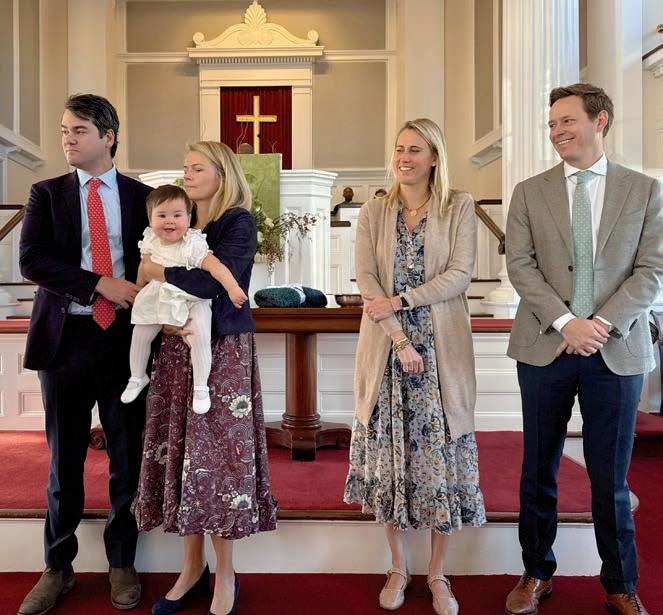
“My husband Tom and I welcomed our daughter, Eliza Bell Decarlo, on December 21, 2023. Our son Thomas, now three and a half years old, is a very proud, big brother. Eliza is also very lucky girl to have Carter Kahle Slattery as her godmother. Our family is settled in New Canaan, and we love seeing many old classmates in the area. I recently joined Klingman & Associates, an independent wealth management firm, where I am a Wealth Advisor to individuals and families.”
Lizzie Decarlo (Reifenheiser) ’02
VP of DEVELOPMENT
/// by Steve Berman ///
Even after almost twenty years, Charlie McSpadden ’06’s bookshelf at home still holds books from his time at Deerfield. “While working on Baz Luhrmann’s The Great Gatsby [as a production assistant], I retrieved my copy replete with notes from Ms. Buron’s junior year English class,” he says, “And I still have the textbook from my senior year’s Hitchcock and Film class.”
It’s little surprise that McSpadden has maintained his ties to the arts and humanities, given their lasting impact during his time at Deerfield. “I was strongest in English, always a favorite class of mine, as was history. I did not play much squash before Deerfield, but after three years, I was ranked fourth in the Academy. I acted in the fall play. I wrote film reviews for The Scroll and was editor of Albany Road. The great thing about Deerfield is that the Academy emphasizes well-roundedness, and I embodied that back then. I think I still embody it now.”
McSpadden started at Deerfield as a tenth grader. “Deerfield is a rigorous place. I was prepared for the academic demands thanks to previously attending a great school in New York, but adjusting to the physical environment was di cult. I remember during junior year being told by the administration not to go outside because it was so cold—minus 20 degrees Fahrenheit!—you couldn’t be outdoors for long without risking frostbite.”
McSpadden, now vice president of development at Levantine Films, began his career in film production working with directors Whit Stillman, Steve McQueen, and Darren Aronofsky. He is especially proud of his latest film, the 2024 romantic comedy A Nice Indian Boy, which Levantine co-financed and McSpadden helped shepherd creatively from start to finish, finding the play upon which it was based, hiring screenwriter Eric Randall to adapt, and securing director Roshan Sethi.
In his search for stories that resonated personally, he was drawn to the project for o ering a fresh take on gay identity, one that sidestepped the usual coming-out clichés. The film, starring Karan Soni and Jonathan Gro , received widespread acclaim. The New York Times praised it as “a vibrant addition to cinema’s romantic landscape,” noting that “love isn’t the only winner: cultural understanding and the freedom to choose your own path triumph as well.”





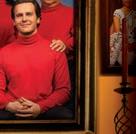
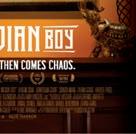


A Nice Indian Boy is now available to rent or buy on Apple and Amazon or stream on Hulu.
McSpadden remembers, “During our sophomore year, my close friend and classmate Matt Cuneo and I started making short films together. Matt directed, we both wrote, and I played the lead. I have no idea if those old projects still exist—maybe buried on one of Matt’s hard drives—but that first film stands out. We won Best Picture at the very first Deerfield student film festival. Fewer than ten films were entered, so we weren’t exactly Cannes contenders—but it gave me a creative confidence I’ve carried with me ever since.”
After graduation, McSpadden attended Duke University to study English with a minor in visual studies. “To be quite honest—and I loved my time at Duke—but when I arrived, it felt like a walk in the park compared to Deerfield. Many of my peers were having di culty adjusting to living on their own, while at Deerfield, I had already matured so much.”
McSpadden appreciates that Deerfield remains a face-to-face community and learning environment—a value actively supported by Head of School John Austin and the school’s leadership. It reminds him of his own experience at the Academy, where limited access to technology helped instill habits of focus and discipline.
“When I was there, my cell phone didn’t work because there was no service, and the Internet shut o in certain dorms at specific times. I almost wish today’s world still had such limitations— it taught me boundaries. I’m much more e cient because of it. My job requires me to hunt for stories, and if I didn’t have the presence of mind to disconnect, I wouldn’t be nearly as successful.”
When asked what other skills from Deerfield still serve him today, McSpadden doesn’t hesitate. He points to his strong work ethic, and the discipline to structure his time—tools that also prepared him for problem-solving and independence and continue to shape his professional life. He also reflects on the lasting influence of sit-down meals, one of the Academy’s most treasured traditions. Serving as a first or second waiter taught him responsibility, while being seated with peers he didn’t know sparked a lifelong curiosity about other people’s personalities and perspectives. “Recently, I was at a brunch put on by the British Film Commission where the conversation revolved around explaining the new tax incentives, and I realized I didn’t know a single person there,” he recalls. “But it reminded me of the Deerfield dining hall, and I was able to jump in—engage, find common ground, and make real connections.” //
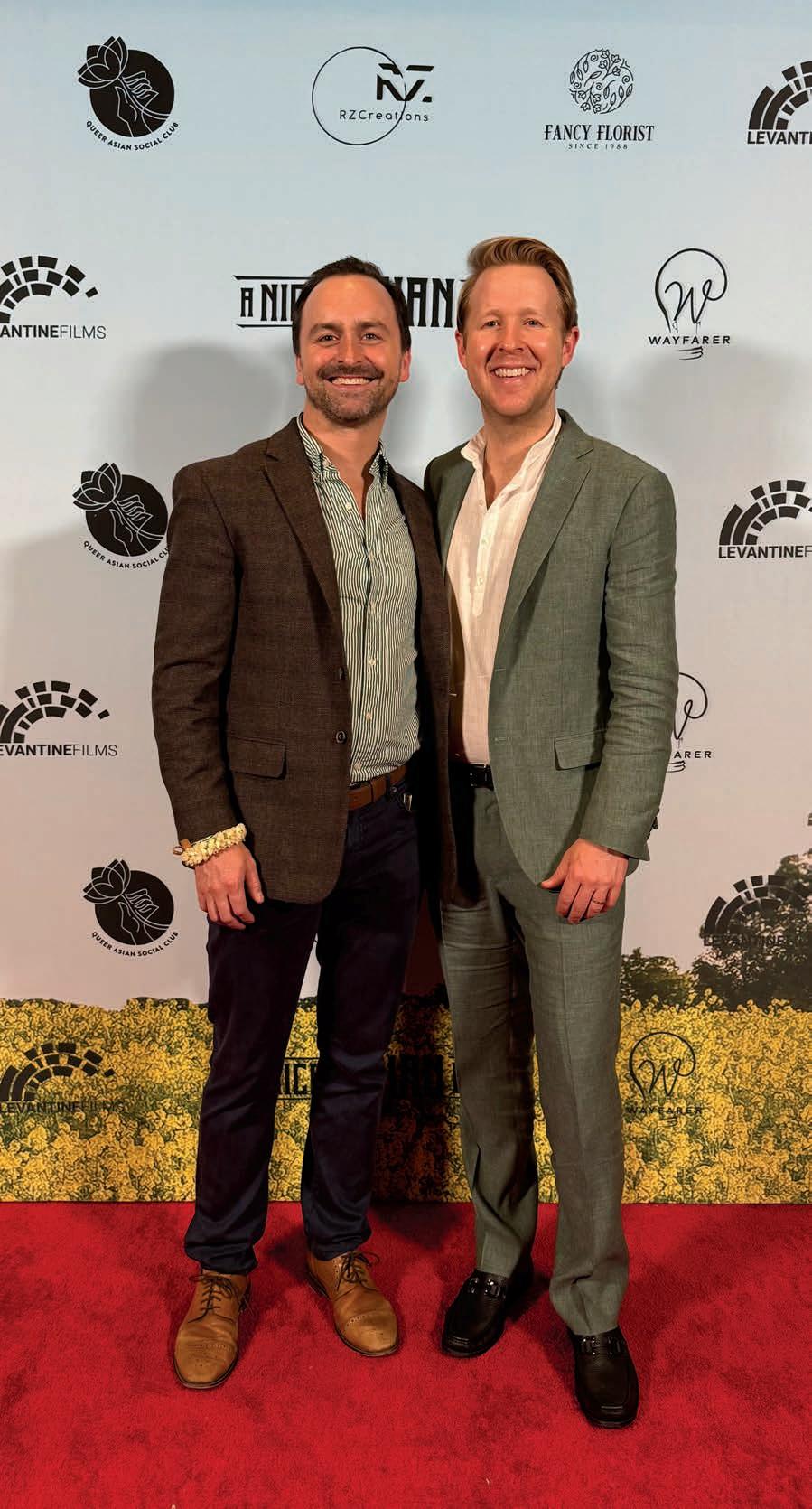
During our sophomore year, my close friend and classmate Matt Cuneo and I started making short films together. Matt directed, we both wrote, and I played the lead. I have no idea if those old projects still exist—maybe buried on one of Matt’s hard drives—but that first film stands out. We won Best Picture at the very first Deerfield student film festival. Fewer than ten films were entered, so we weren’t exactly Cannes contenders—but it gave me a creative confidence I’ve carried with me ever since.

Siblings Alina ’17 and Tim ’20 O’Brien have completed the climb of Mount Kilimanjaro in December. THE COMMON ROOM
Recently Meghana Vunnamadala ’12 married Bradford George Koenitzer in Newport Beach, California. She was joined by several Deerfield alumni, including Amy Li ’12, Alexsys Leija ’12, and Yujin Nam ’11.



“I am excited to announce that I am the Assistant Graphic Designer for Girls Crewcuts! Keep an eye out for my illustrations on J.Crew clothing in the coming months! Here’s the view from the co ee machine on the 21st floor, where our o ces are located.” —Piper Day ’21

Congratulations to Elic Ayomanor ’22 on making it into the NFL!
May 3, 2025 - January 4, 2026
HISTORIC DEERFIELD / FLYNT CENTER OF EARLY NEW ENGLAND LIFE
37 OLD MAIN STREET DEERFIELD, MA 01342
Historic Deerfield presents a new exhibition, Envisioning America: Deerfield Academy’s Collection of Paintings and Drawings, which highlights significant works of art from the Academy’s collection, many of which have not been on public view for decades. The Academy possesses a rich collection of American art, ranging from colonial American portraiture to early 20th-century modernism.
Tickets and information: historic-deerfield.org




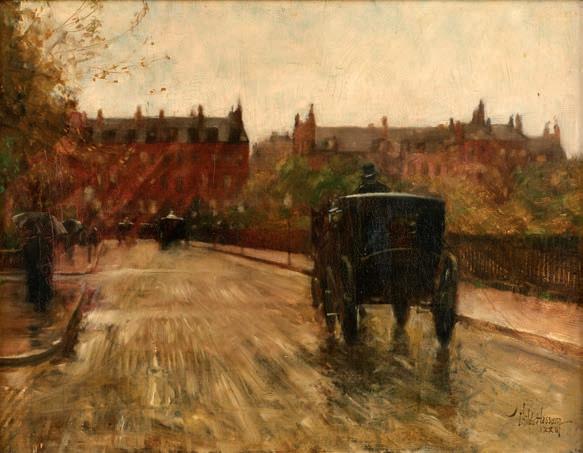


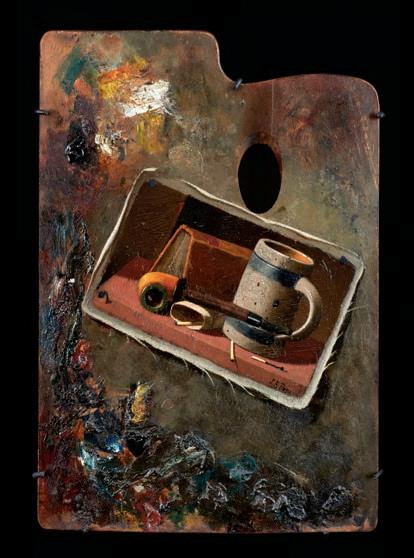


Eastman
John
Childe
William







































Longtime Academy Classics teacher Peter Brush died on December 17, 2024, at the Charlene Manor Extended Care Facility in Greenfield, MA, following a brief period of declining health. A private family burial was held at Laurel Hill Cemetery in Deerfield, and plans for a memorial service are still underway as of the summer of 2025.
Hired by Frank L. Boyden in 1966, Peter retired from Deerfield in 2009. In addition to teaching Latin, for decades he coached the Academy’s Cross Country team, beginning in 1966 with the Thirds team. Beyond instilling an enduring love for the classics in his students—many of whom went on to study them in college—Peter also served as a mentor to fellow faculty members over the years, including current Deerfield teacher and coach Cheri Calcaterra.
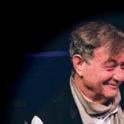



Academy Trustee Emeritus and 2017 Heritage Award Recipient Alan Hassenfeld ’66 died peacefully in his sleep in London on July 9, 2025. He was 76.
According to an obituary published in The Providence (RI) Journal, Alan was born on November 16, 1948, into the founding family of Hasbro. He became CEO in 1989 following the untimely death of his brother, Stephen. Though initially reluctant to lead, he transformed the company into an industry powerhouse. Under his stewardship, Hasbro acquired Tonka Parker Kenner bringing iconic brands Play-Doh, Monopoly, and Nerf into its portfolio and elevating it to #169 on the Fortune 500.
Alan’s true legacy, however, lies in his profound humanitarian spirit. He championed corporate social responsibility, product safety, and he worked to eliminate the use of child labor in toy industry manufacturing. His compassion was most vividly expressed through philanthropy. He spearheaded the founding of Hasbro Children’s Hospital in Providence (1994), a landmark achievement funded partly by his leadership and a $2.5 million personal donation. In 2008, he established the Hassenfeld Family Initiatives, supporting countless causes focused on children, education, health, and social justice worldwide. His guiding principle was simple yet profound: “Bring sunshine where there’s darkness.”
“When I arrived at Deerfield, Peter was already 33 years into his tenure! I was fortunate to share the Kendall Classroom Building with him for his final ten years at Deerfield, and I was even more fortunate to have the opportunity to coach alongside him in Track and Field during those years. Working with such a longtime professional was such a blessing for me as a new teacher and coach; he demonstrated to me that living with, coaching, advising, dining with, driving, and teaching Deerfield students would form some of my fondest memories and would also become a huge source of personal and professional fulfillment. I was especially blessed to see my friendship with Peter grow beyond his retirement, as he continued to come and support all of DA’s Track and Field and Cross Country meets—still bringing bushels of apples to our home opener for XC every year!”
Peter is survived by his brother, Sam Brush, and his sister, Susan Brush.
Alan was also a civic force. He founded “Right Now!”, a successful Rhode Island ethics and campaign finance reform movement. He fostered a culture of giving at Hasbro, pioneering employee volunteer programs “Team Hasbro” and “Global Day of Joy.”
At Deerfield, in addition to serving as a trustee from 1995 to 2006, Alan was presented with the Heritage Award in 2017, which is given to an alumnus or alumna whose professional and personal achievements contribute to the betterment of society. His award read in part: Your hands-on leadership and tireless energy have inspired other corporate executives, and those in the not-for-profit world, improving the lives of people across the globe. Your interests and commitments are as varied as they are meaningful. You established the Hassenfeld Family Innovation Center at Brandeis University. You have served on the Dean’s Council of Harvard University’s Kennedy School of Government and the Board of Directors of the Brown University medical school. You are a Director of the Jewish Alliance of Greater Rhode Island, and a former Chairman of the Right Now! Coalition. You have been inducted into four halls of fame, received numerous honorary doctorate degrees, and have been recognized by civic, religious, and business organizations for your generous spirit and extraordinary philanthropy. In a life defined by accomplishment and devotion to others, you exemplify the Academy’s motto, Be Worthy of Your Heritage. Deerfield is proud to count you among its alumni and honored to present you with the Heritage Award.
Alan is survived by his wife, Vivien; stepchildren Karim and Leila Azar; sister Ellen Block; nieces Susan Block Casdin and Laurie Block; nephew Michael Block; grandchildren Chloe, Talullah, Kaia, and Khalil; and grand-nephews Kinsey and Blaisdell Casdin. A service was held in Rhode Island on July 20.

1941
Andrew Price Jr.
October 20, 2023
1943
Stephen E. Upton
December 27, 2022
1944
Paul A. Frank Jr.
April 6, 2025

1951
Sherwood L. Anderson
February 7, 2025

1957
William Grifith Couser
February 24, 2025
1970
Peter B. Neville Sr.

June 13, 2025

Charles W. Hallagan
November 9, 2024

Franklin H. Pond*
March 8, 2025
1946
Henry Shields Day
February 27, 2025
William C. Harrop
June 6, 2025
1948

Nathaniel R. Bowditch
May 3, 2025
Willard A. Fry*
April 30, 2025
Peter H. Gulick
November 29, 2023
1952
Robert Andrew Anderson
March 31, 2025
John W. Bliss
March 25, 2025

Thomas I. Unterberg*
January 10, 2023

Peter R. Vail
December 28, 2024
1949
Donald R. Dwight
May 4, 2025

Harvey Battell Loomis
March 20, 2025
Douglas Warren Martin
February 11, 2025
1950
Robert D. Pedigree
April 22, 2025
Timothy W. Goodrich III
April 9, 2025
Richard W. Hallagan
February 14, 2025

June 1, 2025
1953
O. Robert Conkey
December 23, 2024
J. Nicholas Edwards
December 9, 2023
1954
Robert C. Fulton III
May 5, 2025
Charles T. Lipscomb III
April 27, 2022
1958
Edwin B. Cragin Jr.
March 9, 2025

1959

Warren B. Lammert, Jr
1971

William H. Boardman Jr.*
February 18, 2025
Stephen E. Chalmers
April 1, 2025
David M. Childs
March 26, 2025
1960
Talbot Shelton Jr.
May 1, 2023
1961

David J. Nieskoski
January 27, 2024
1972

J. Patrick McLaughlin
July 14, 2023
1974
Keith F. Baity
March 25, 2025
1975
Frederic J. Valles
February 16, 2018
1978
Patrick T. Collins
April 10, 2025
1989
D. Chase Sheridan

March 9, 2025
1990

Randolph Ernest Suhl Jr.*
March 23, 2025
1964
Peter W. Healey
November 26, 2024
1966


Laurance B. Nilsen
March 17, 2025
1955
Michael B. Mayor
March 31, 2025
1956
Christopher S. Bond
May 13, 2025
John D. Marsellus*
June 2025

Dean J. Conway
March 9, 2025
Teri Noel Towe
February 3, 2025
1967
Lon C. Hill, IV
March 29, 2023
1968

February 15, 2025

Daniel J. McCarthy
June 17, 2025
1991
Marshall S. Hildebrand
May 2025
1997
M. Blair Hansen
February 5, 2025

Dominic Paul DiMaggio Jr.

* Boyden Society Member In Memoriam as of July, 2025.
Please go to: deerfield.edu/edu/commonroom for the most up-to-date information on classmates, including obituaries.



Alexandra Carter + Food Writing: A one-term elective, Food Writing offered a taste of this vast genre. Together, Dr. Carter and her students sampled works from famous chefs, such as Julia Child and Anthony Bourdain; cultural critics, including Michael Pollan, Carmen Maria Machado, and Roxane Gay; and novelists and poets, such as Maxine Hong Kingston, Margaret Atwood, and George Orwell. In the process, they approached food as a mode of creative expression and as a vehicle for understanding ourselves and the world around us. Through food, they interrogated questions of race, social class, gender, migration, family, history, and love. They wrote often and across genres (recipes, personal narratives, reviews, profiles) and enjoyed opportunities to go into the field and learn about the local food industry of the Pioneer Valley. Here is a sampling of recipes students cooked up in their dorms!















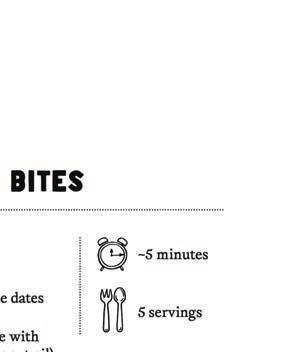






















1982 Debate Hardware from the extensive Deerfield Academy Debate Trophy Collection

First Annual Extemporaneous Debate judge’s score sheet: Deerfield vs Choate 1975. Deerfield wins, of course!


CAMPUS UPDATES: PAGE 22
